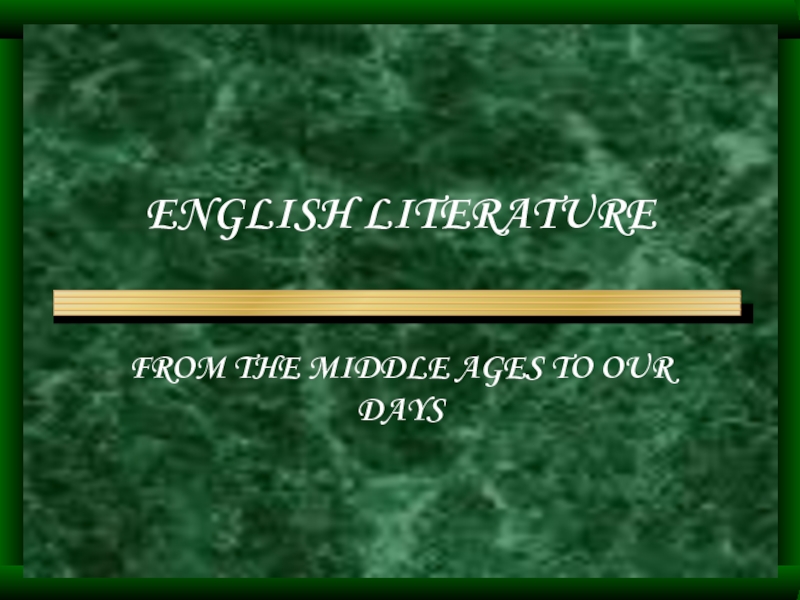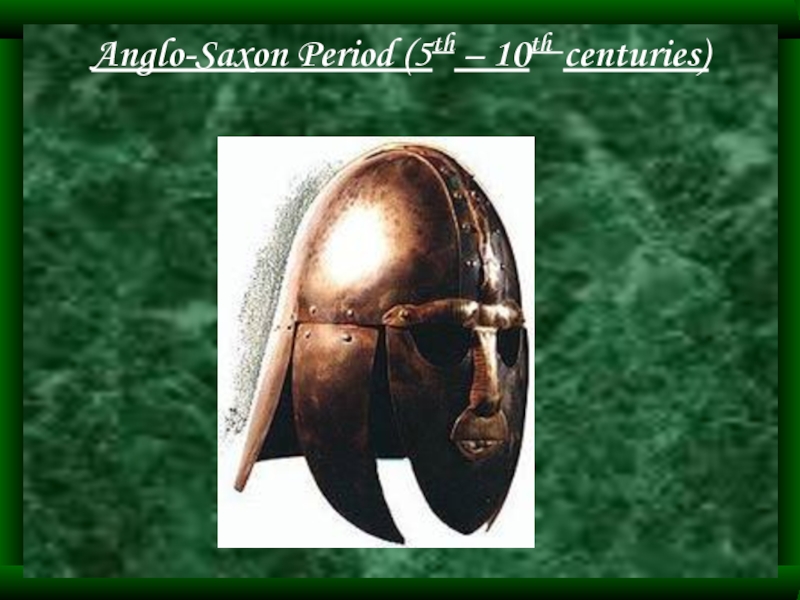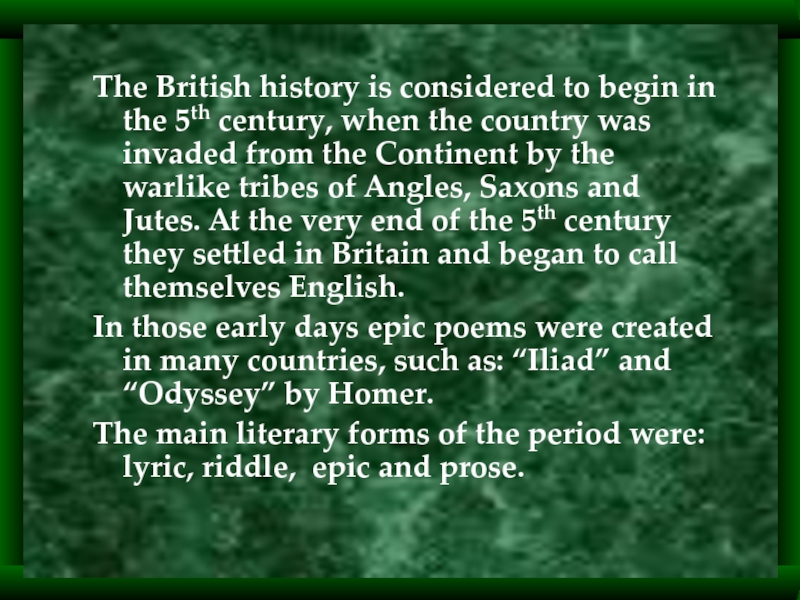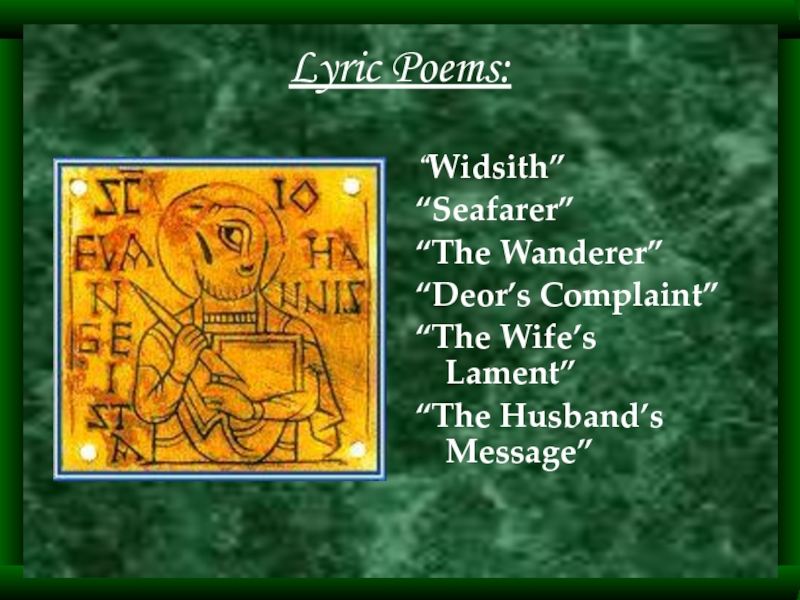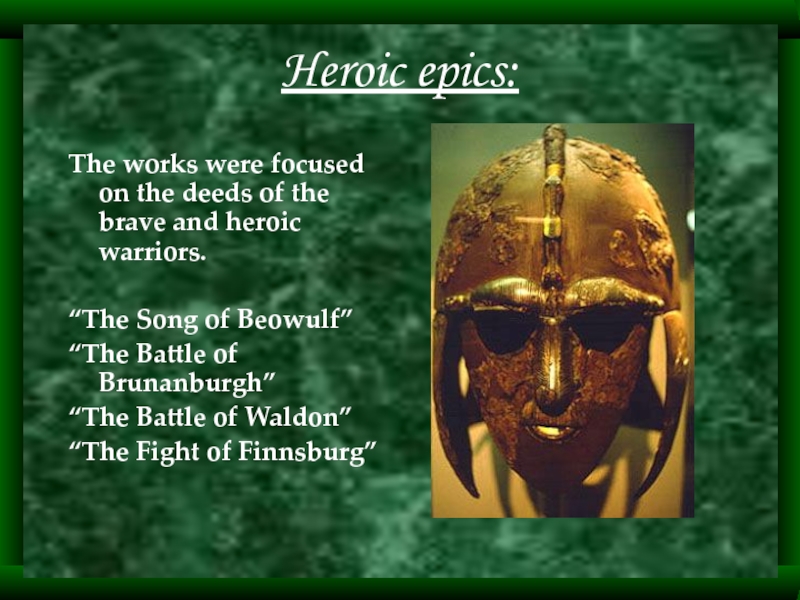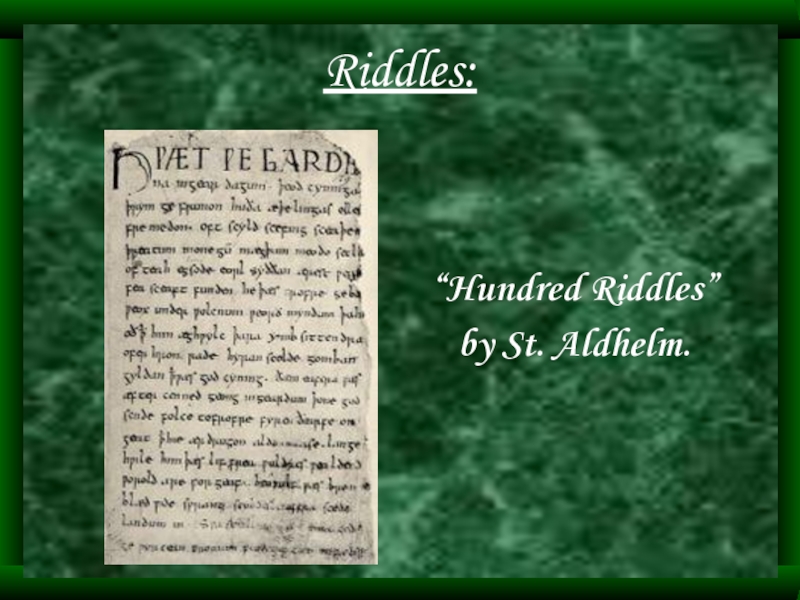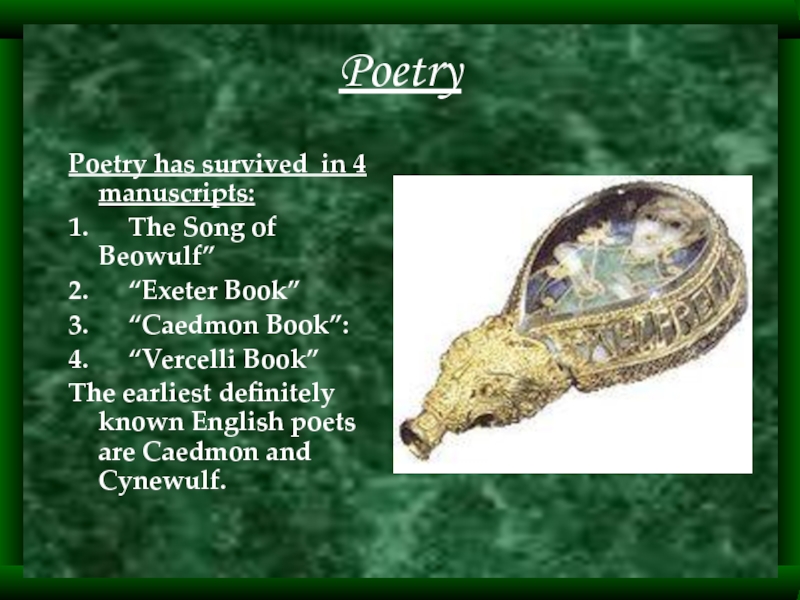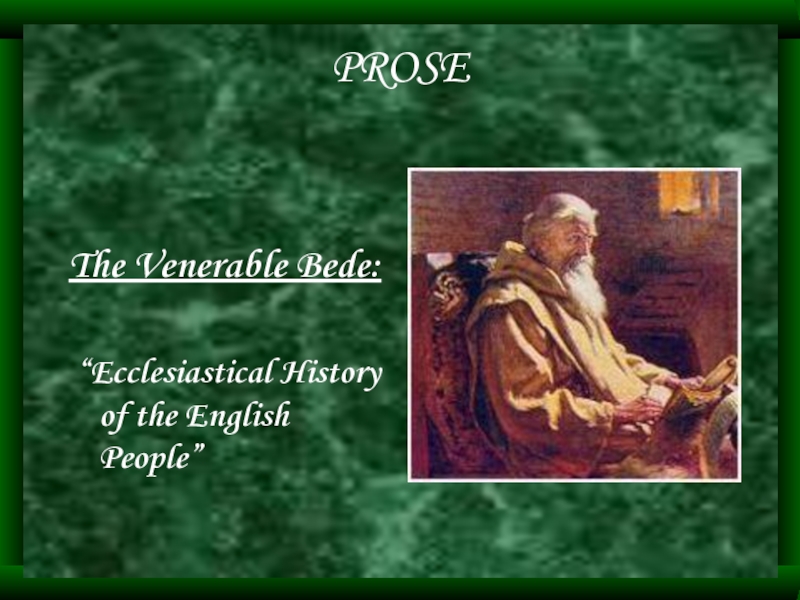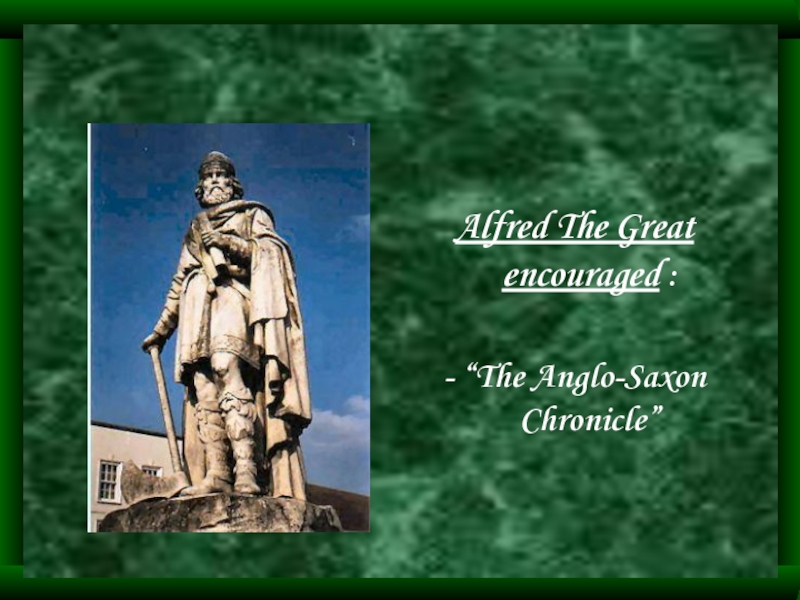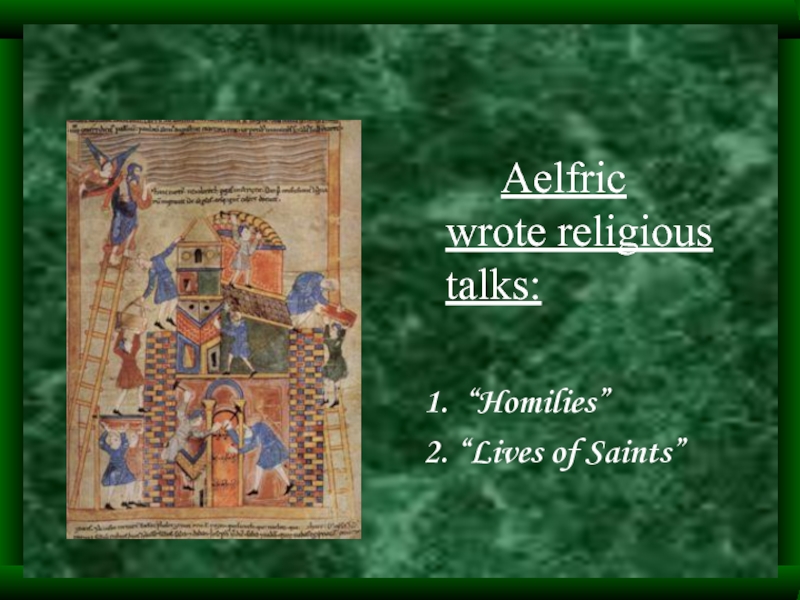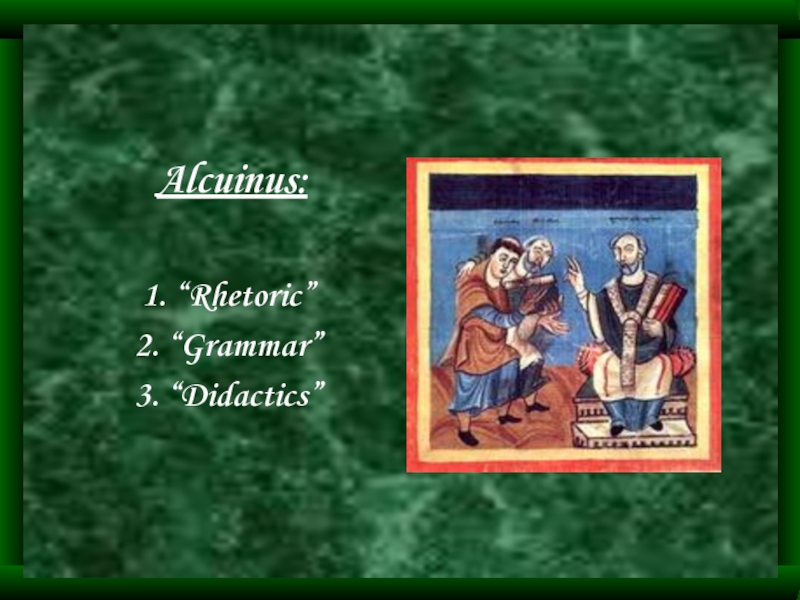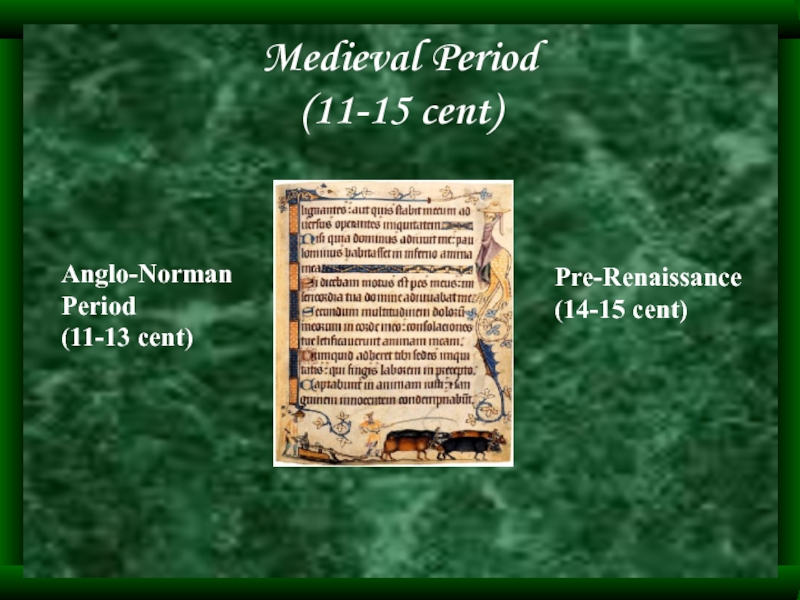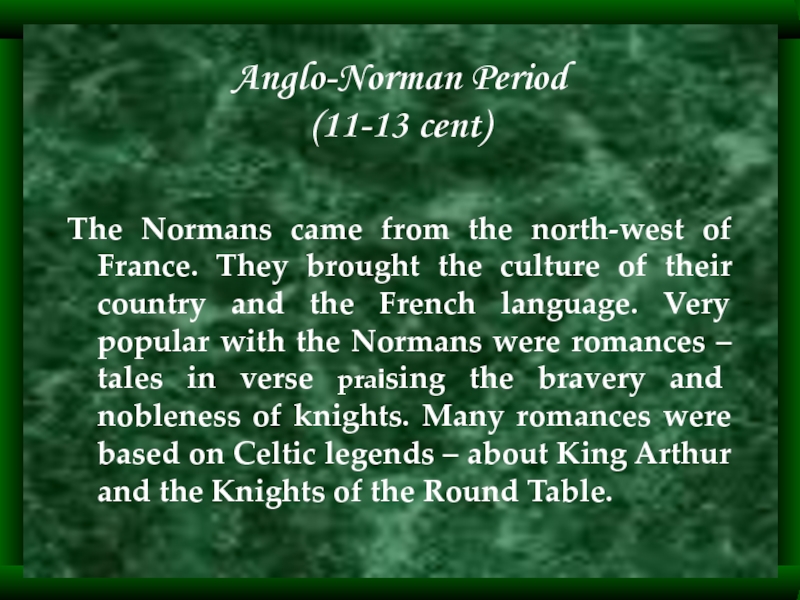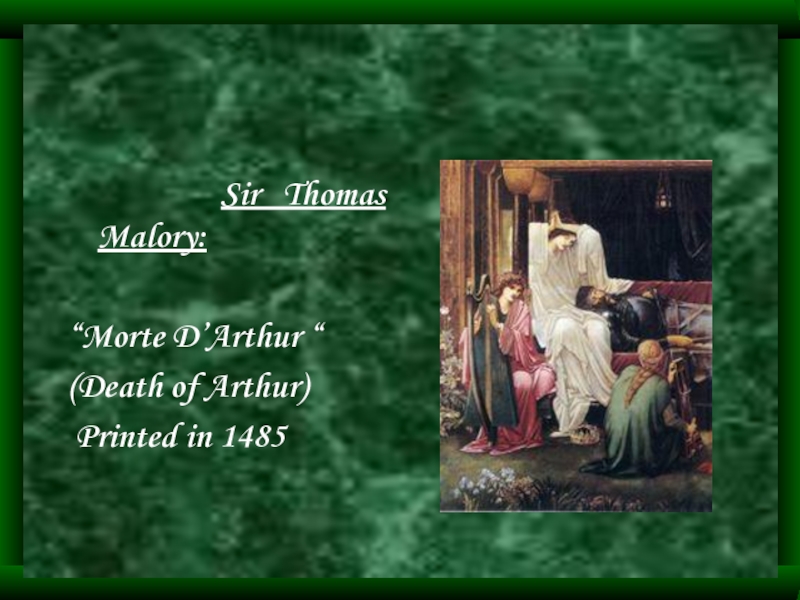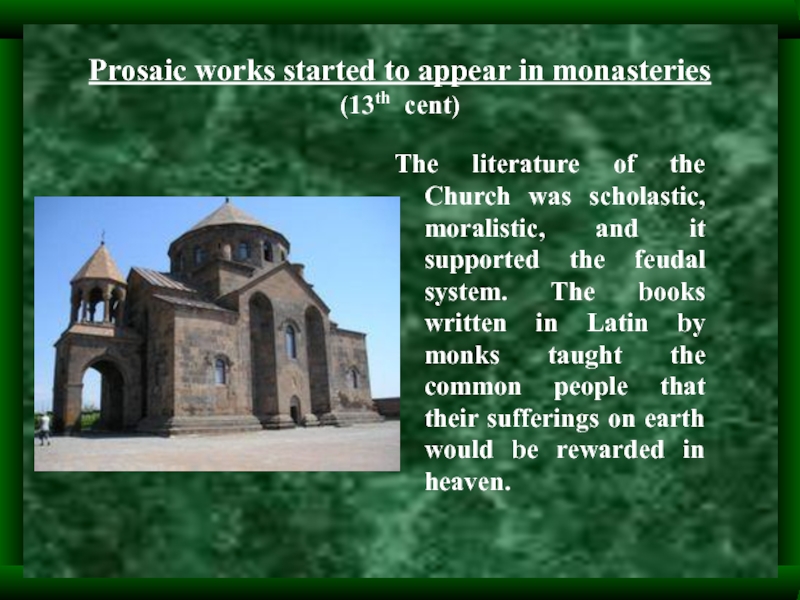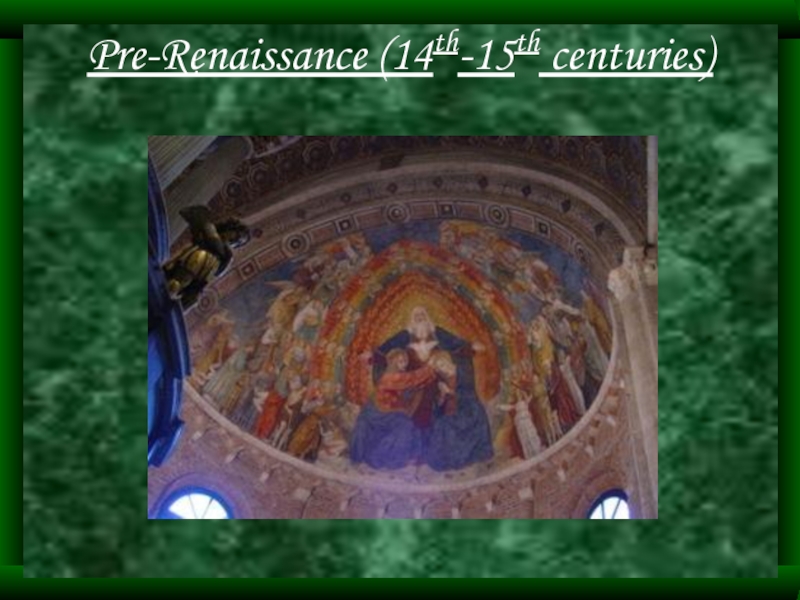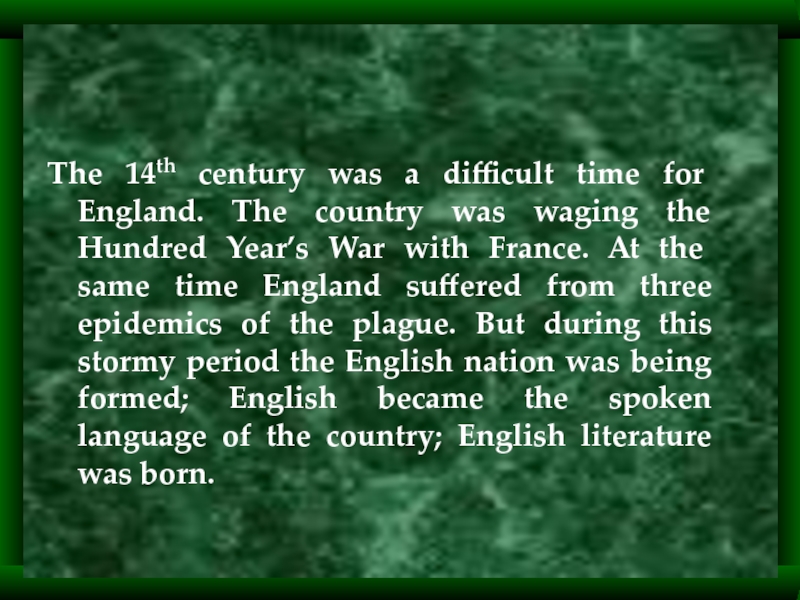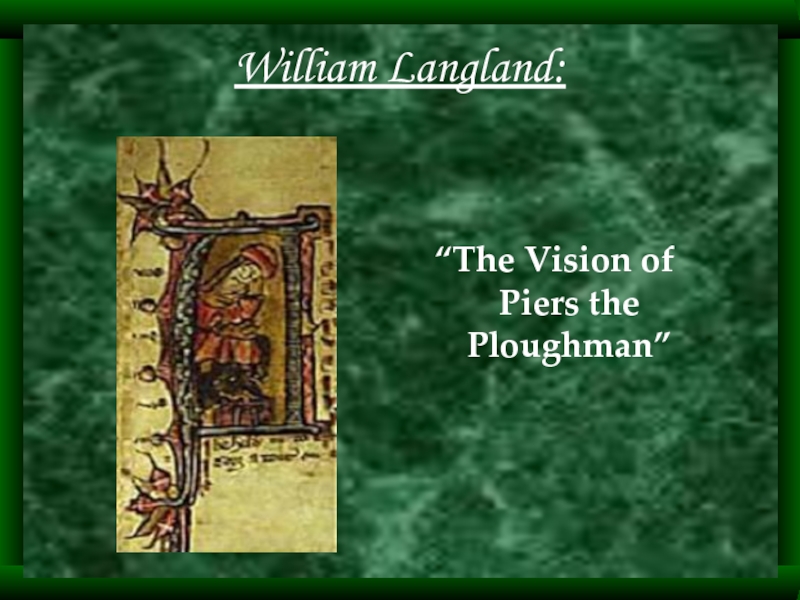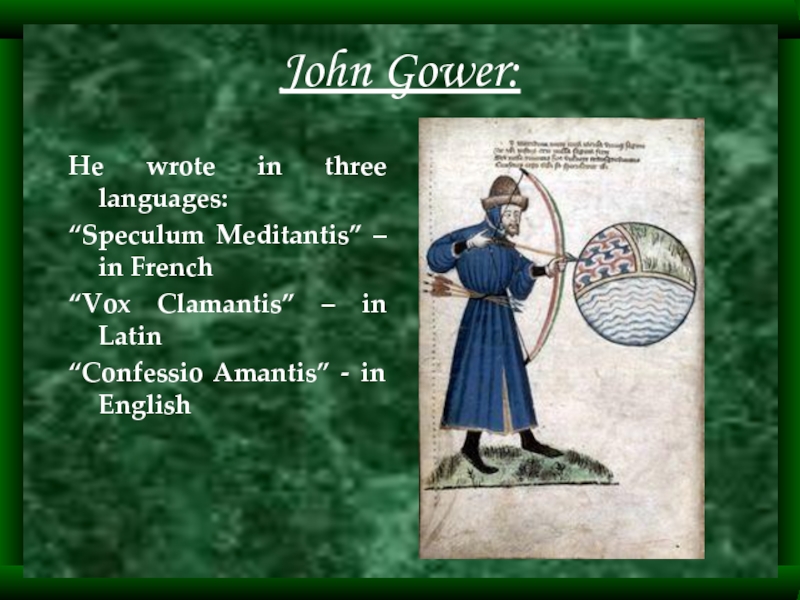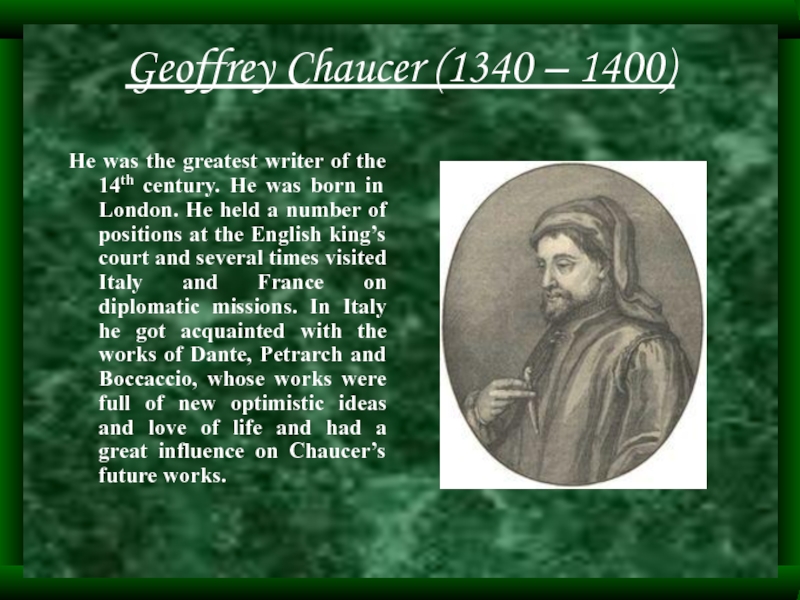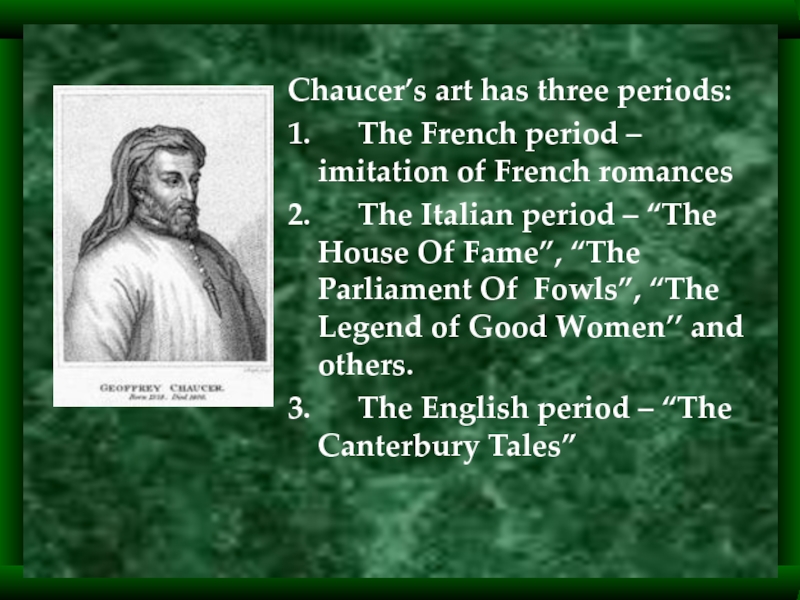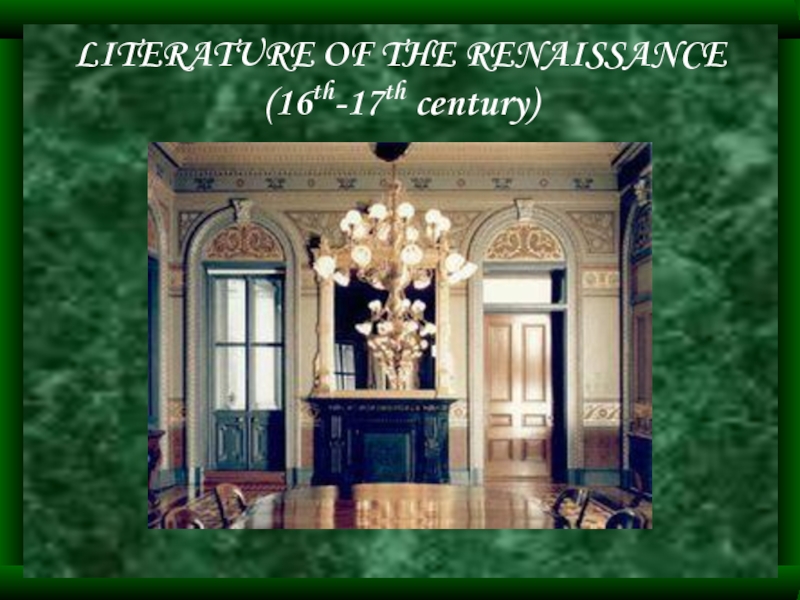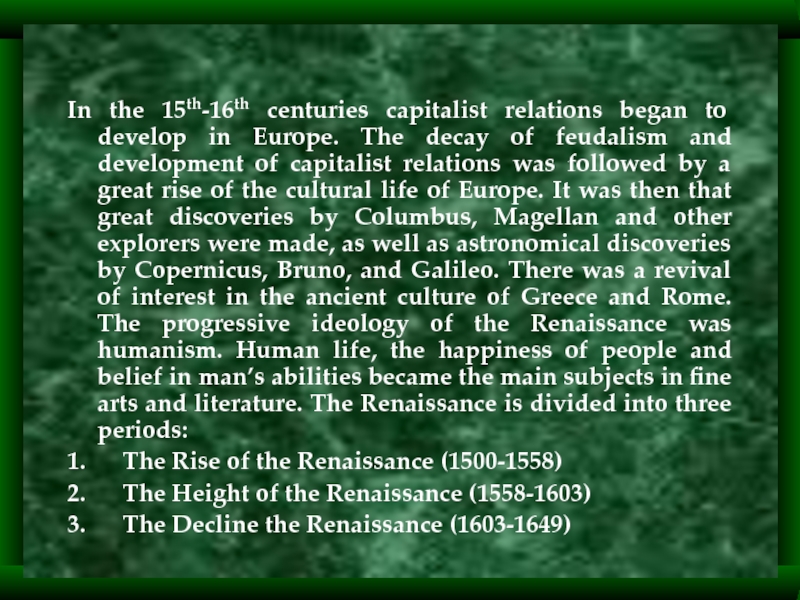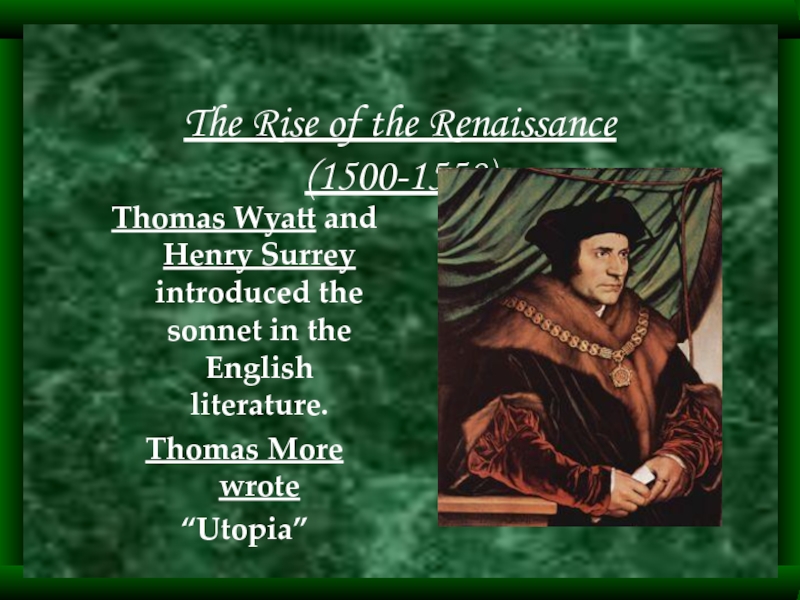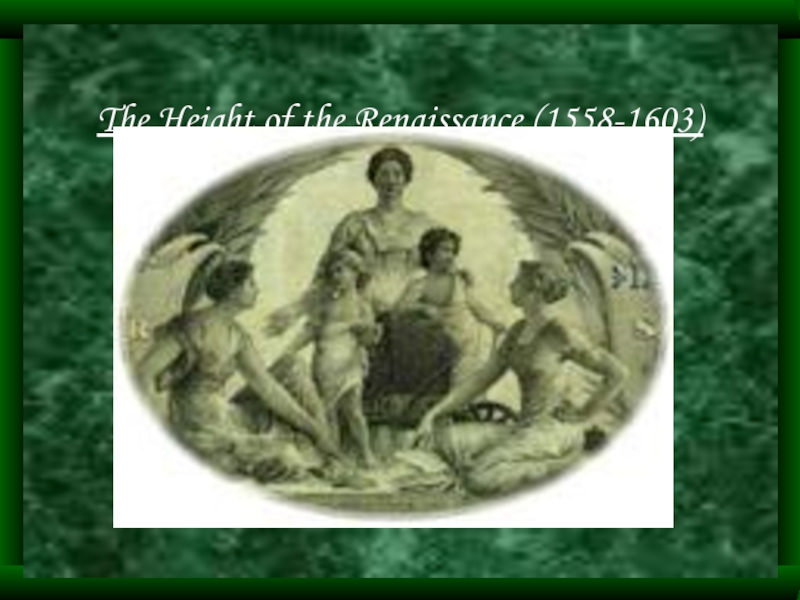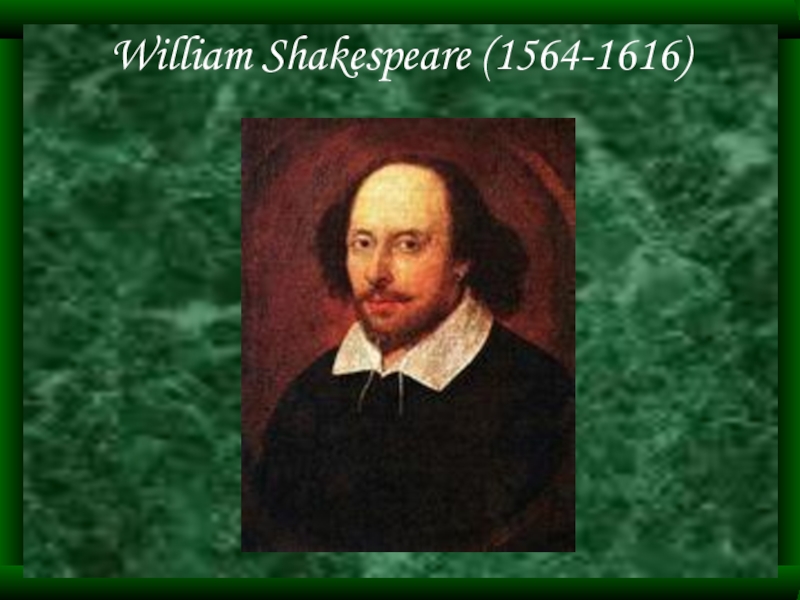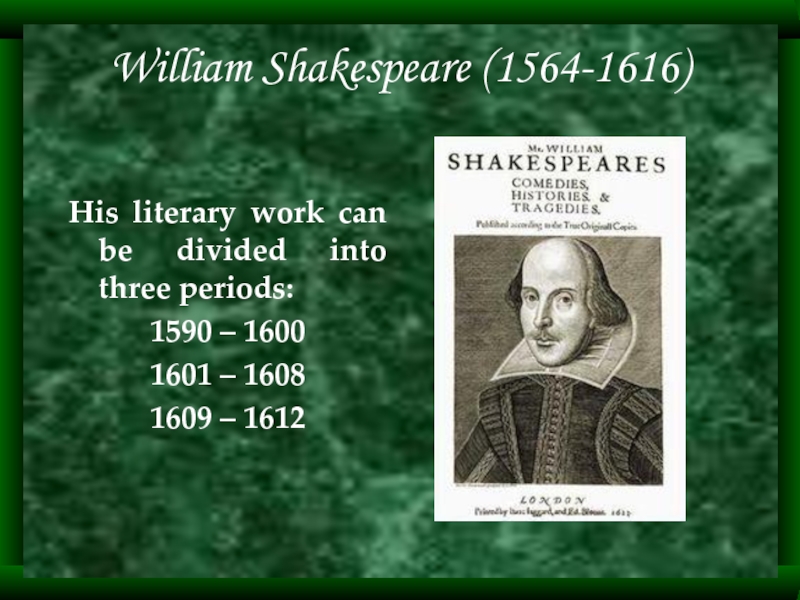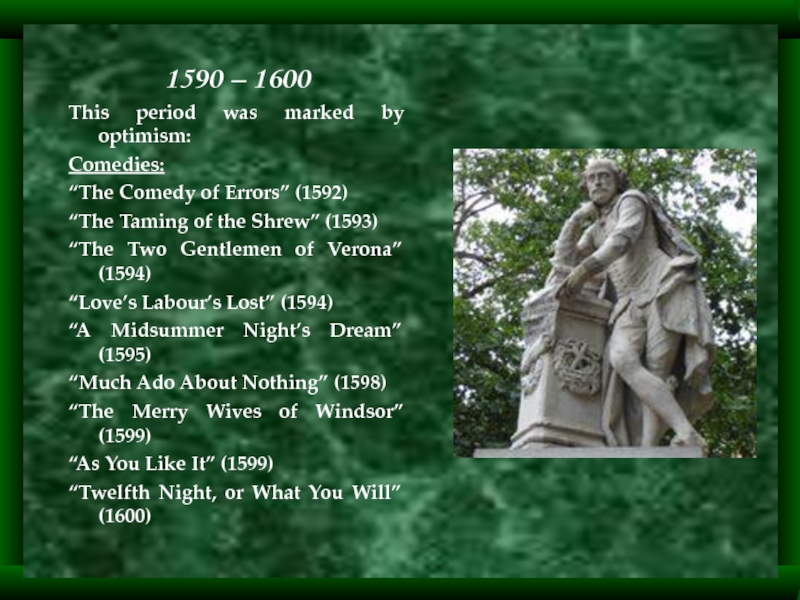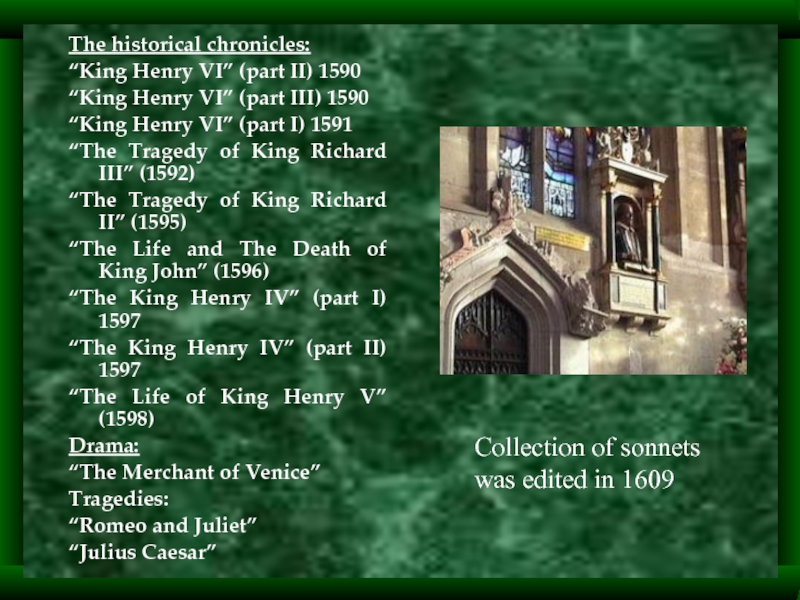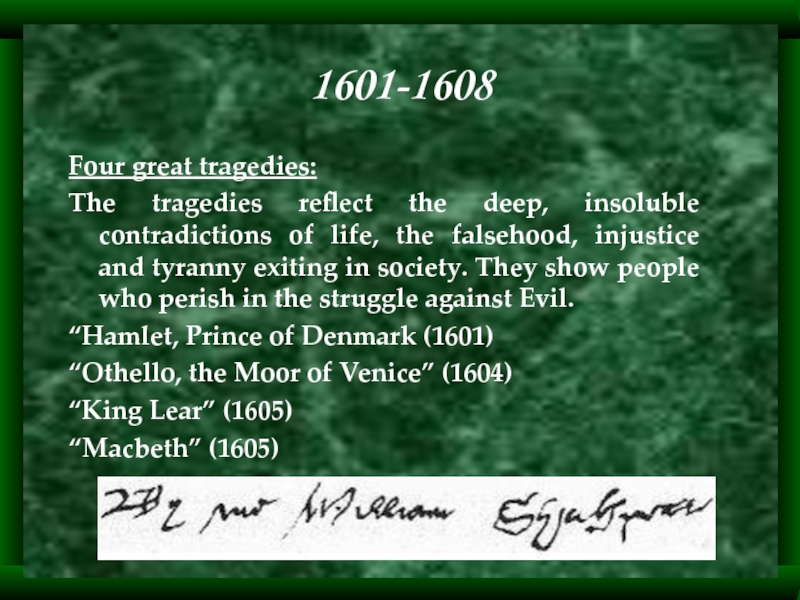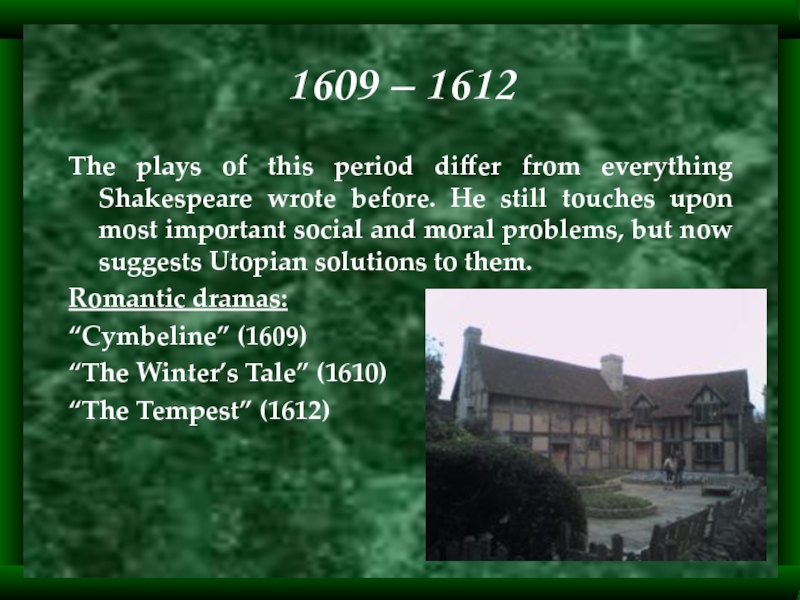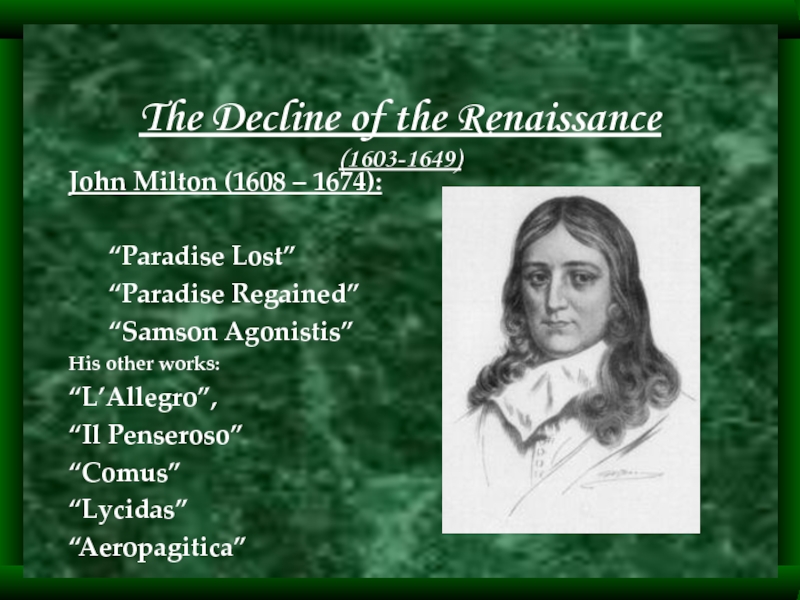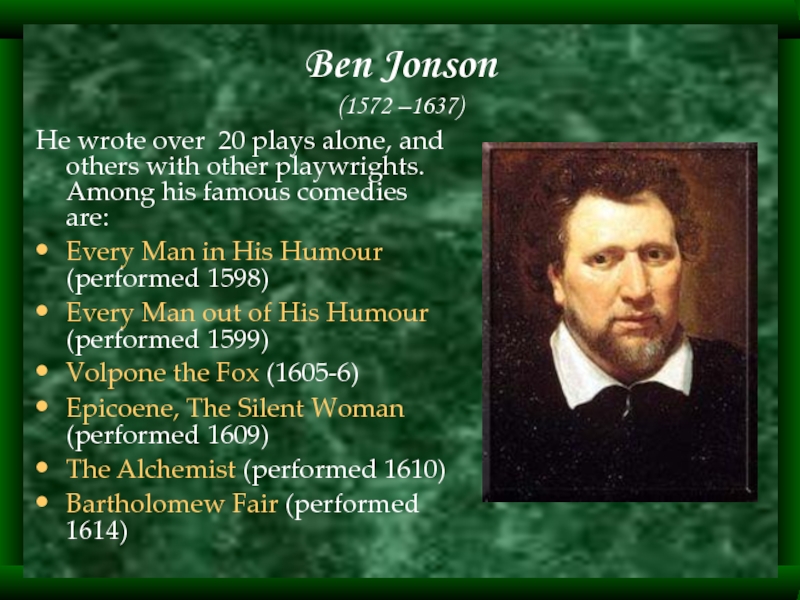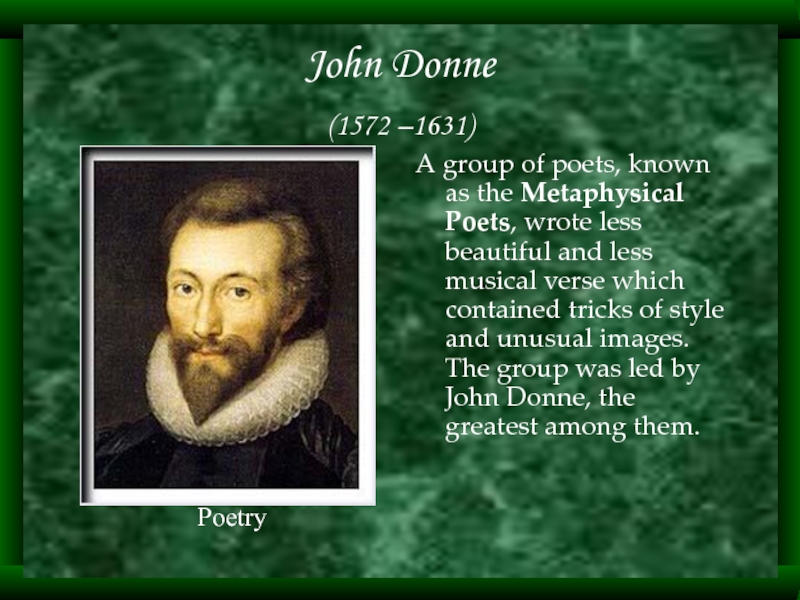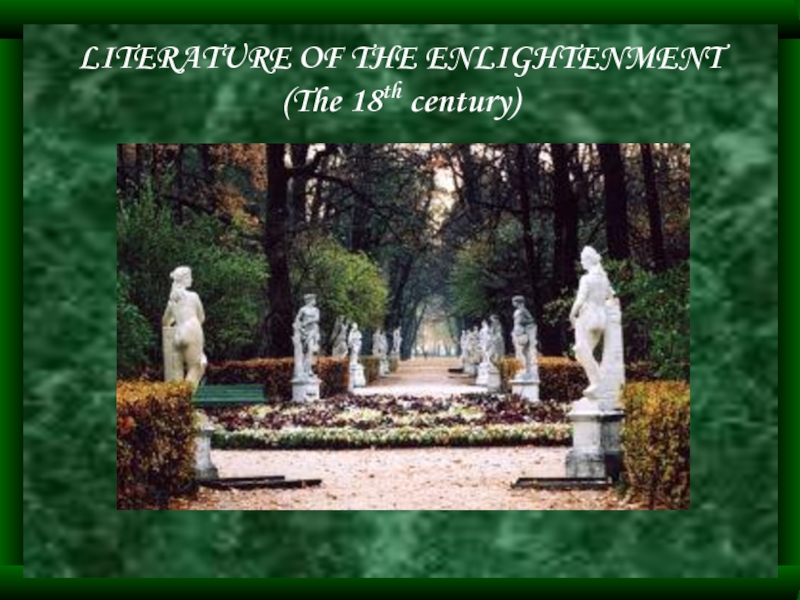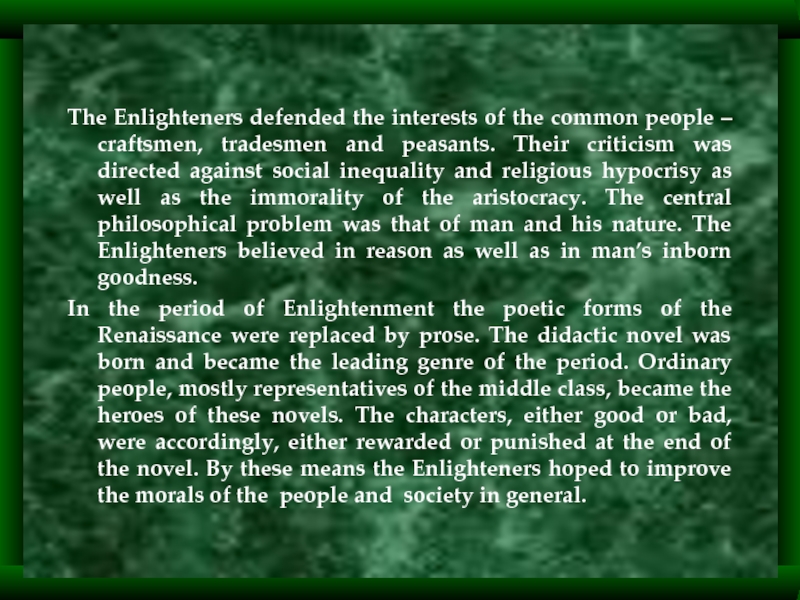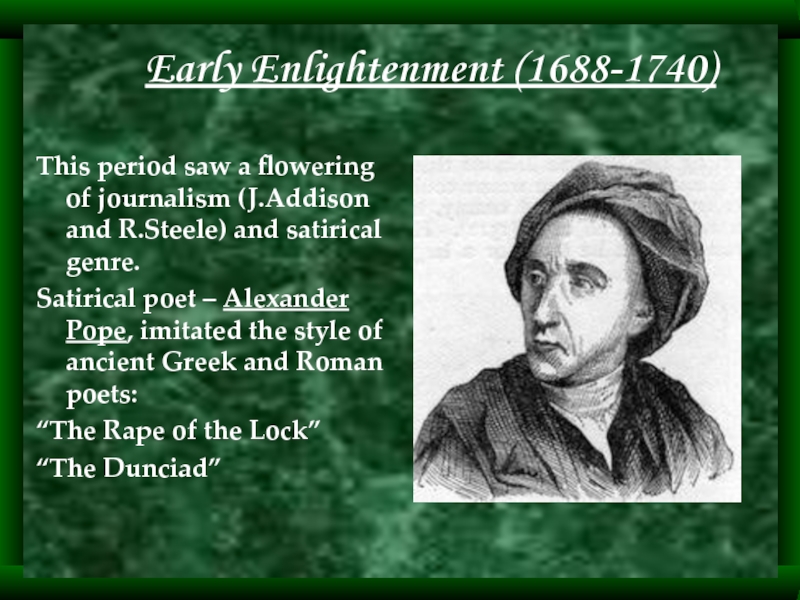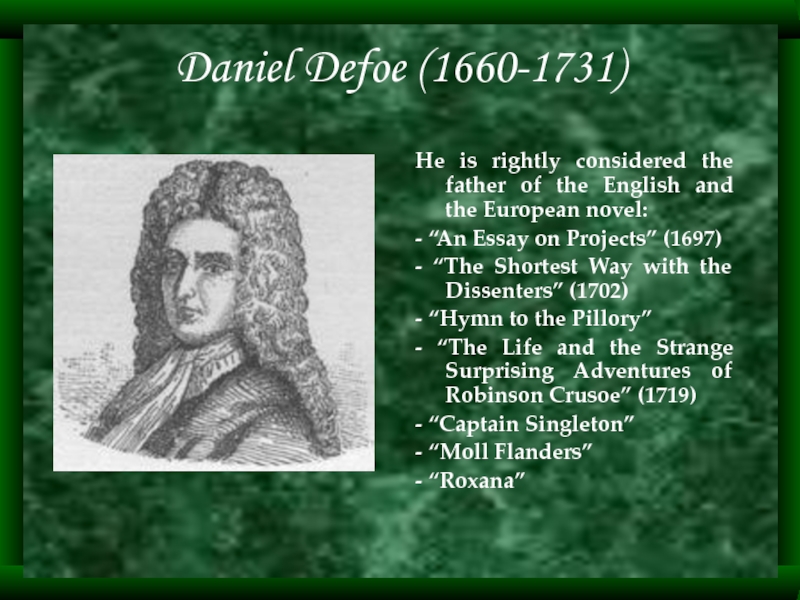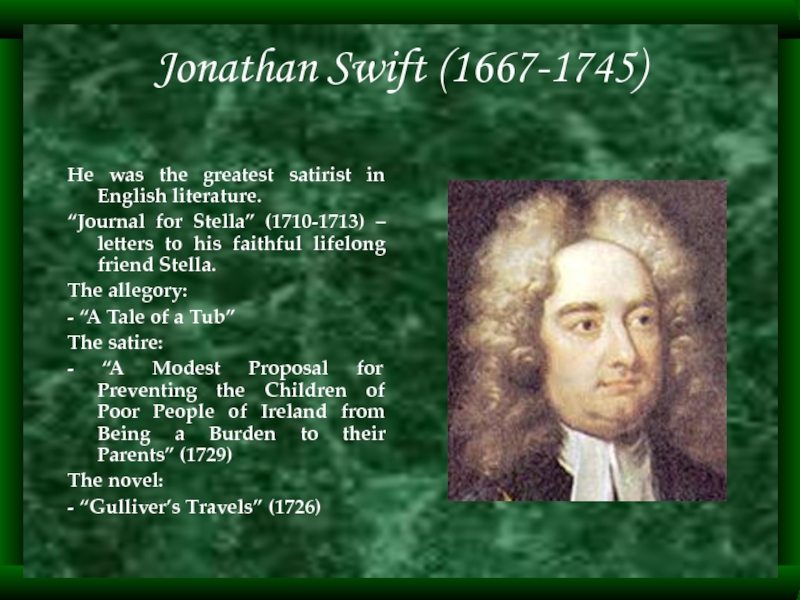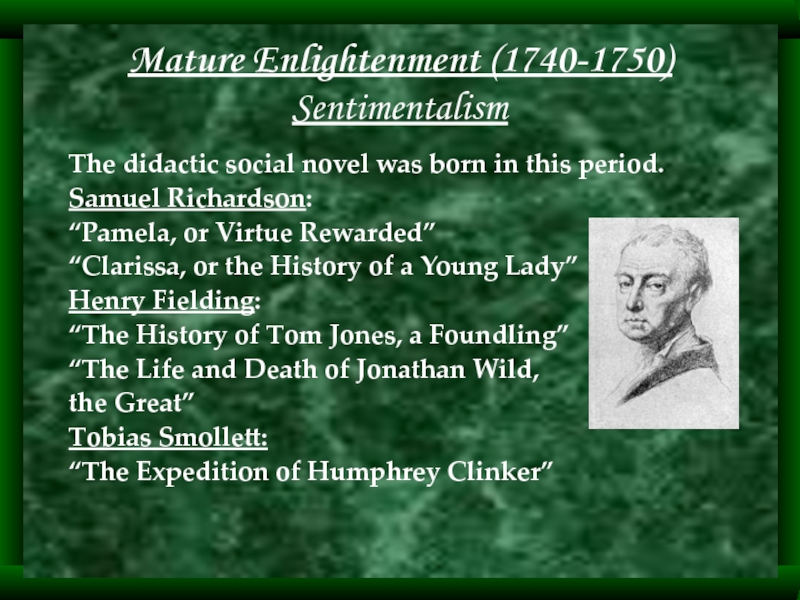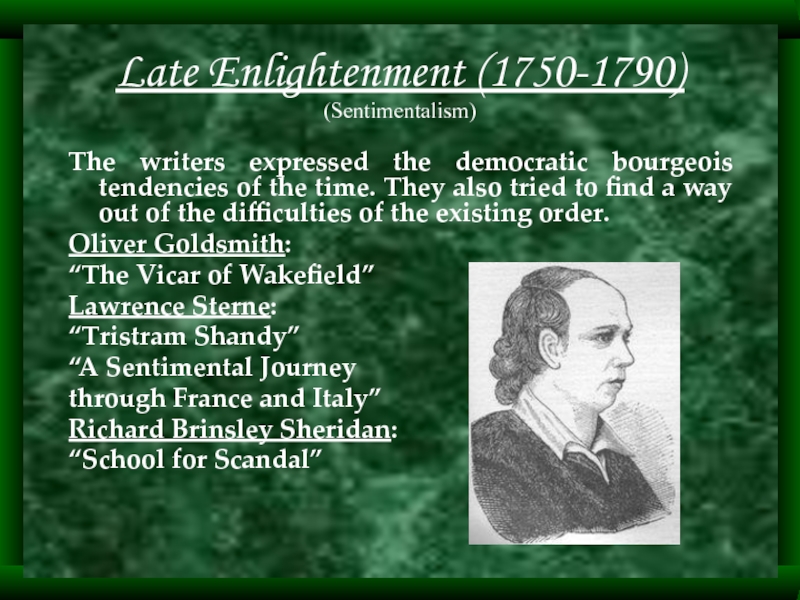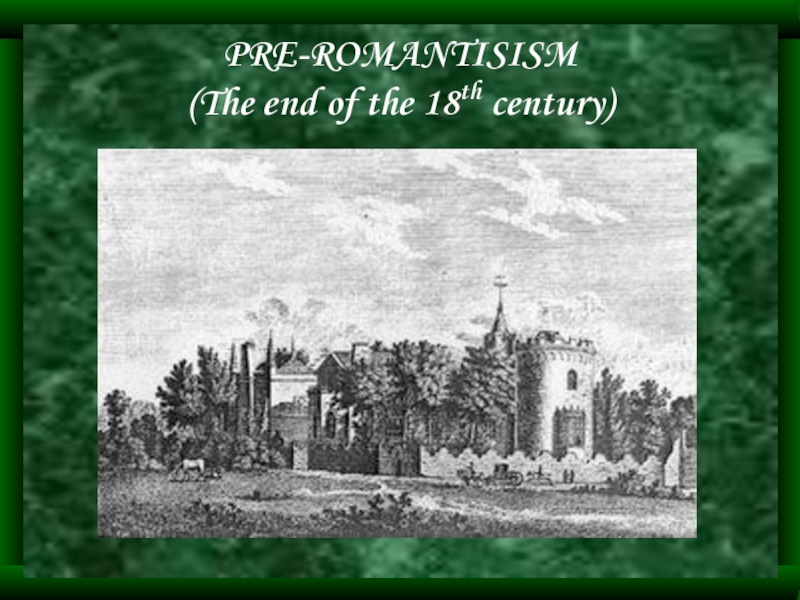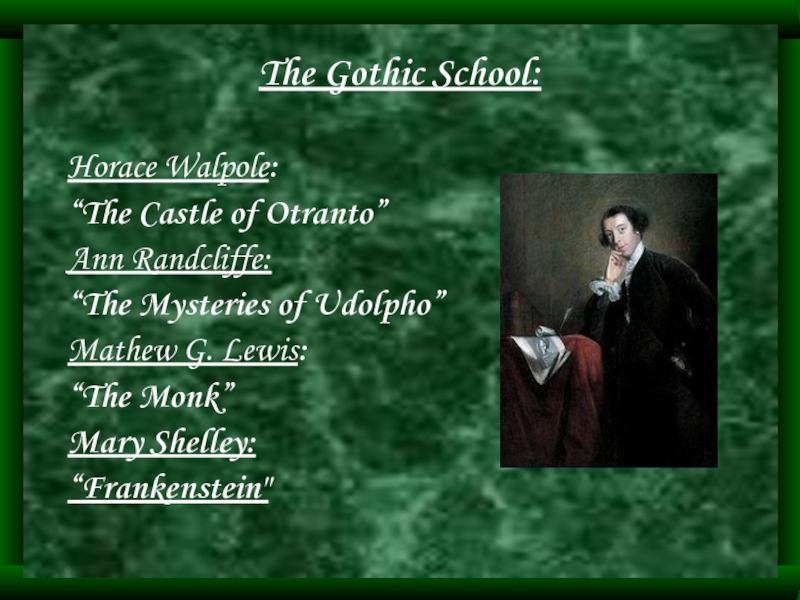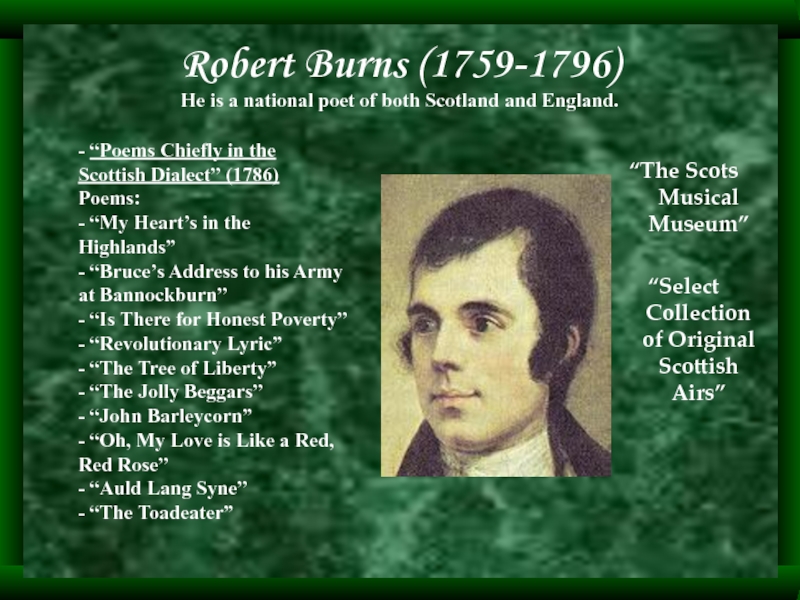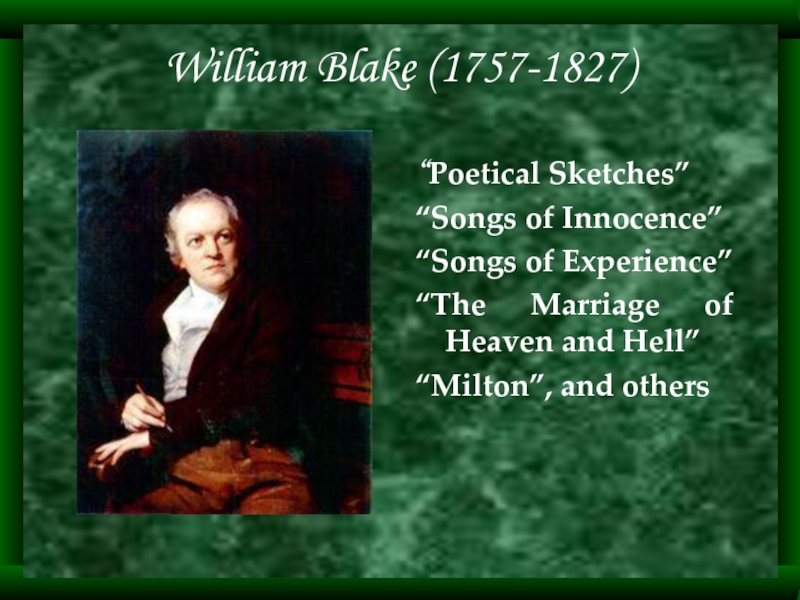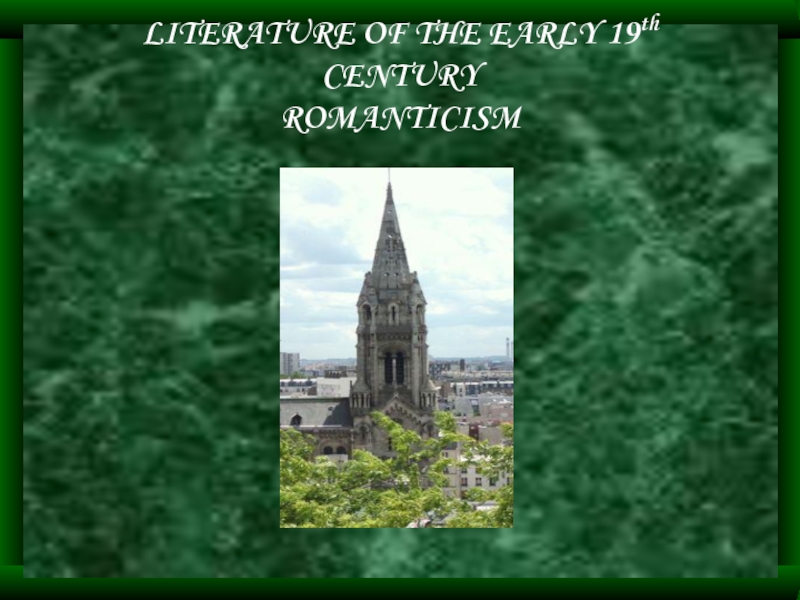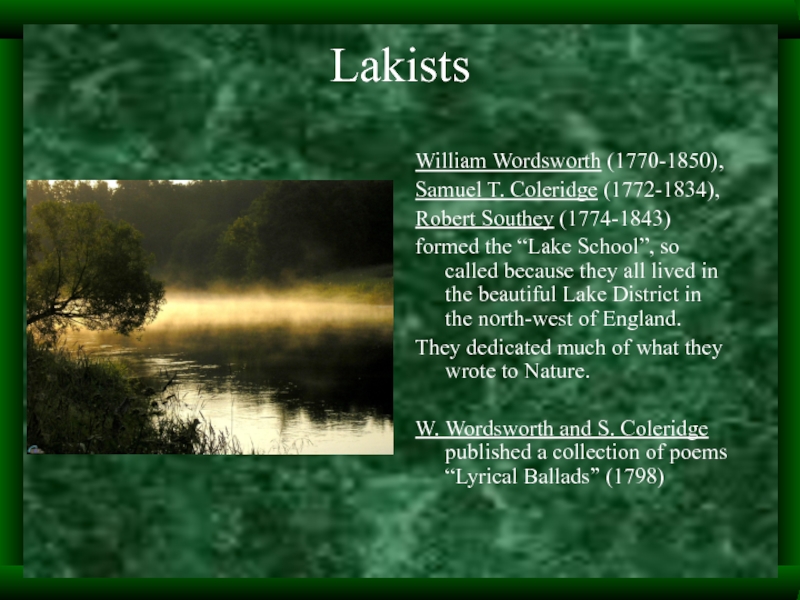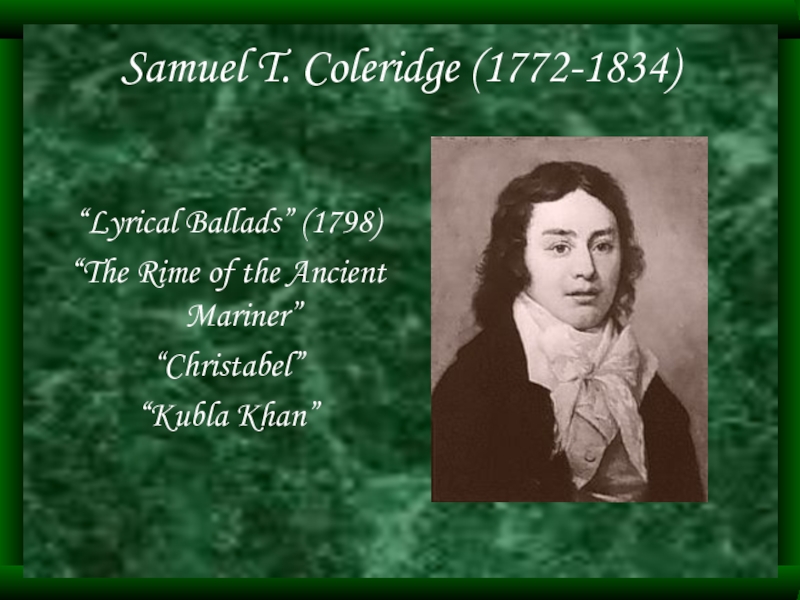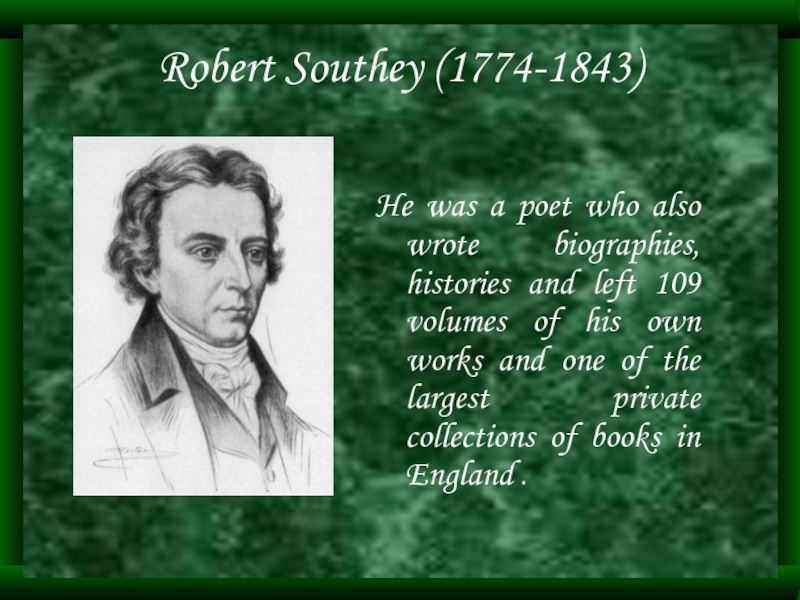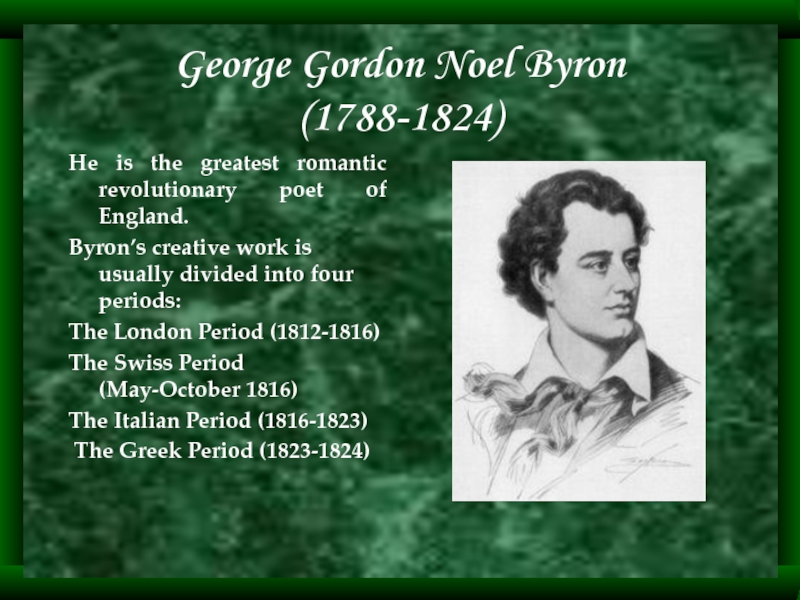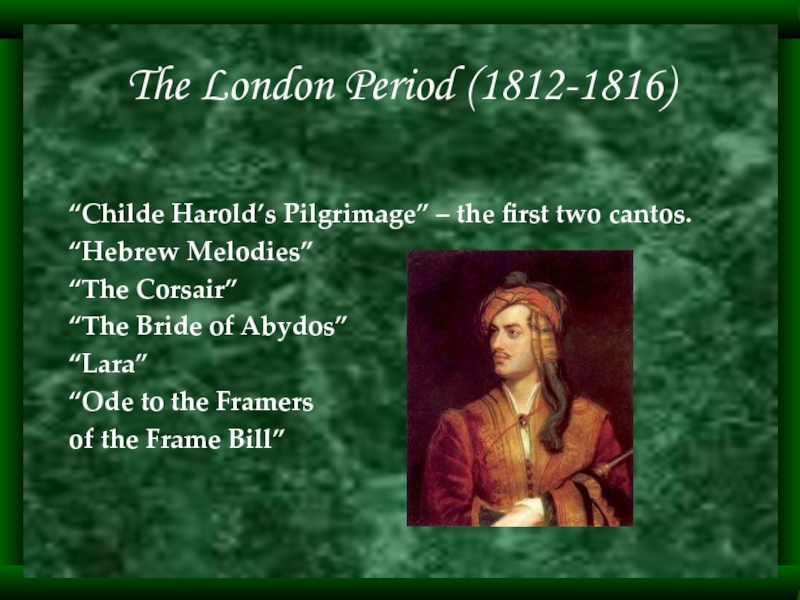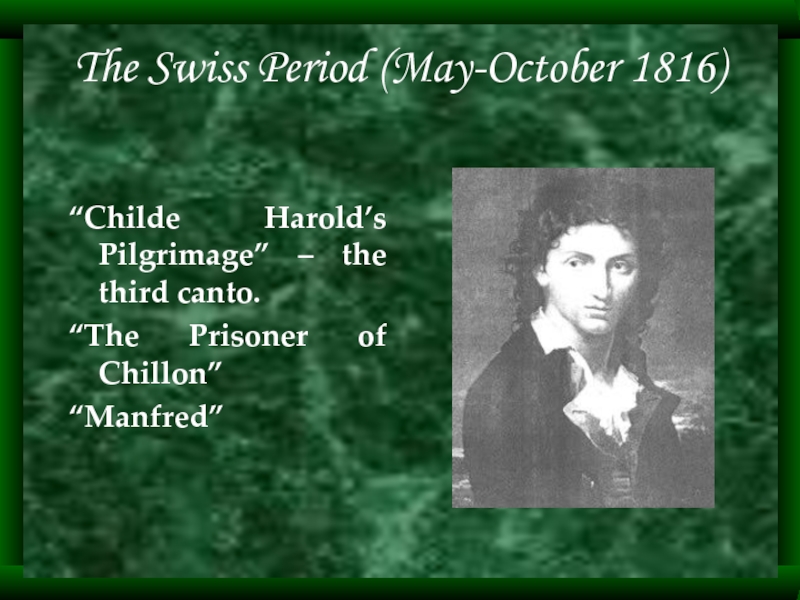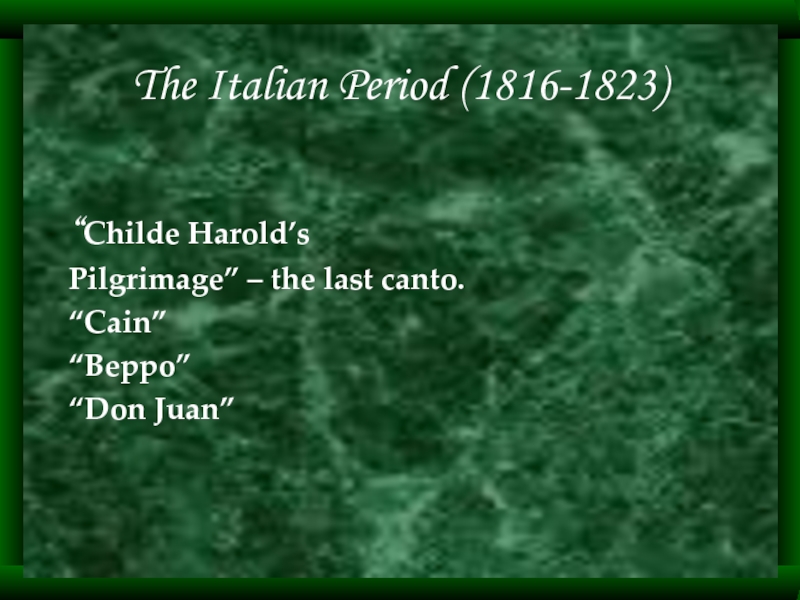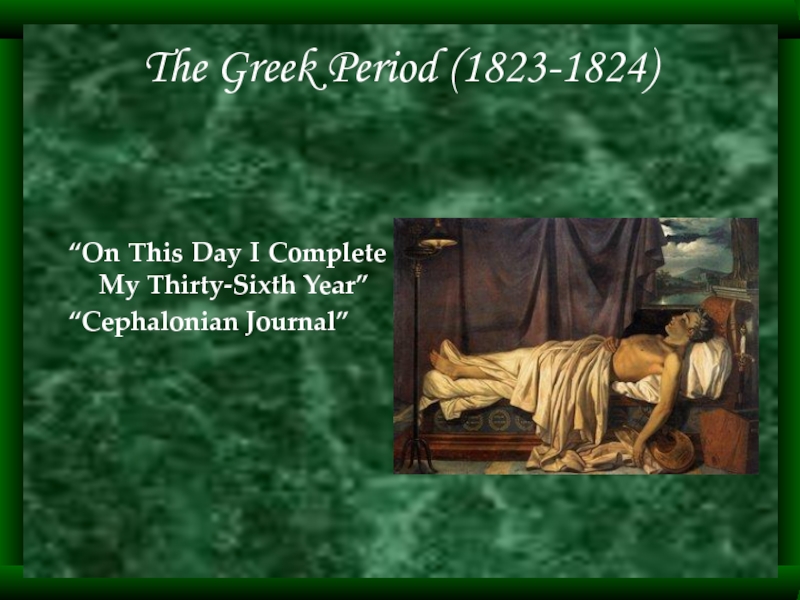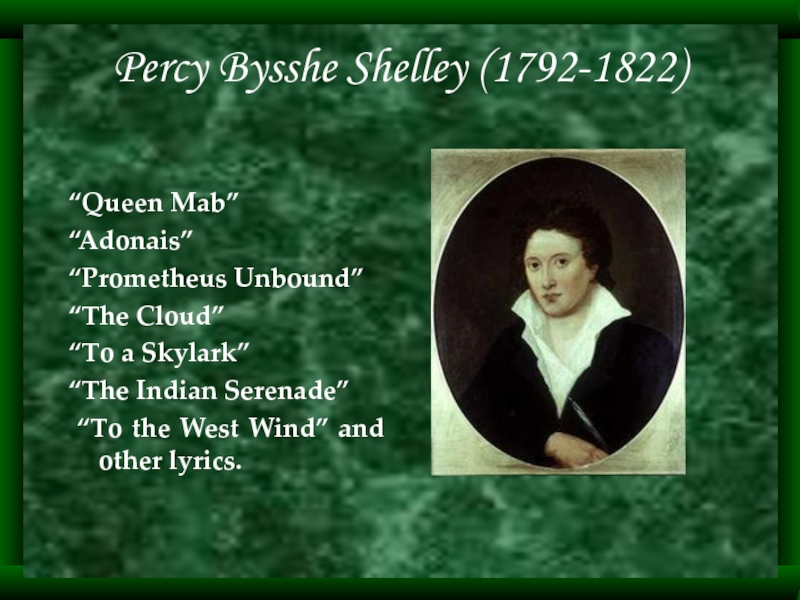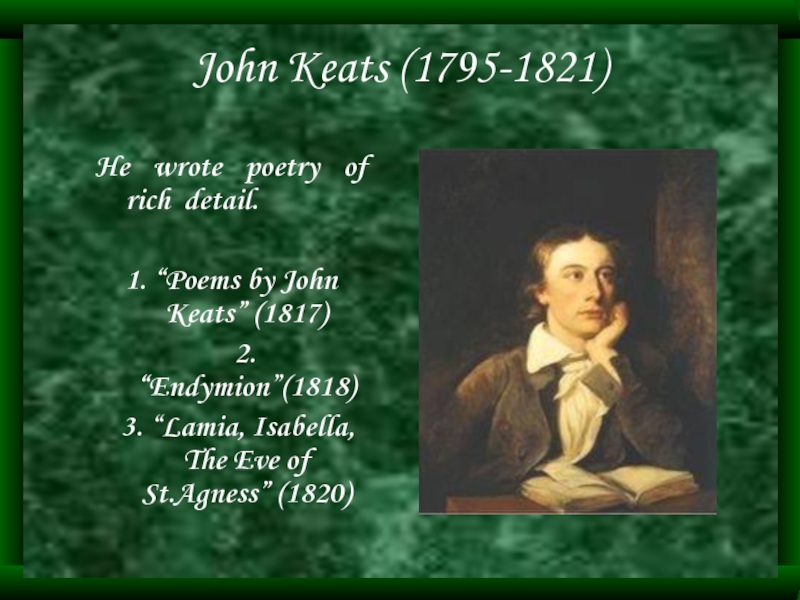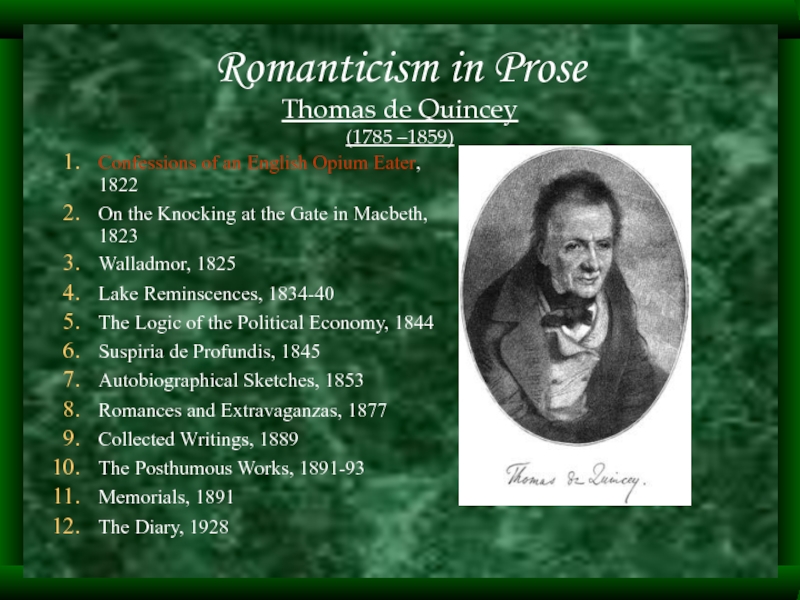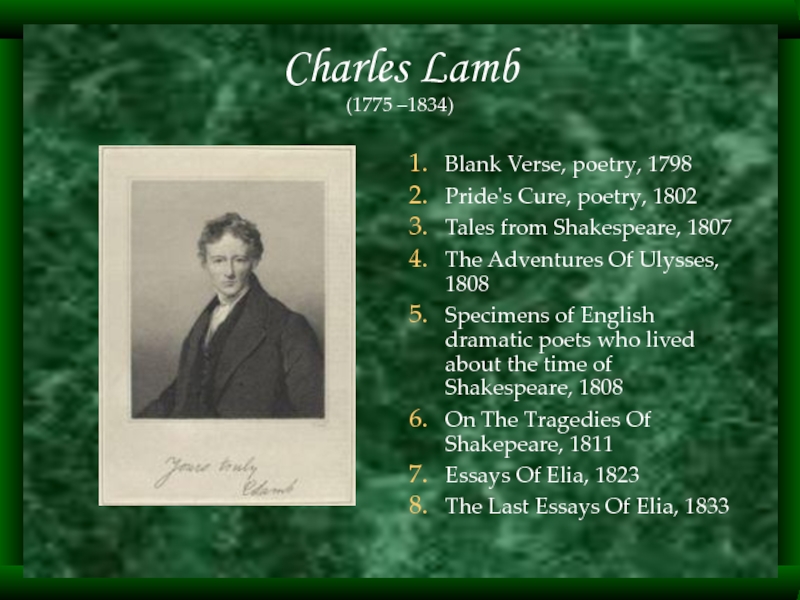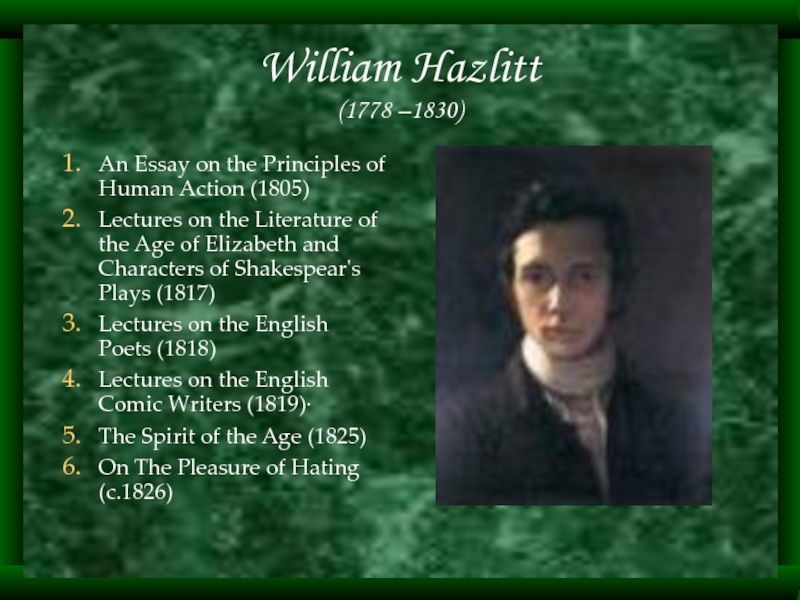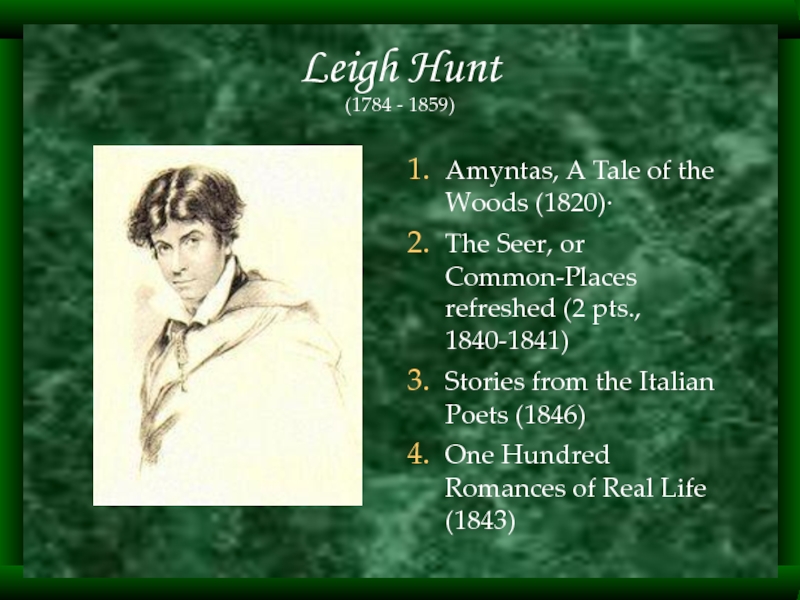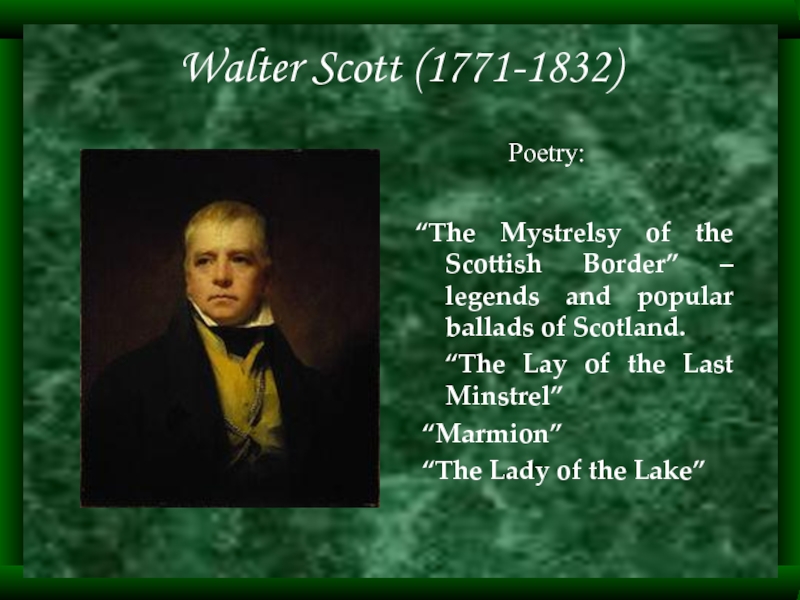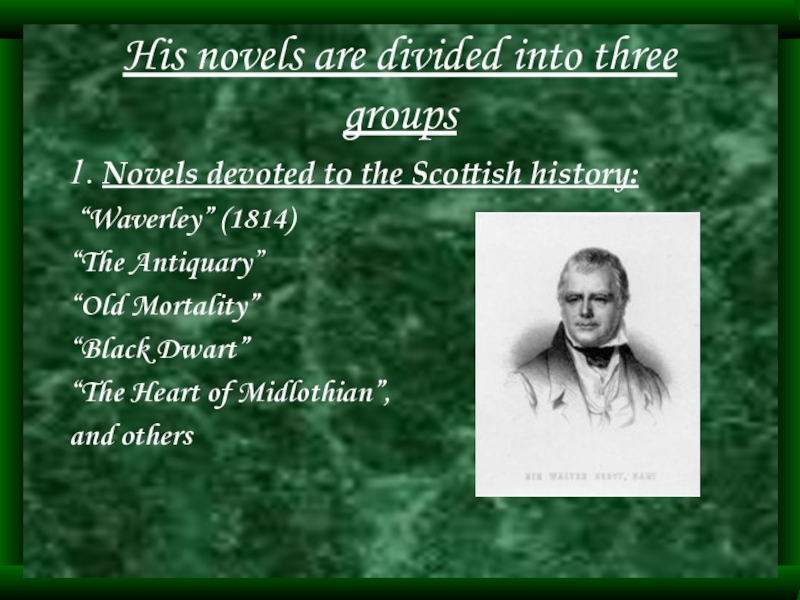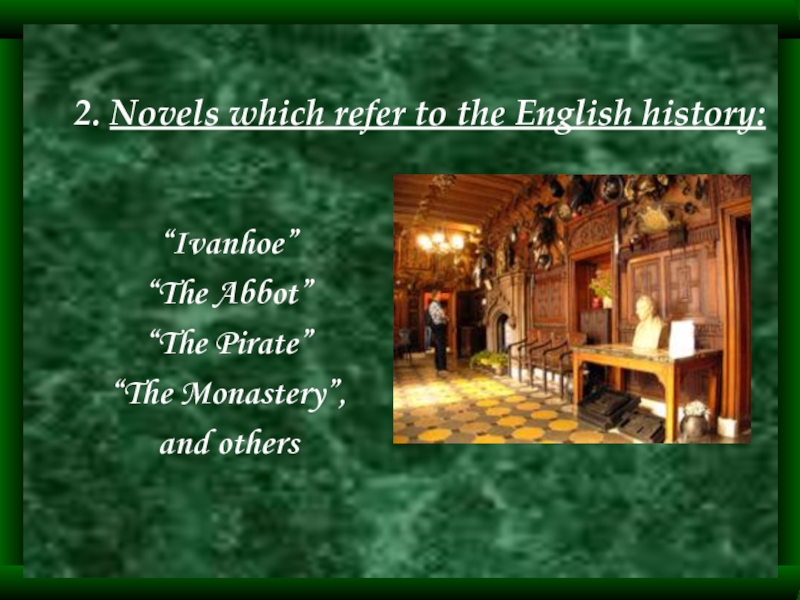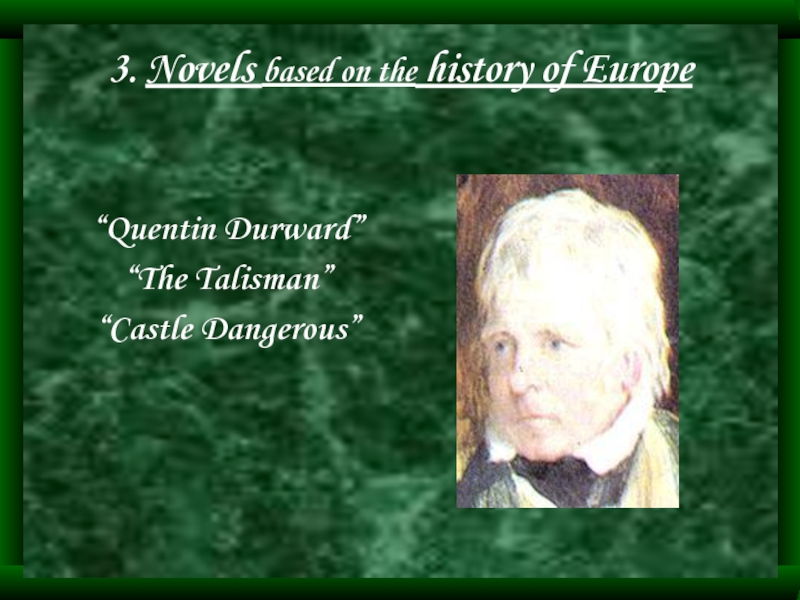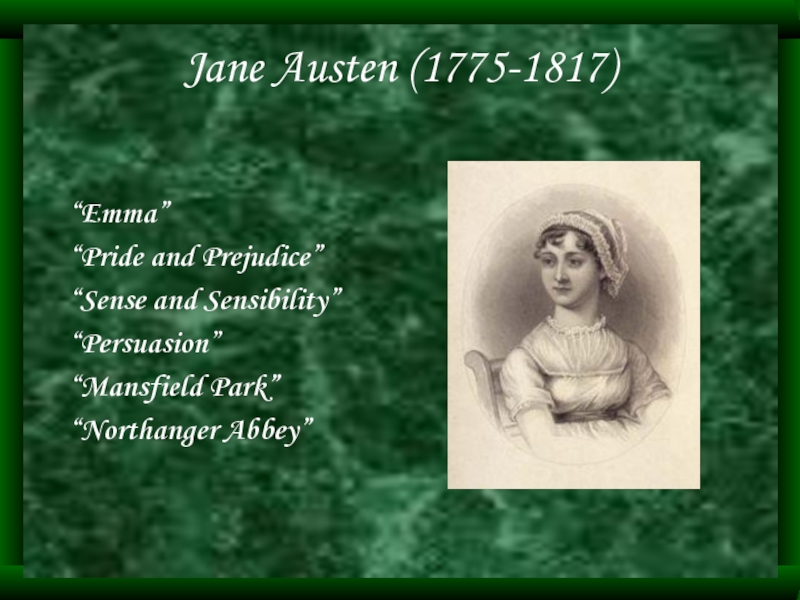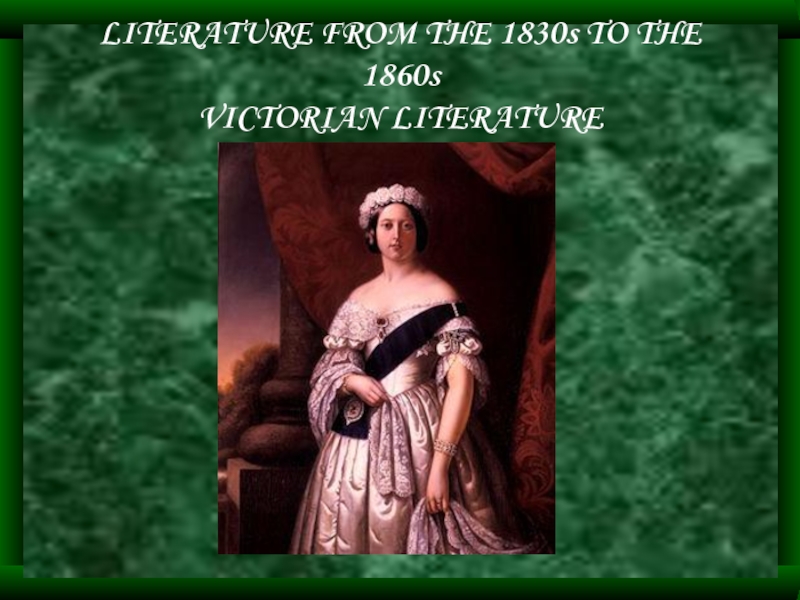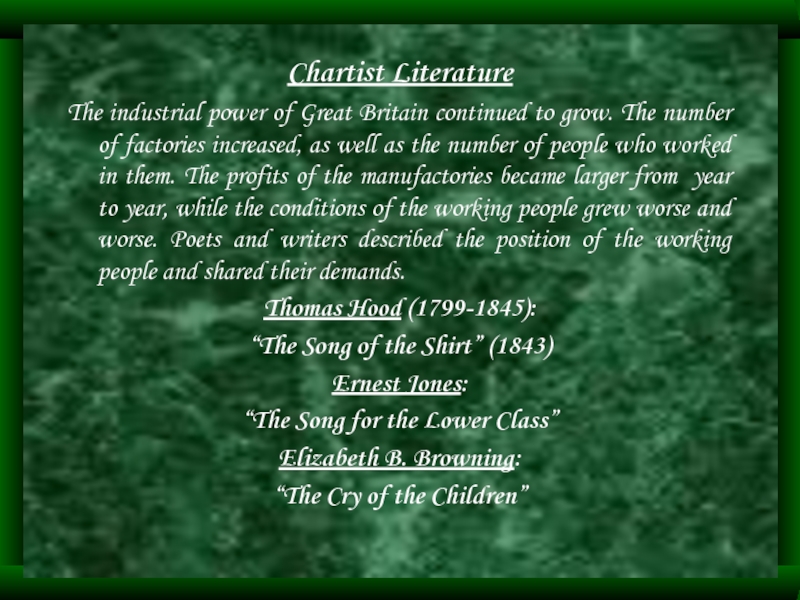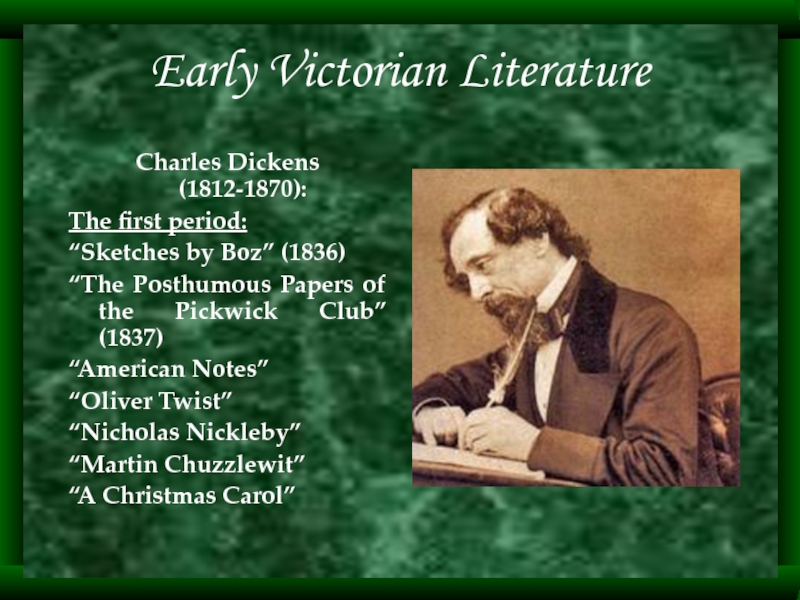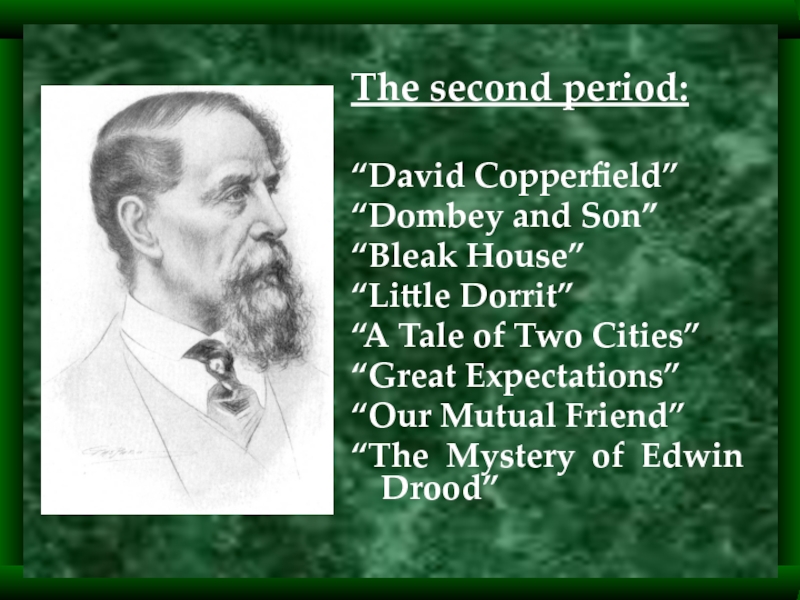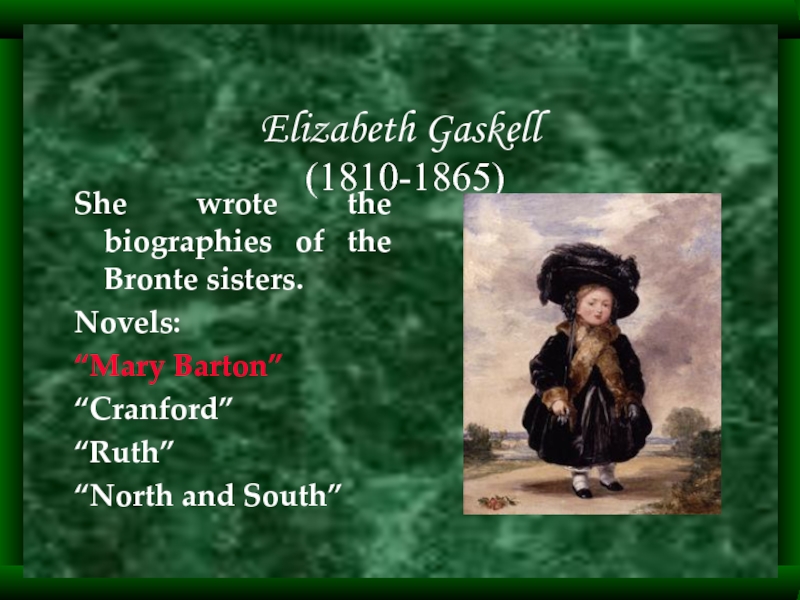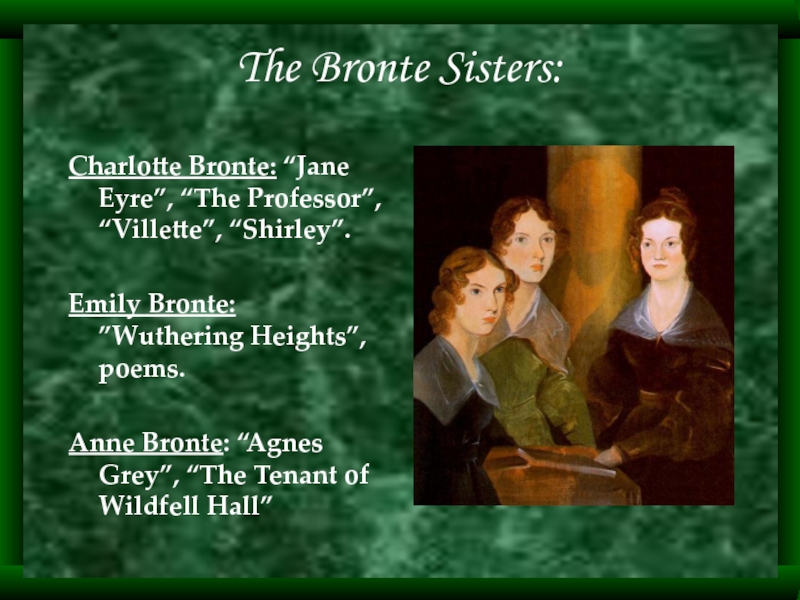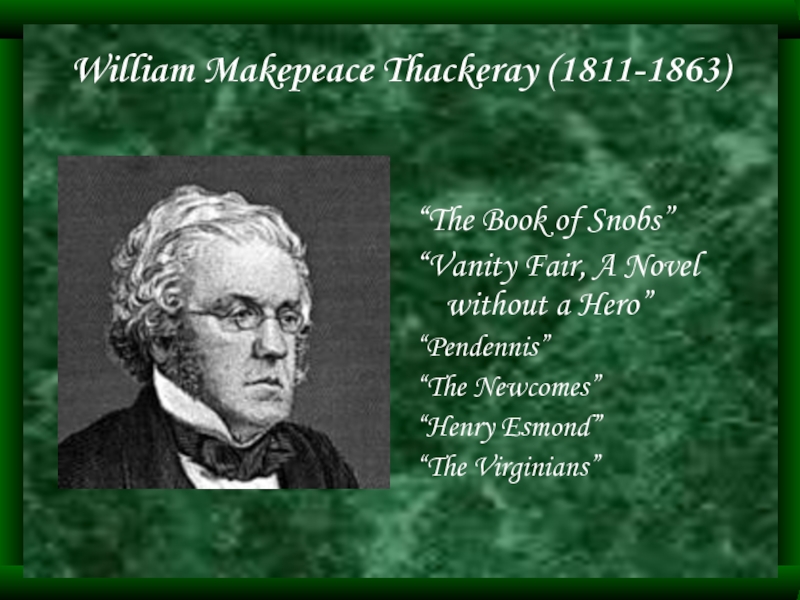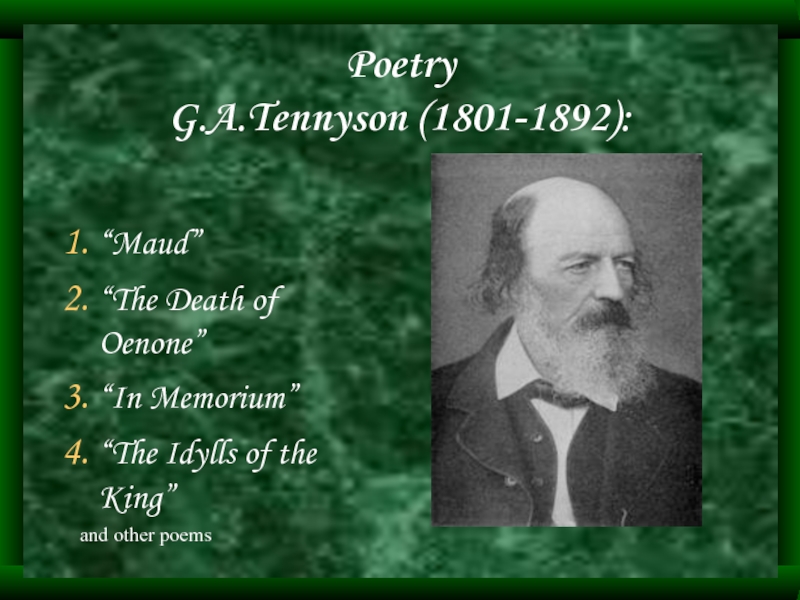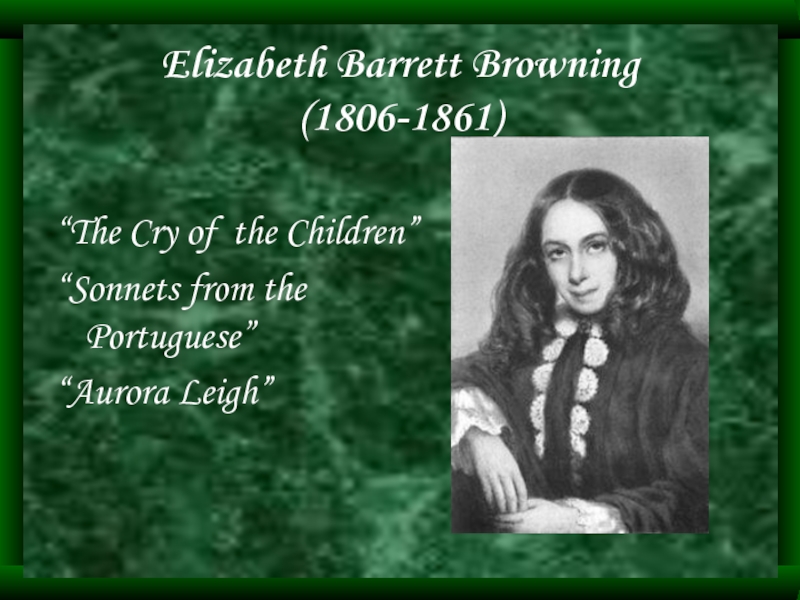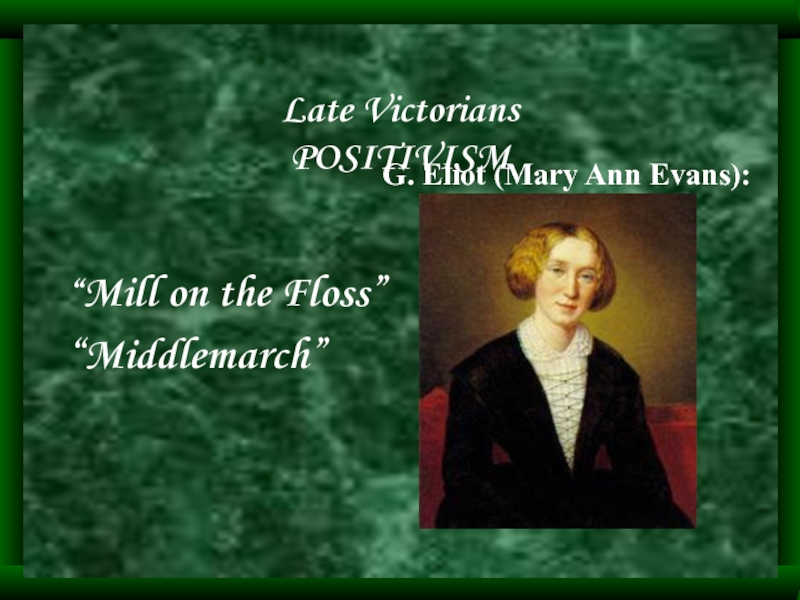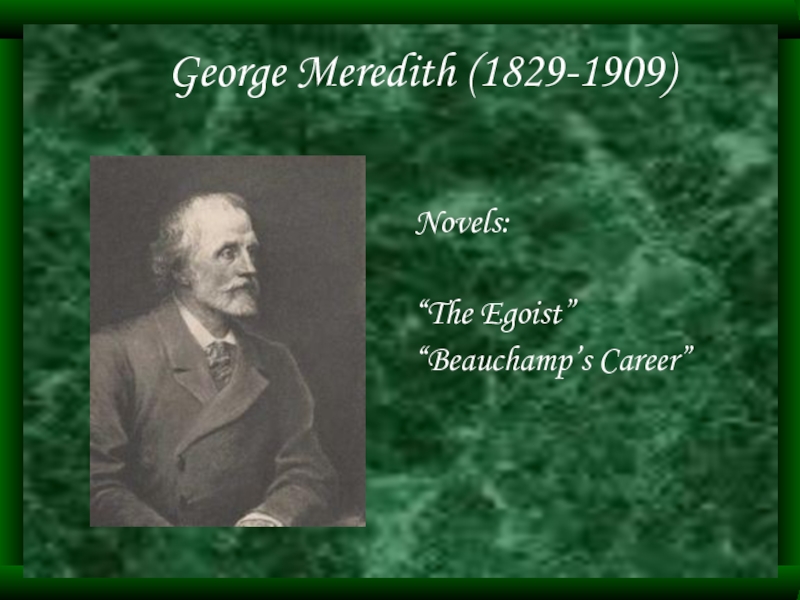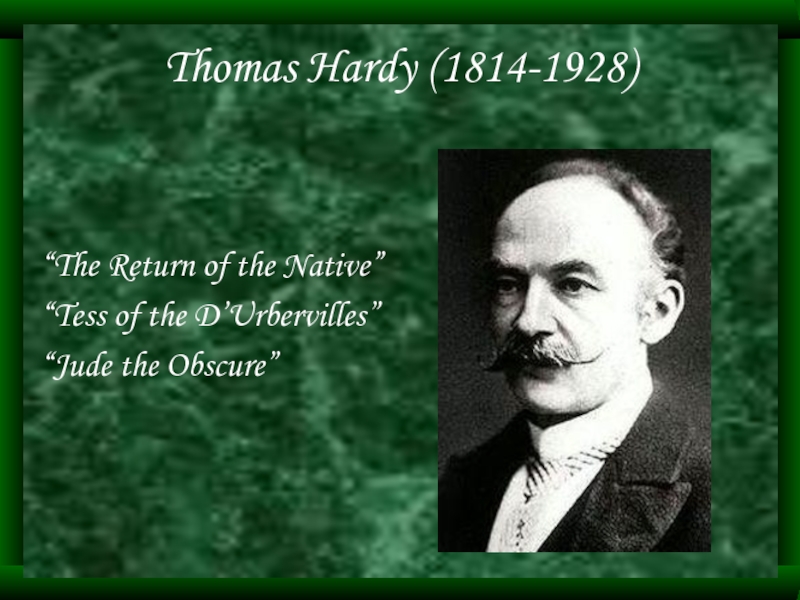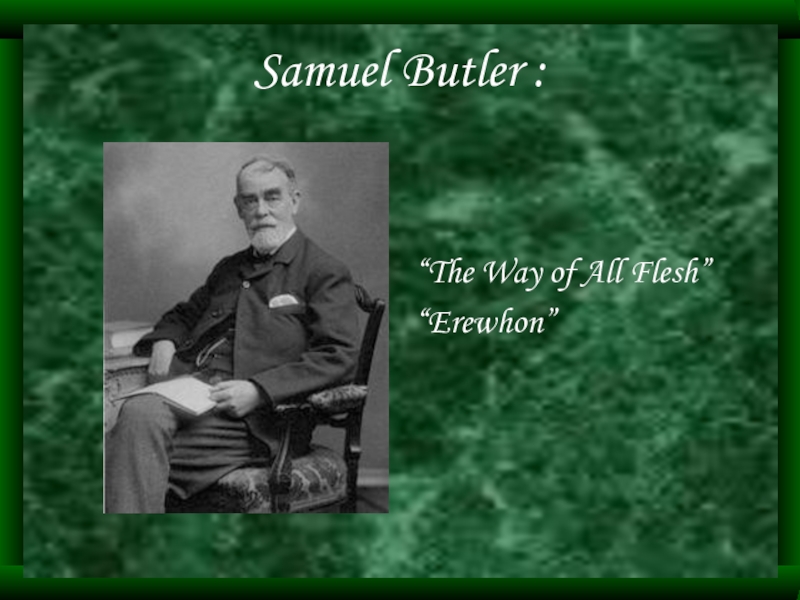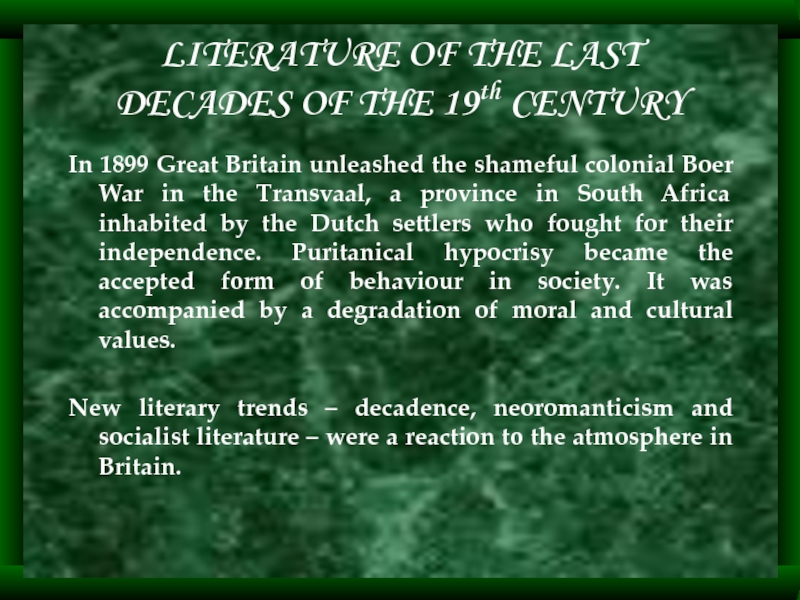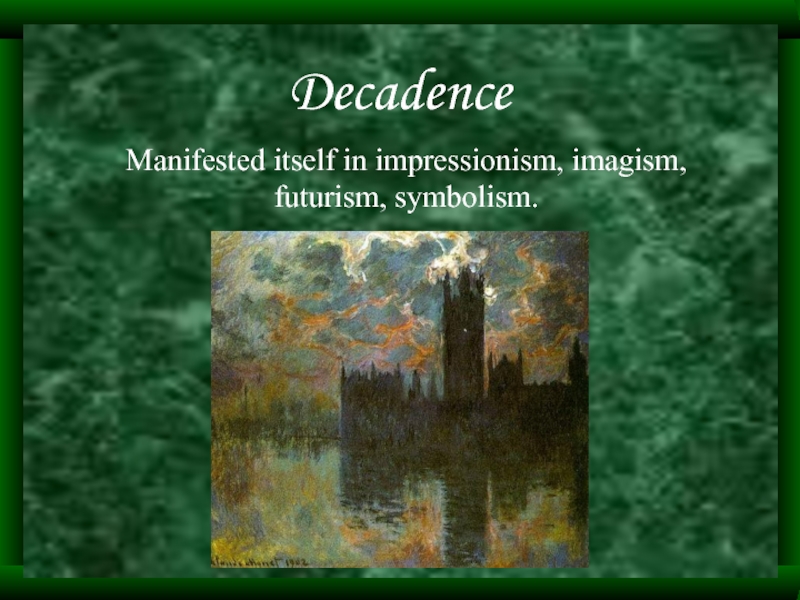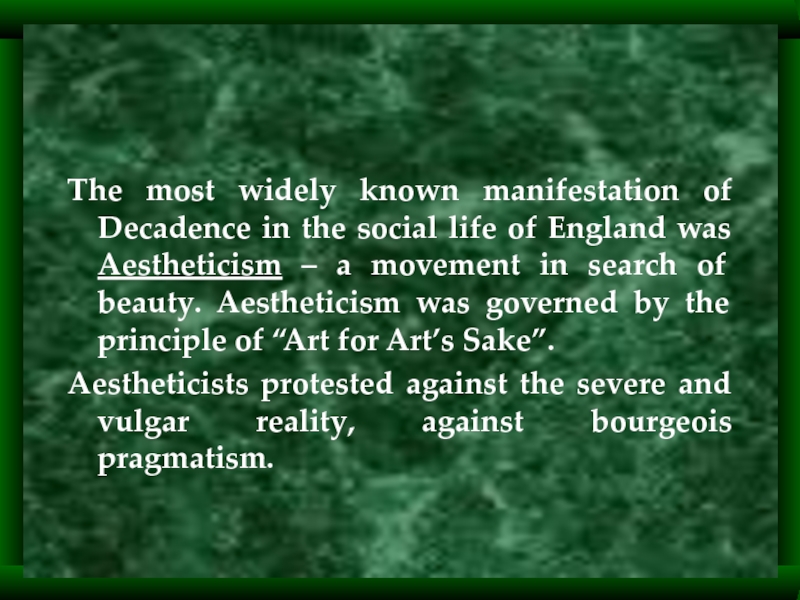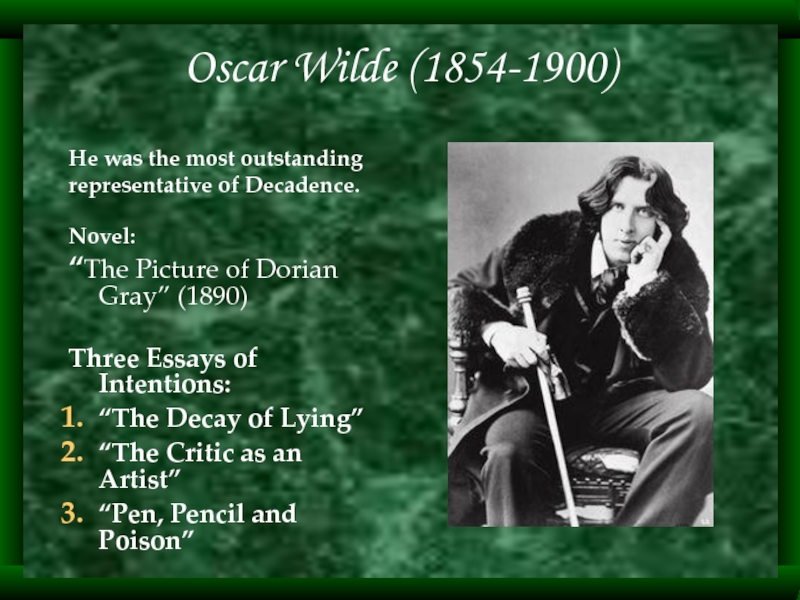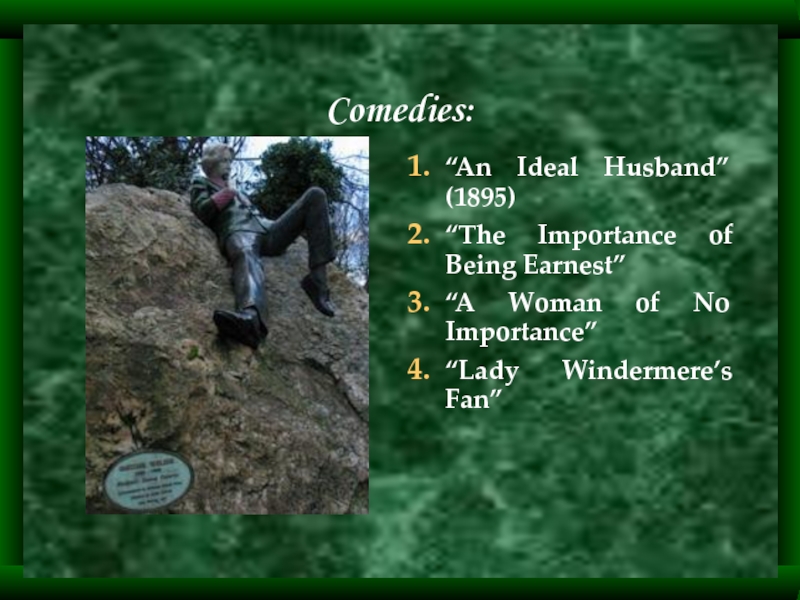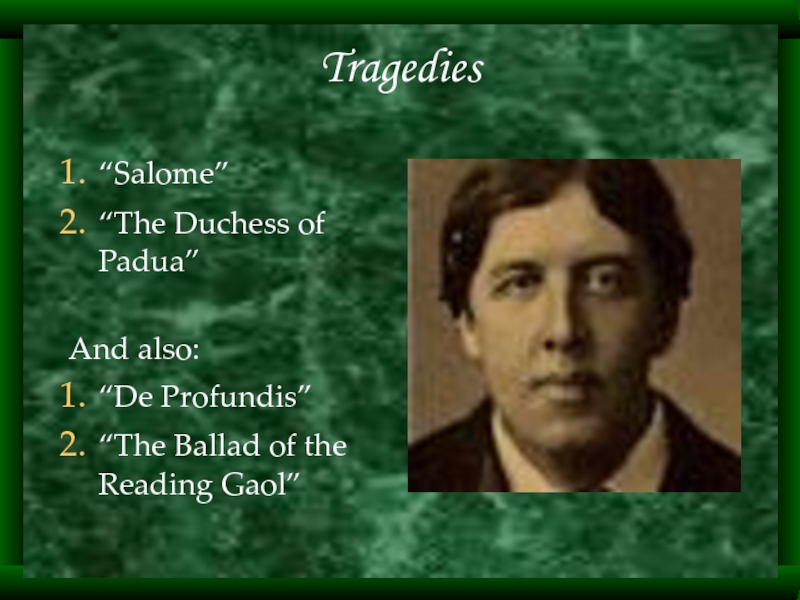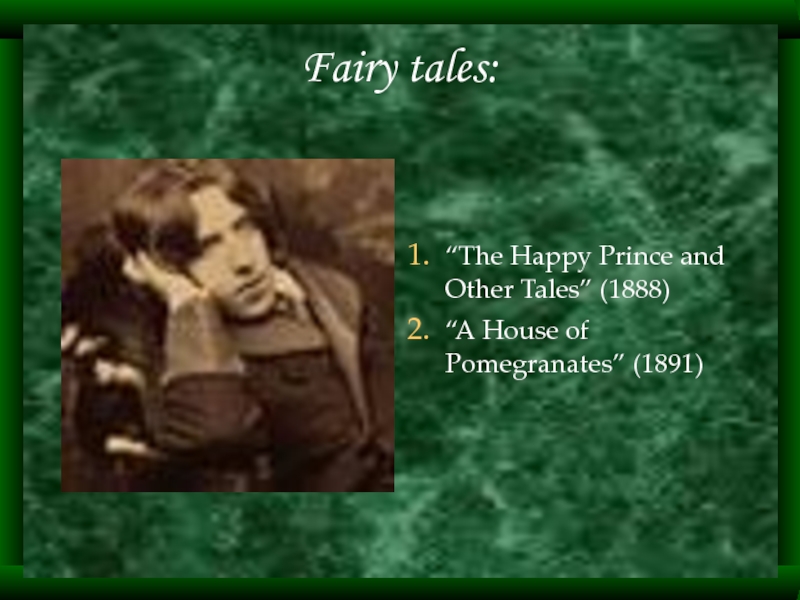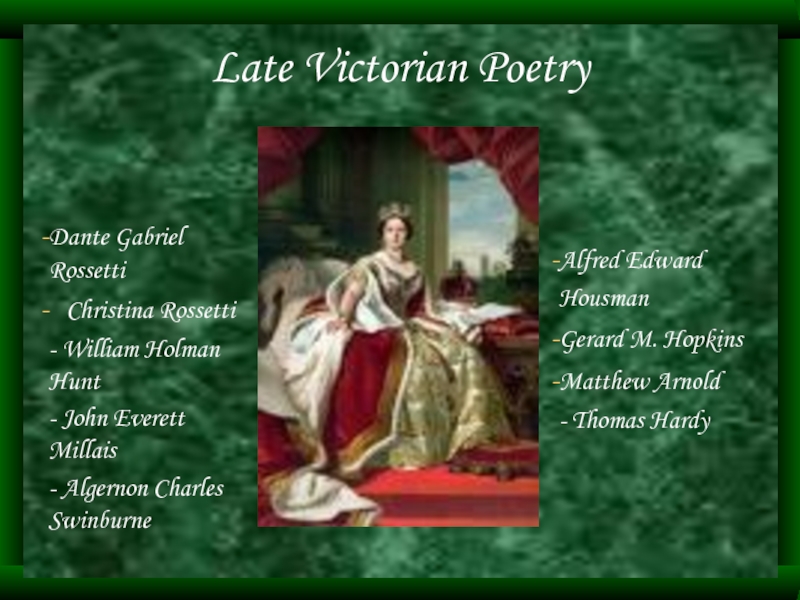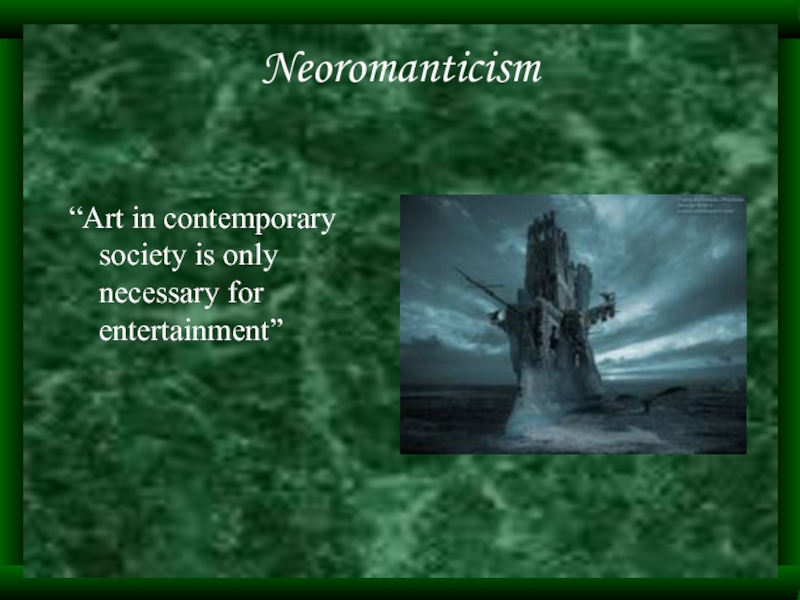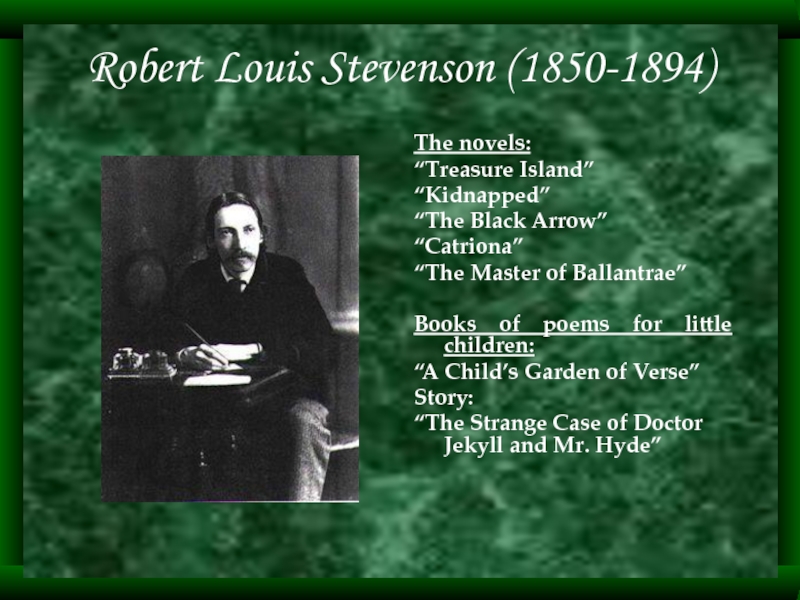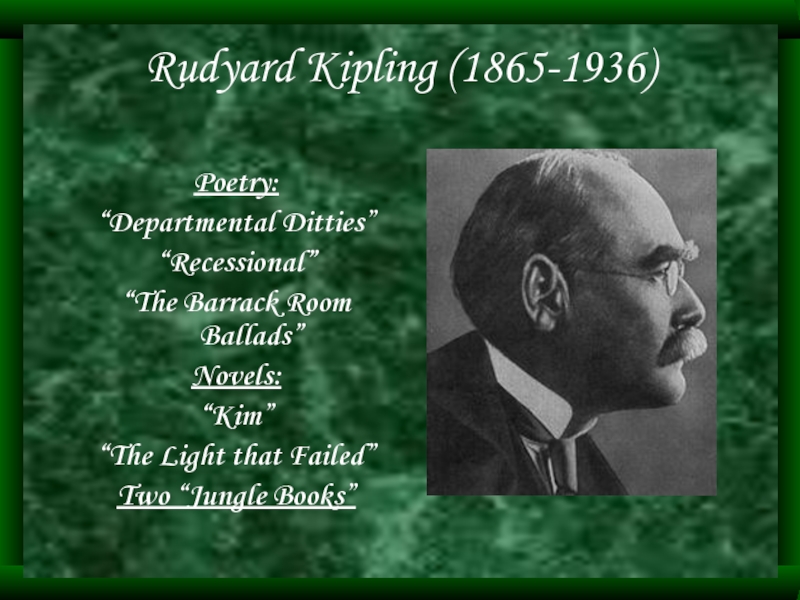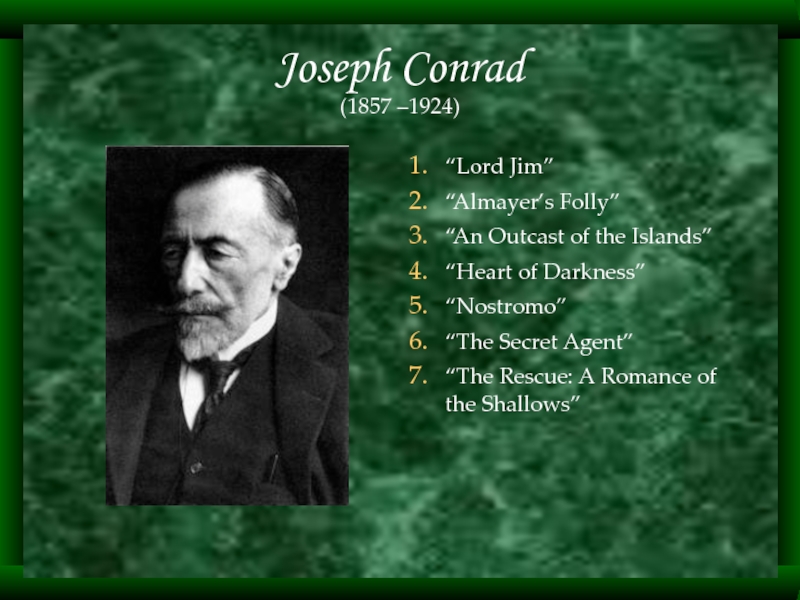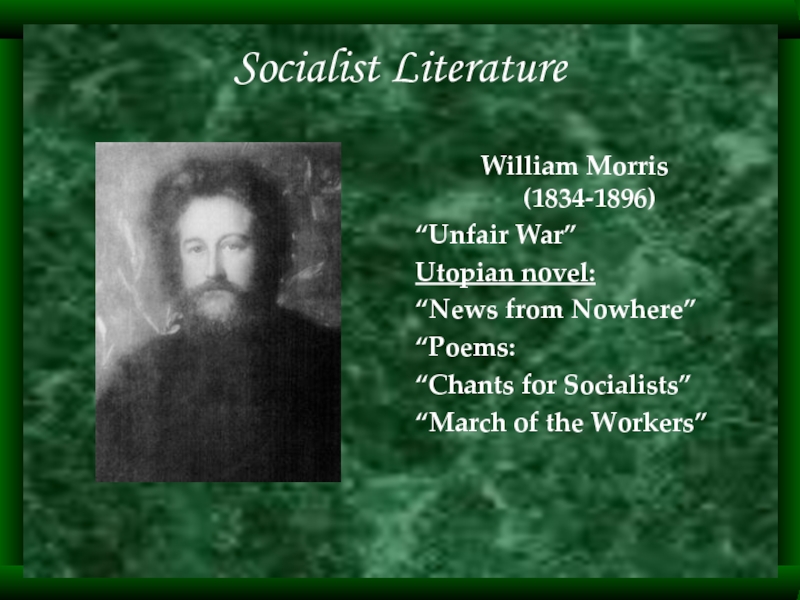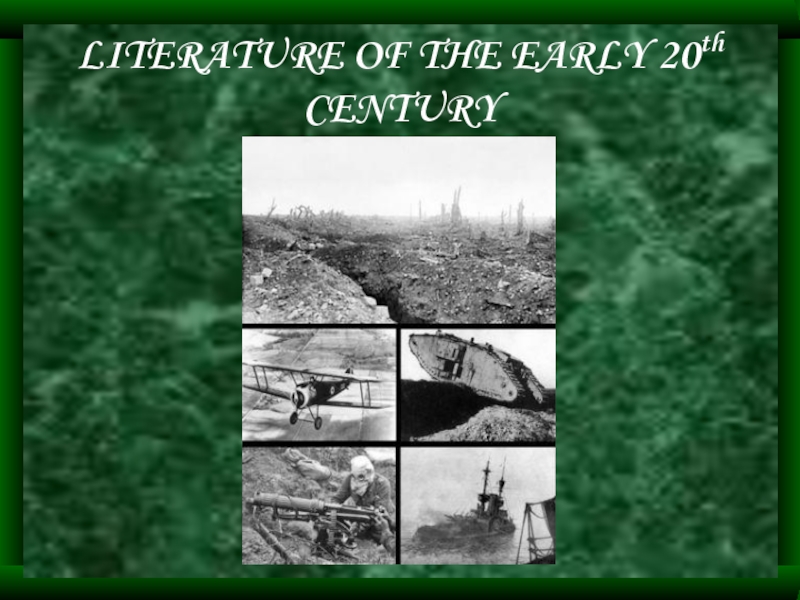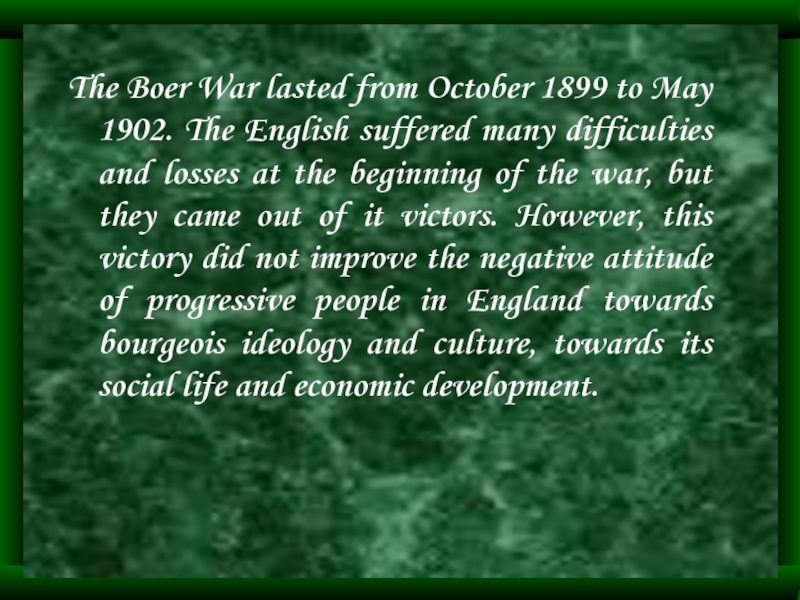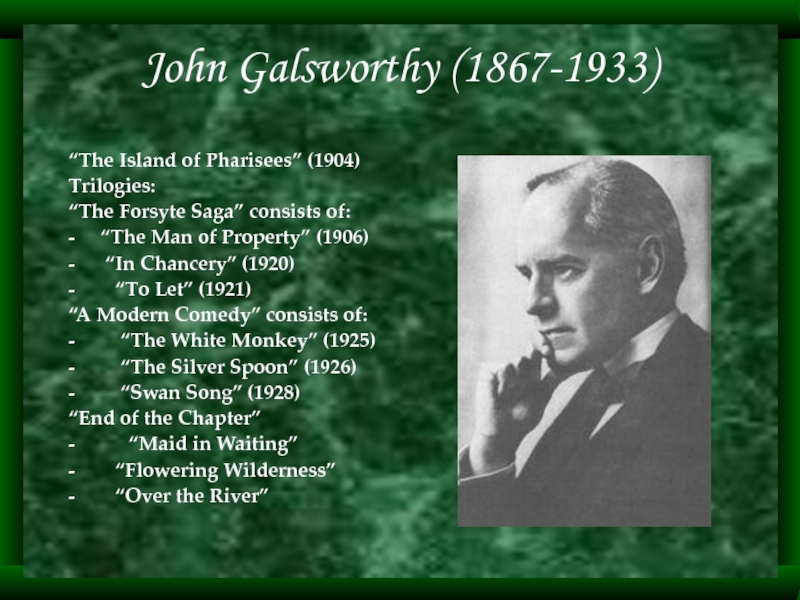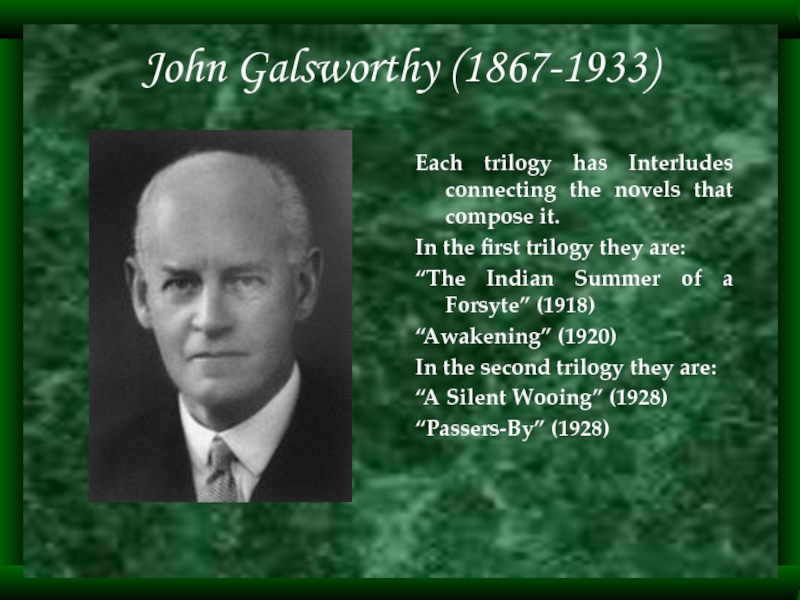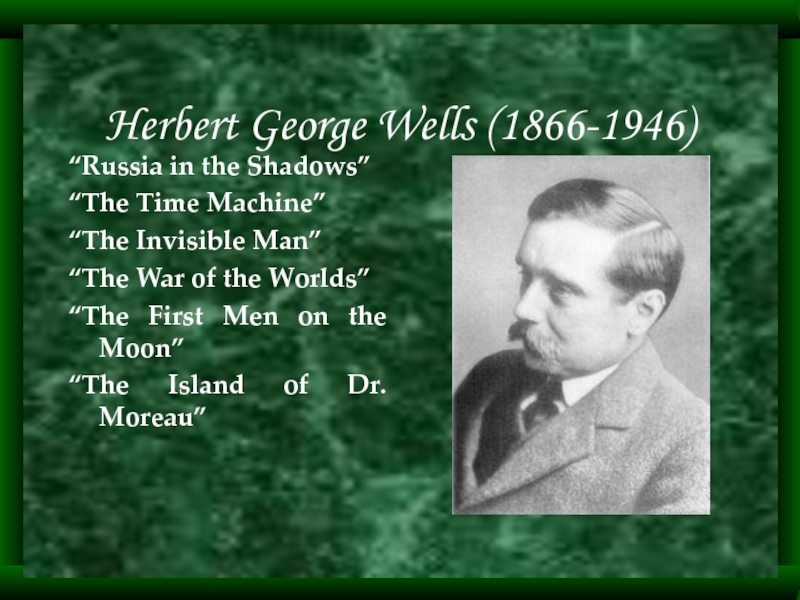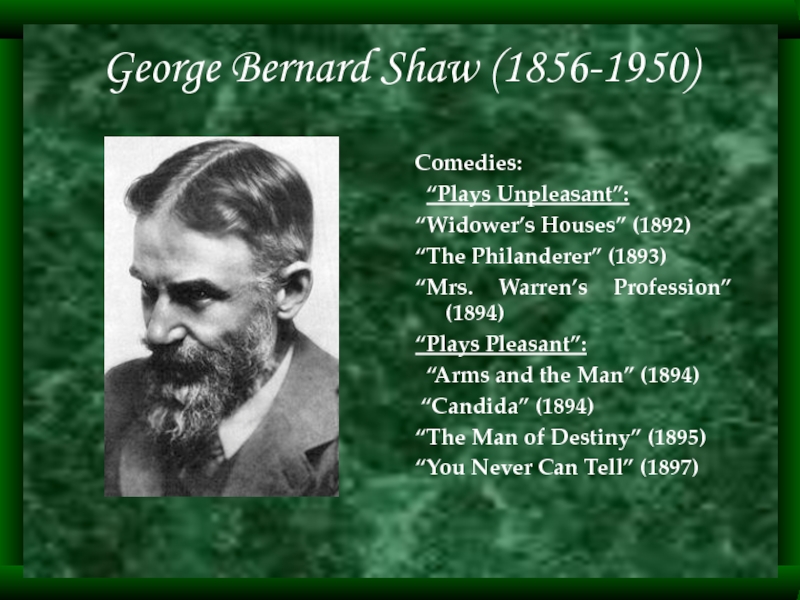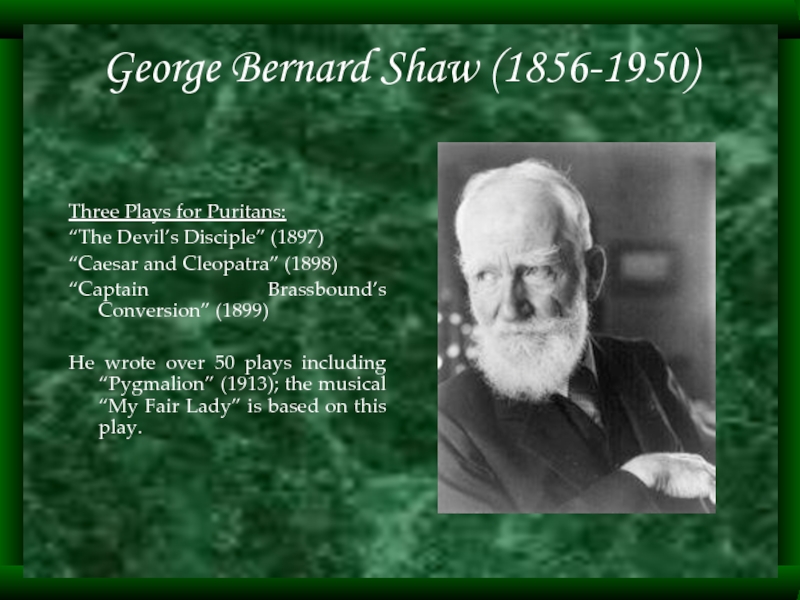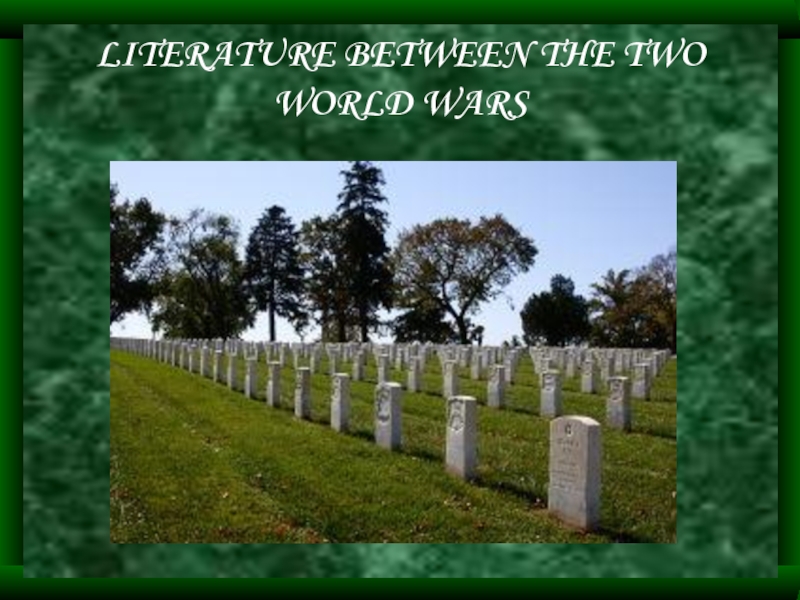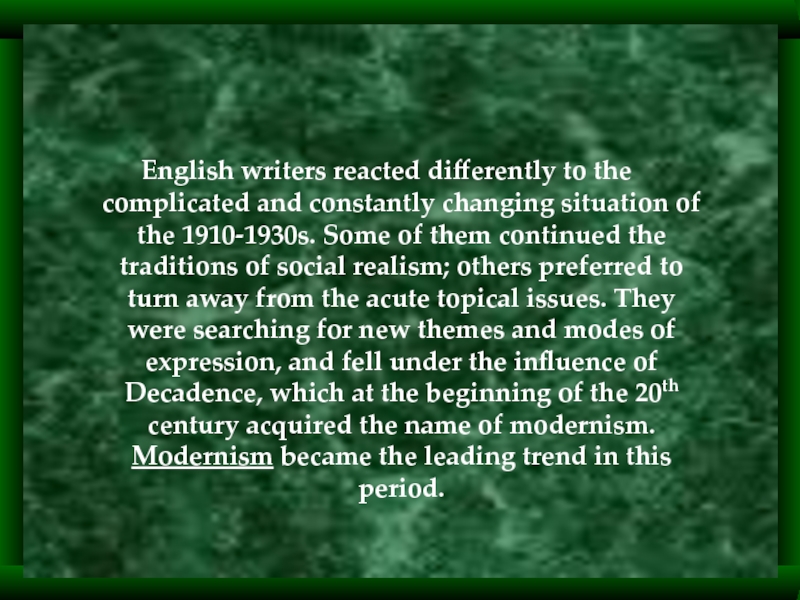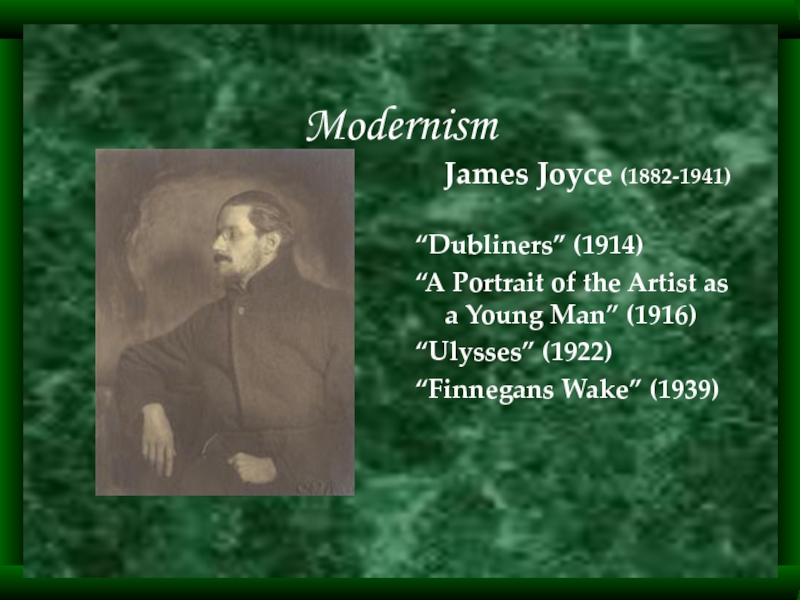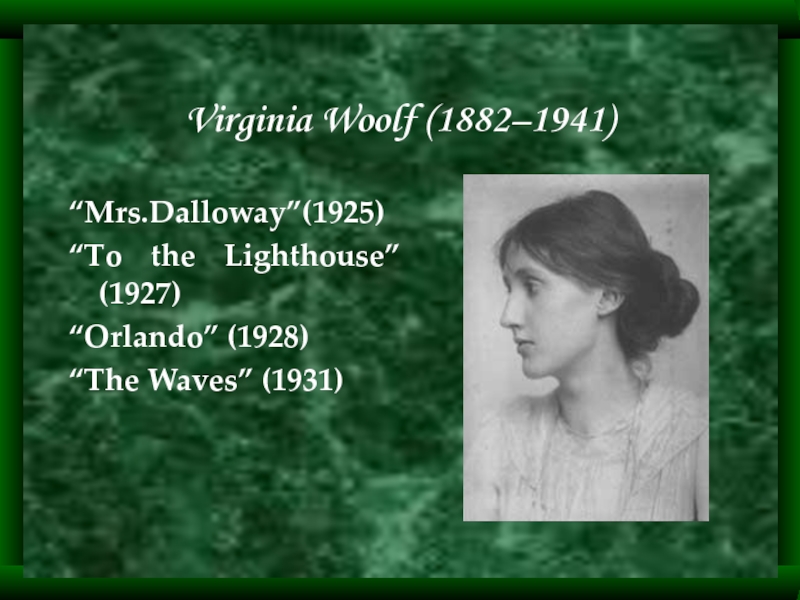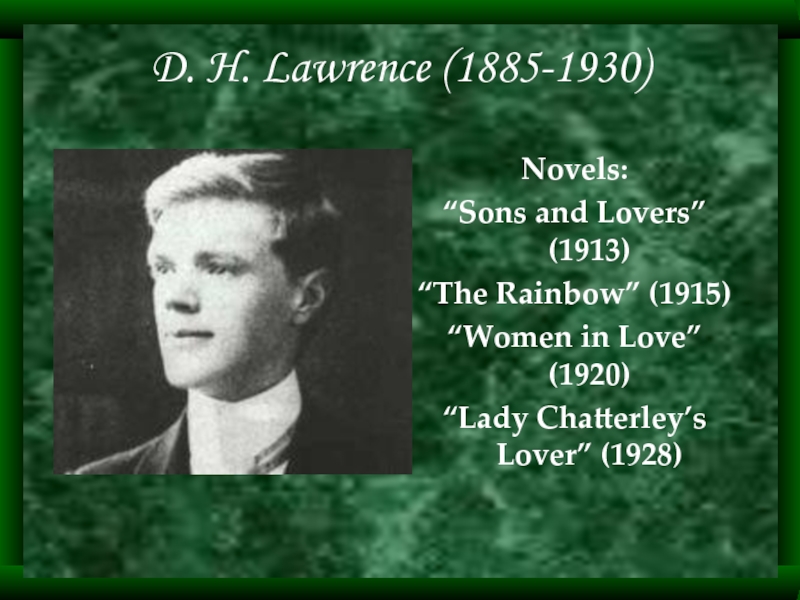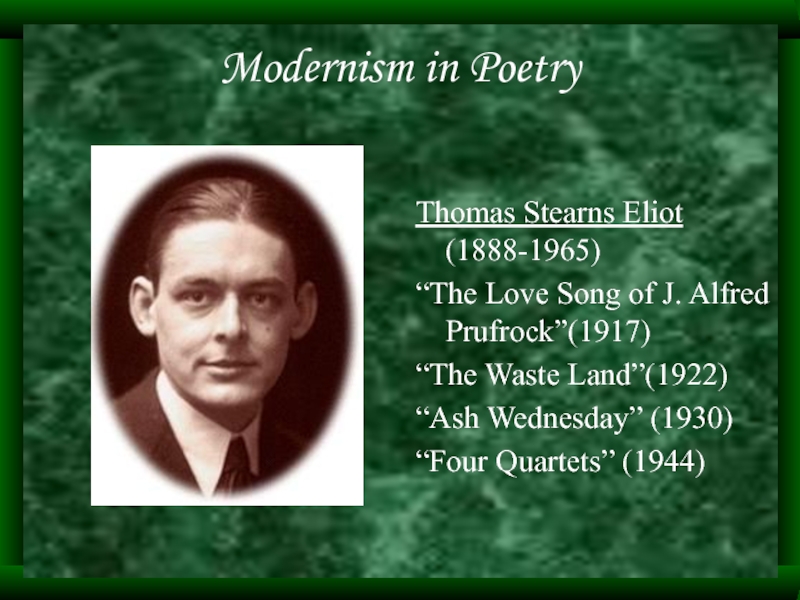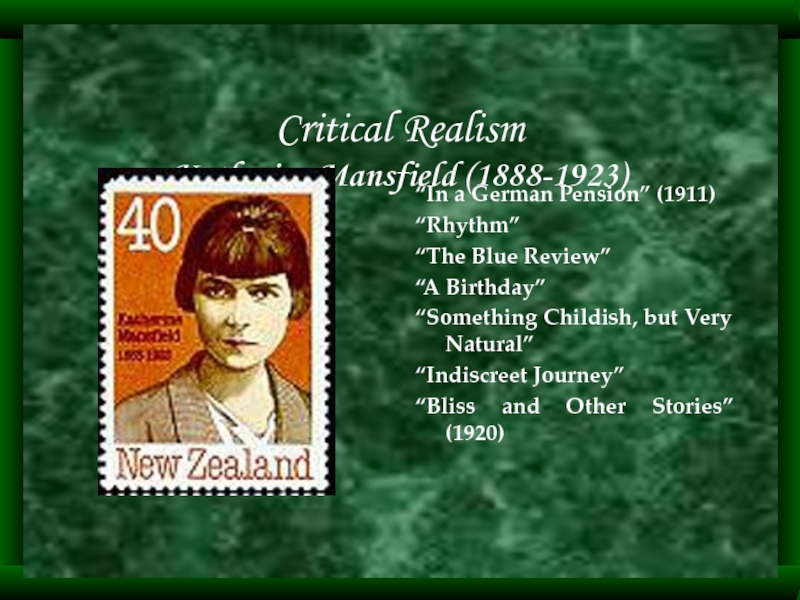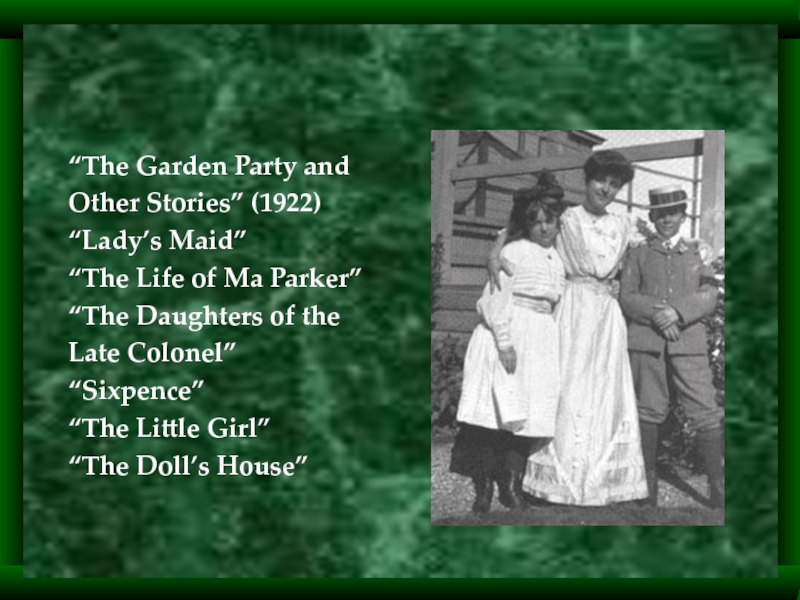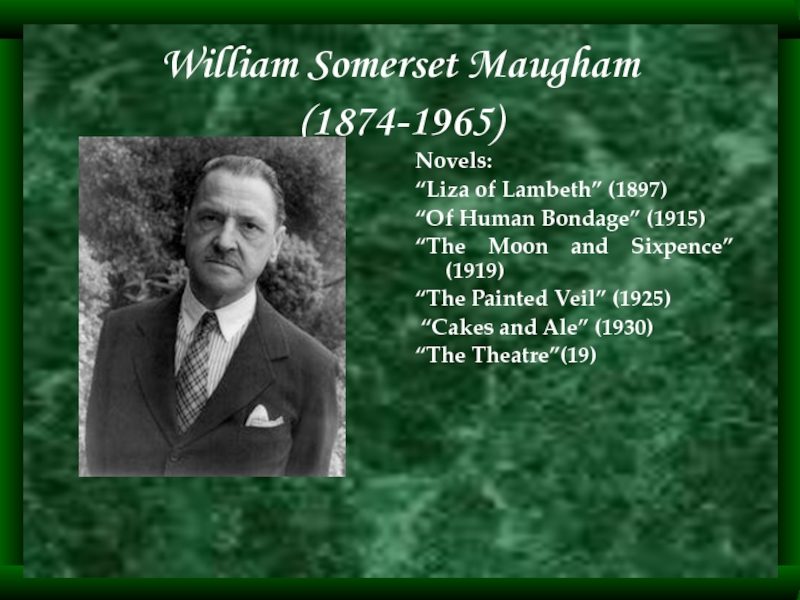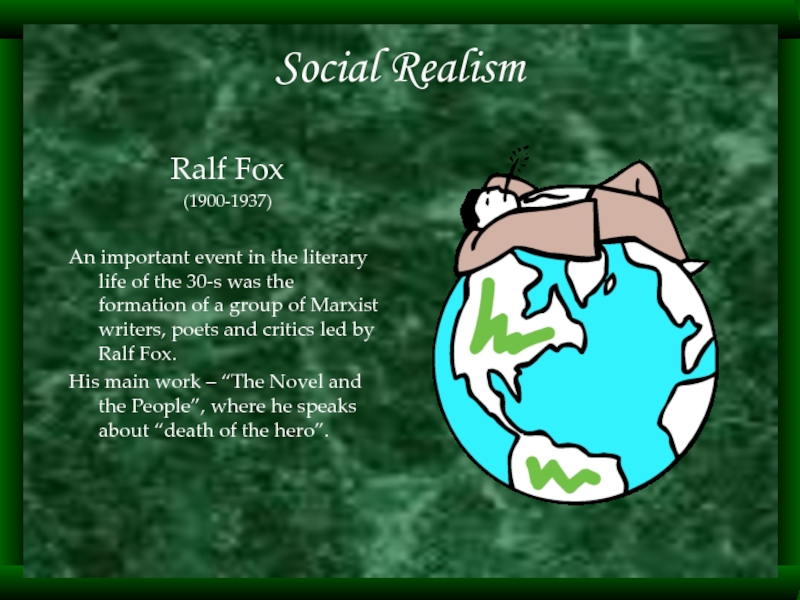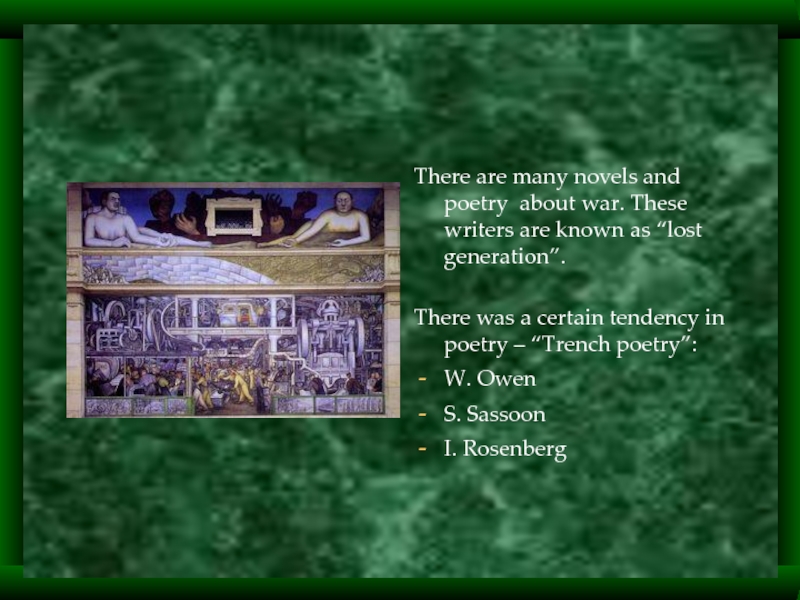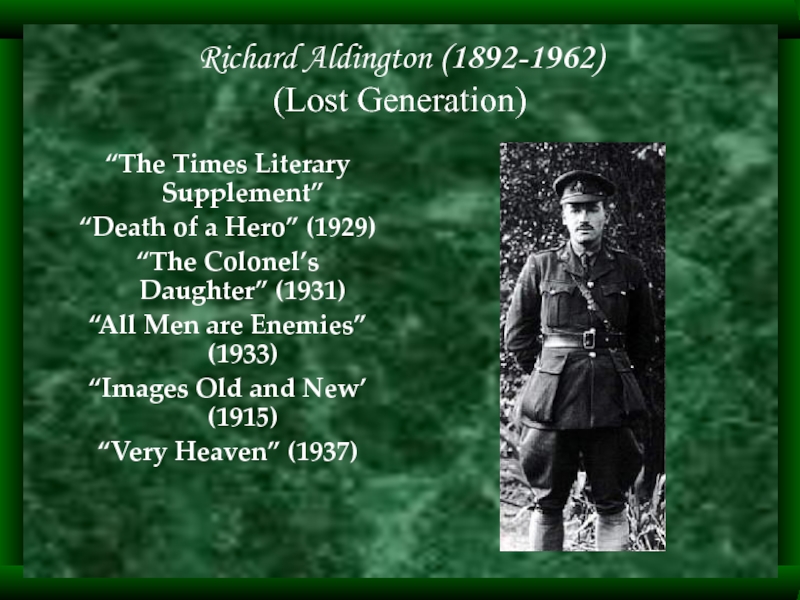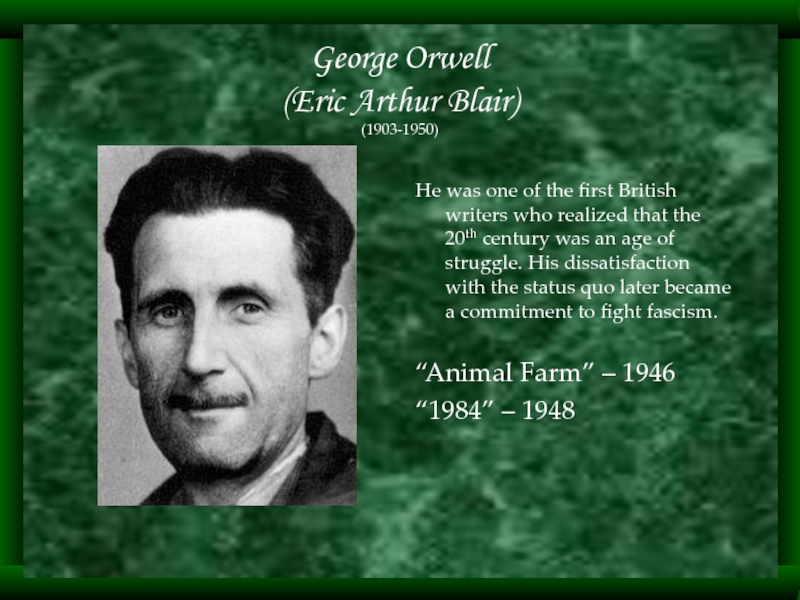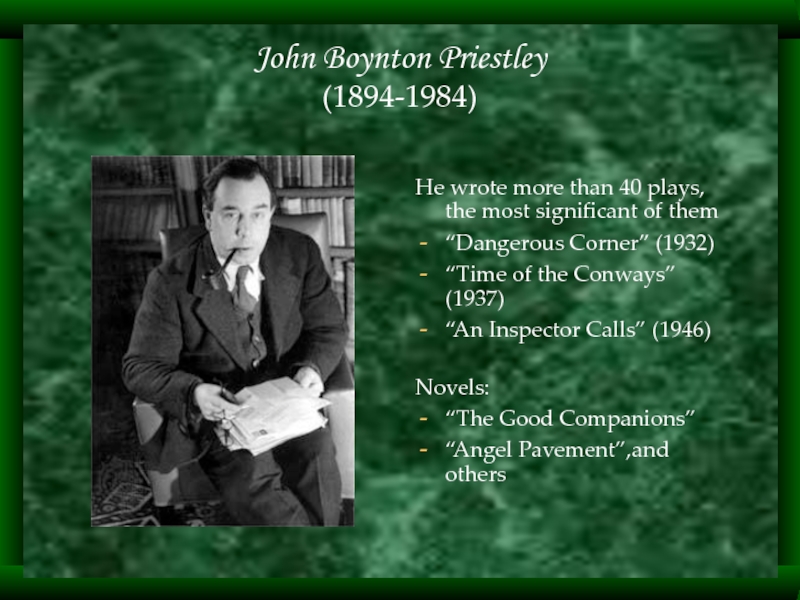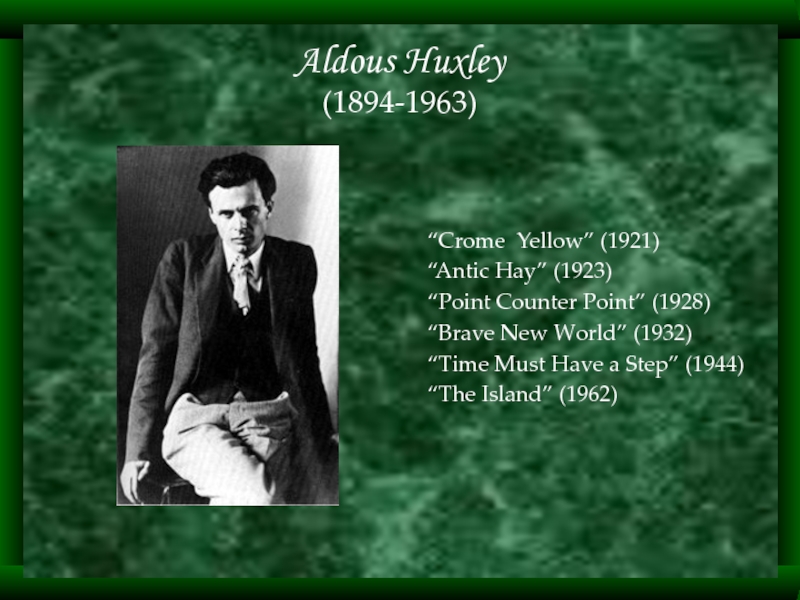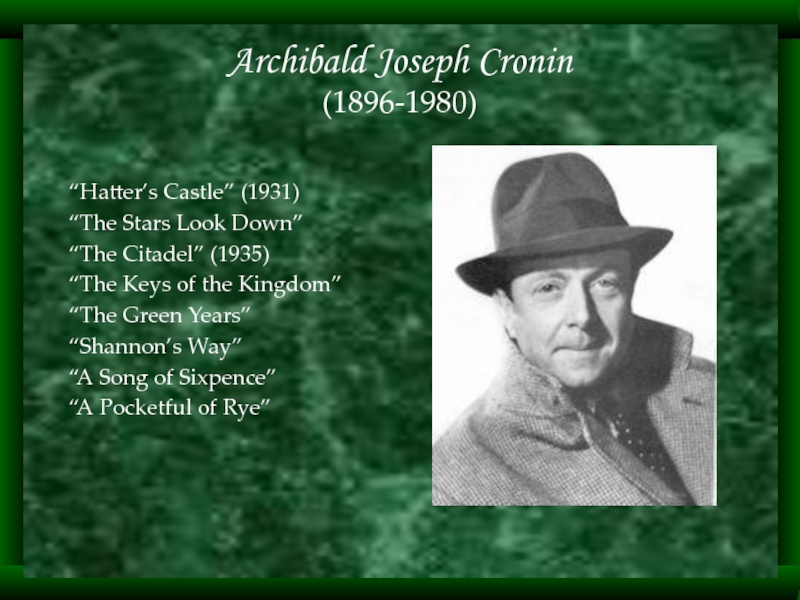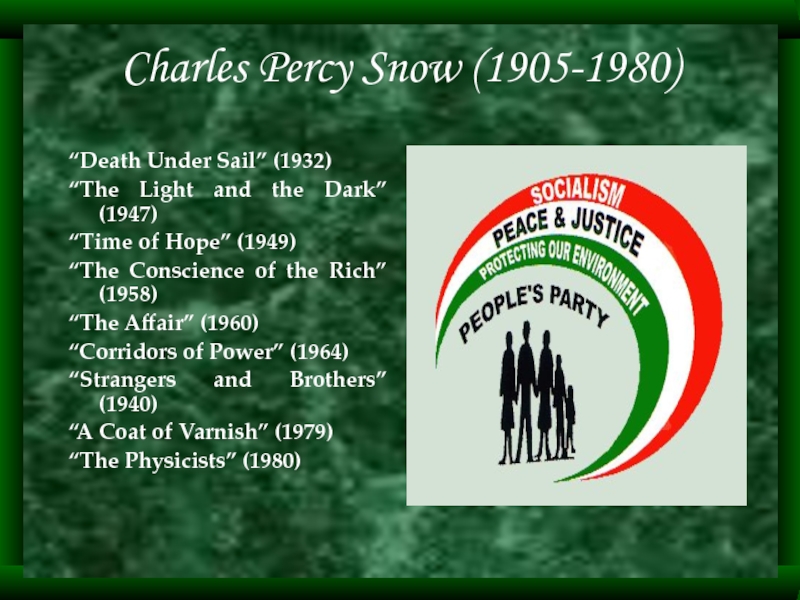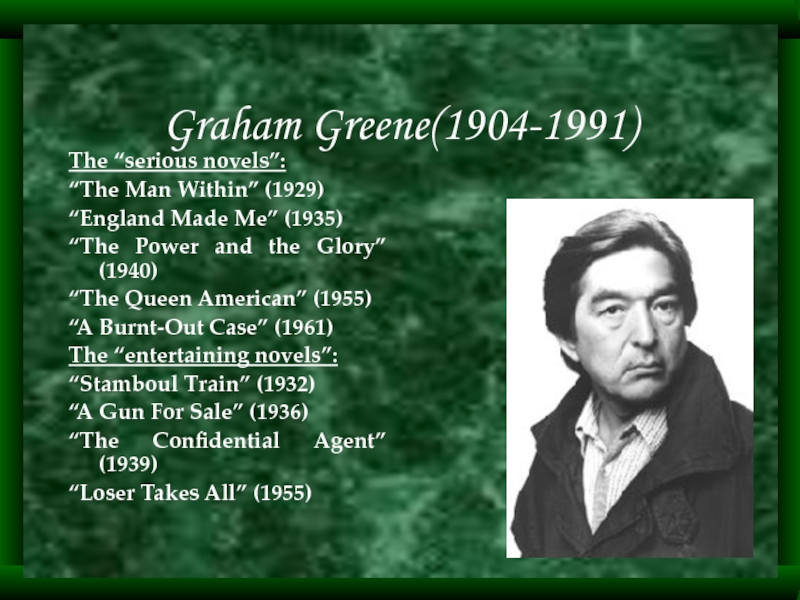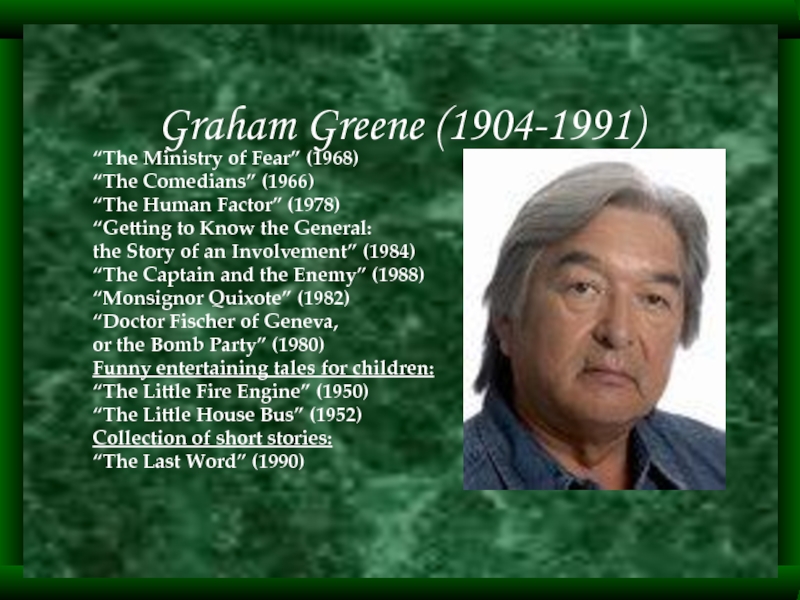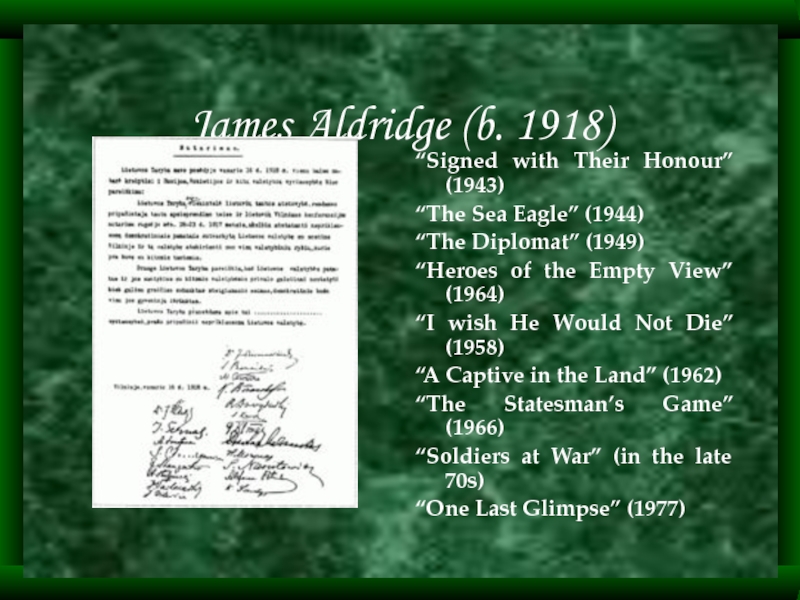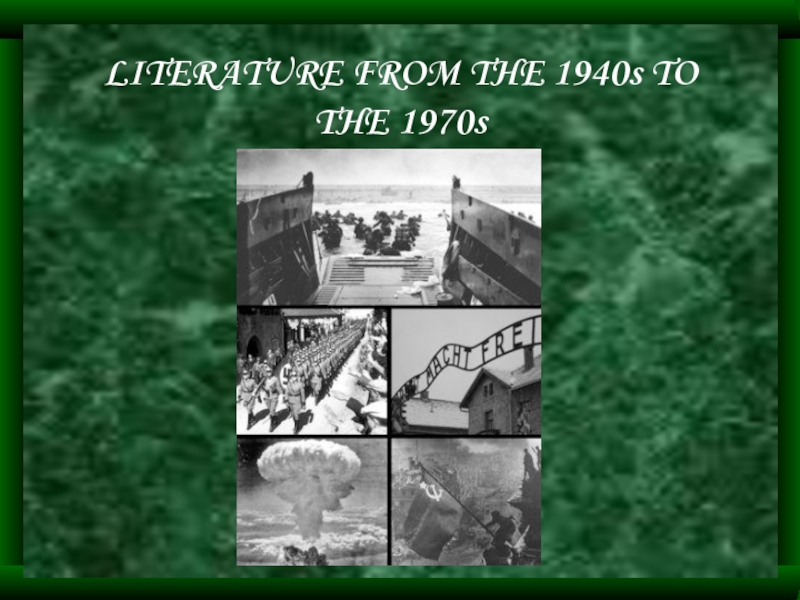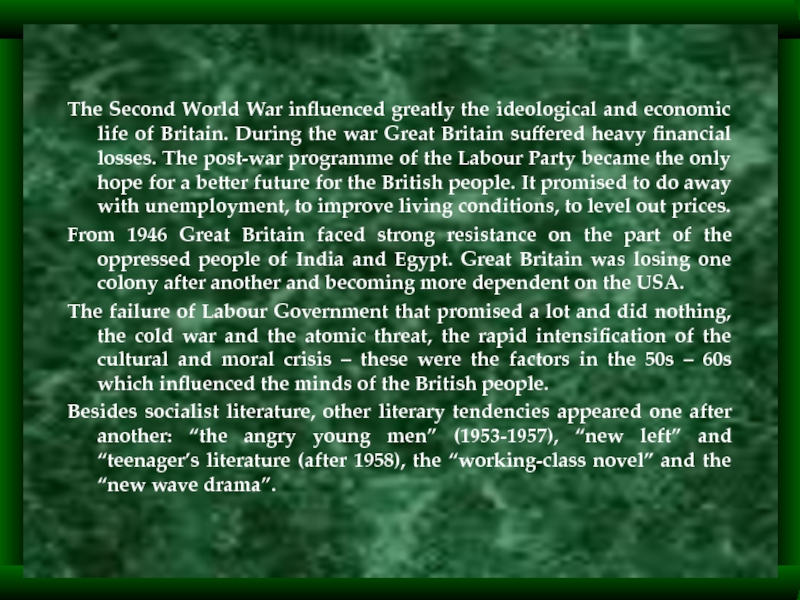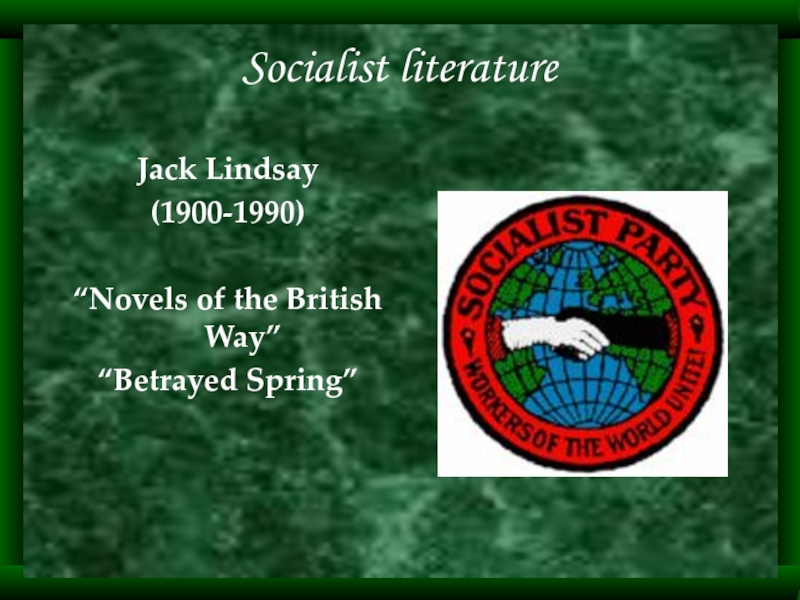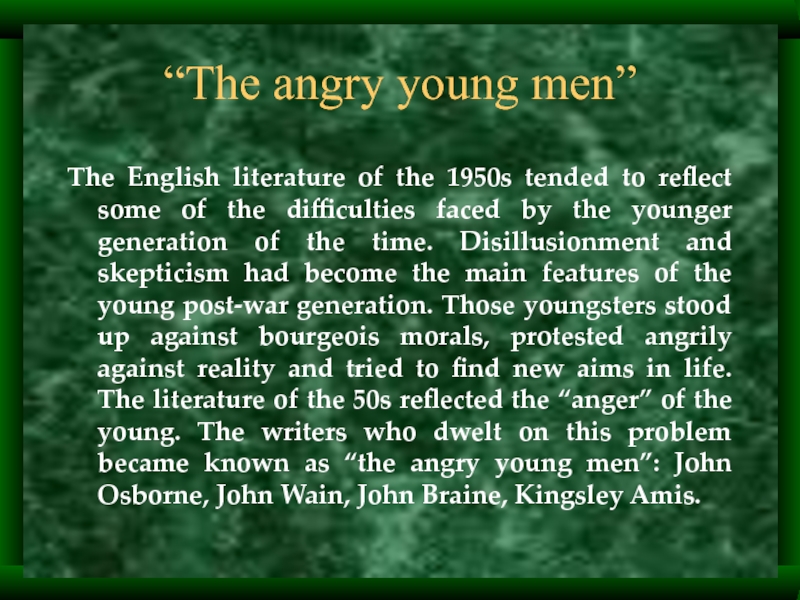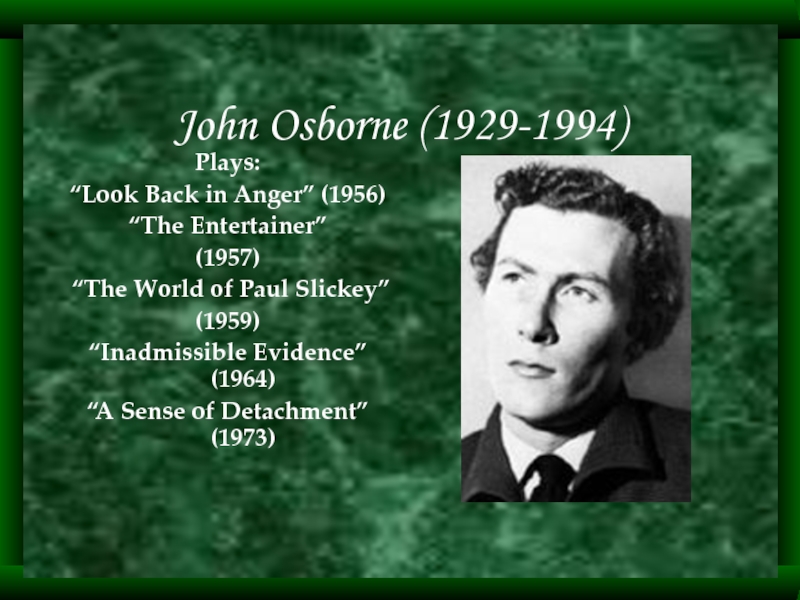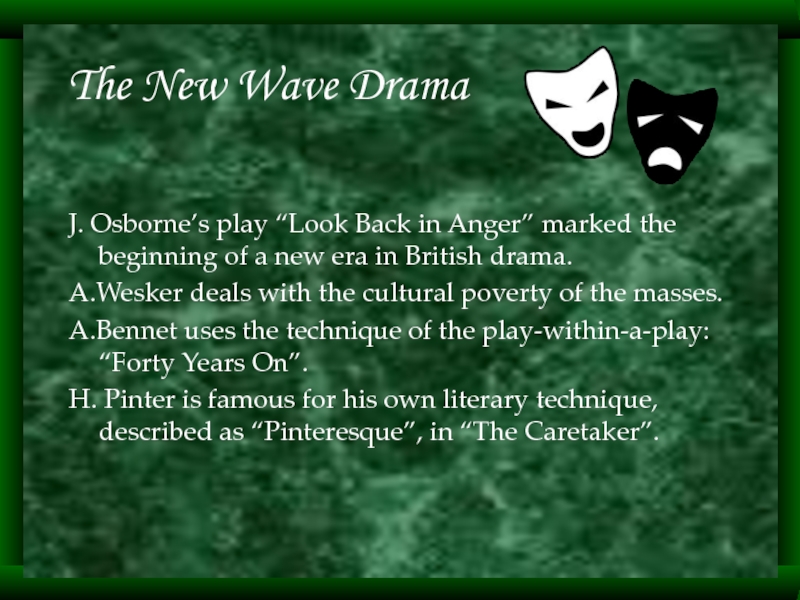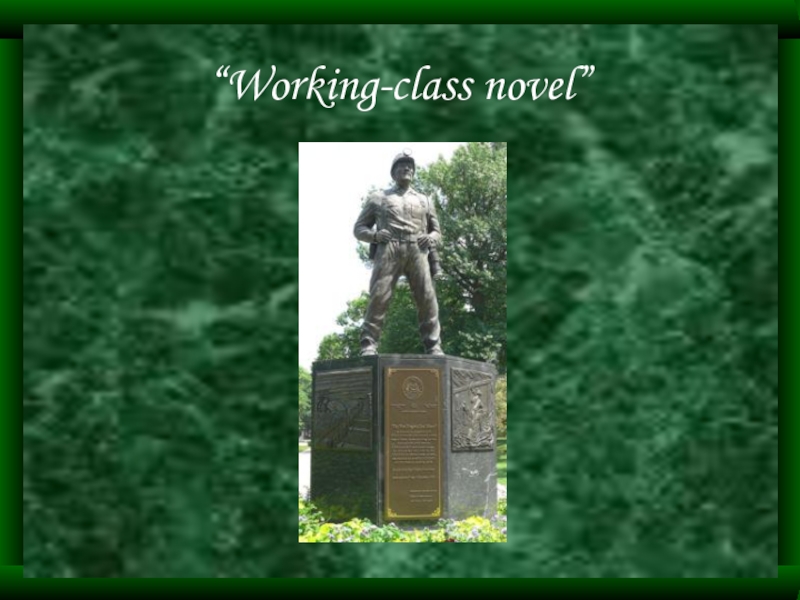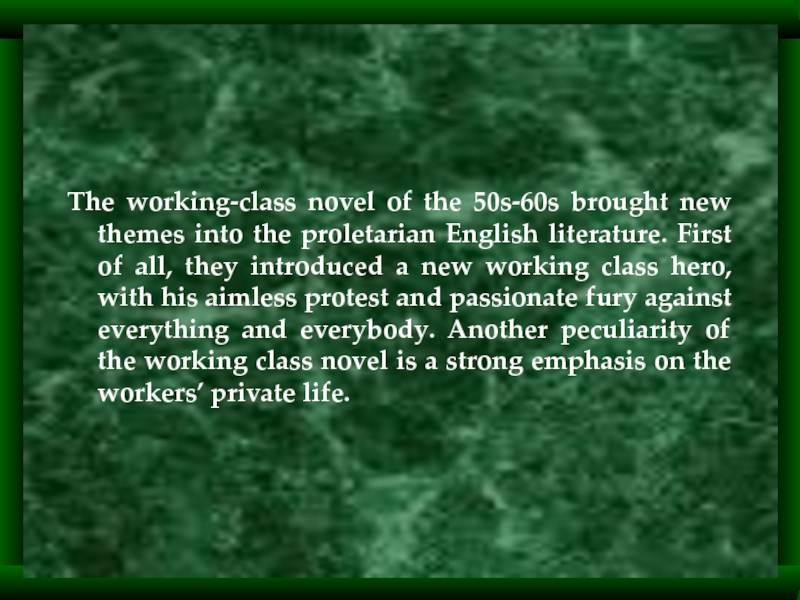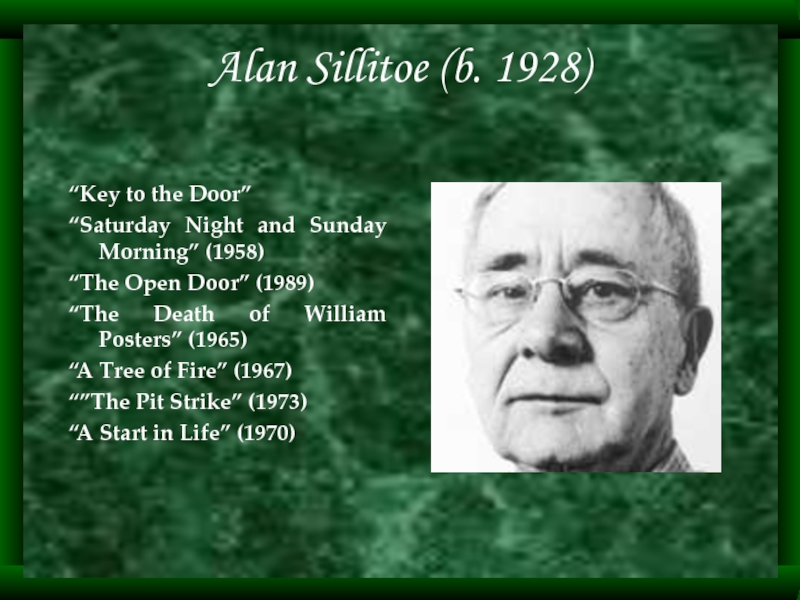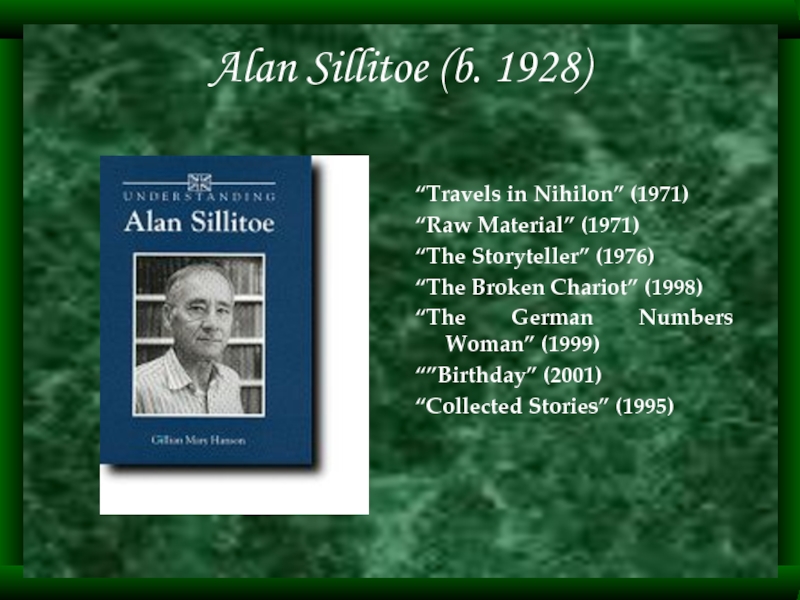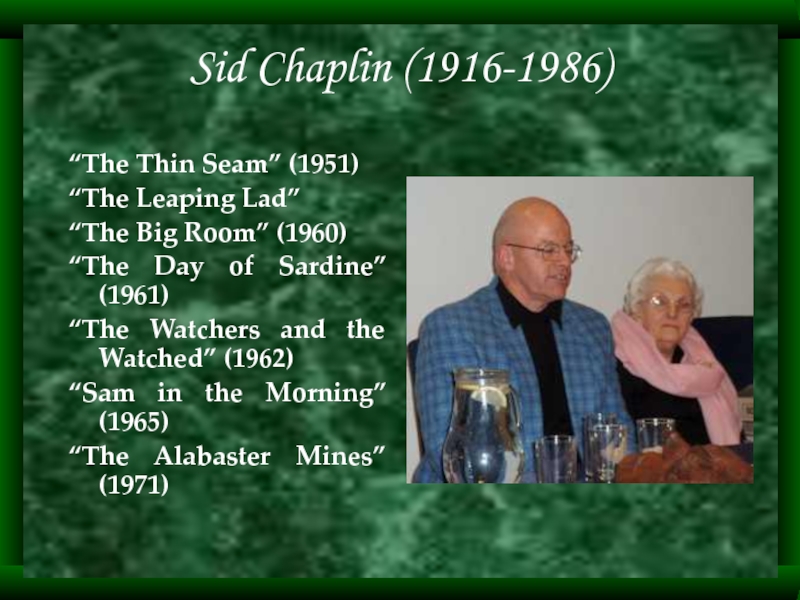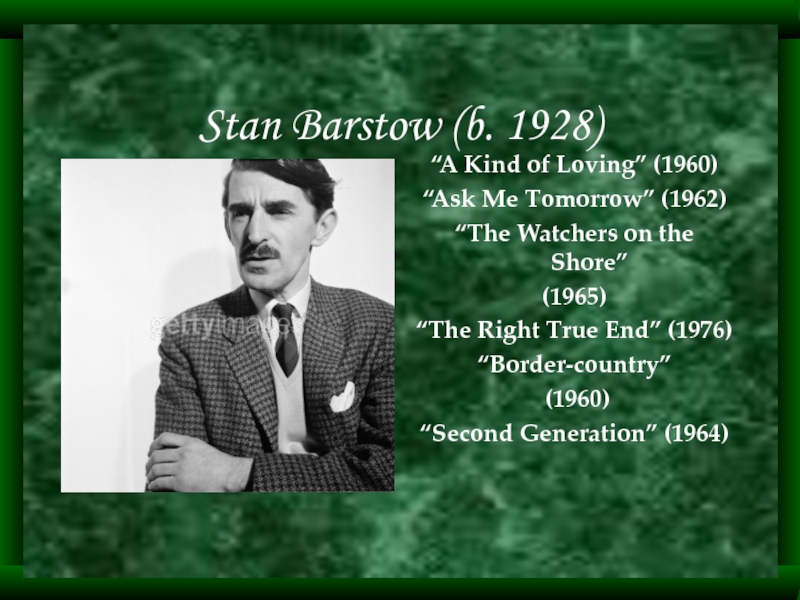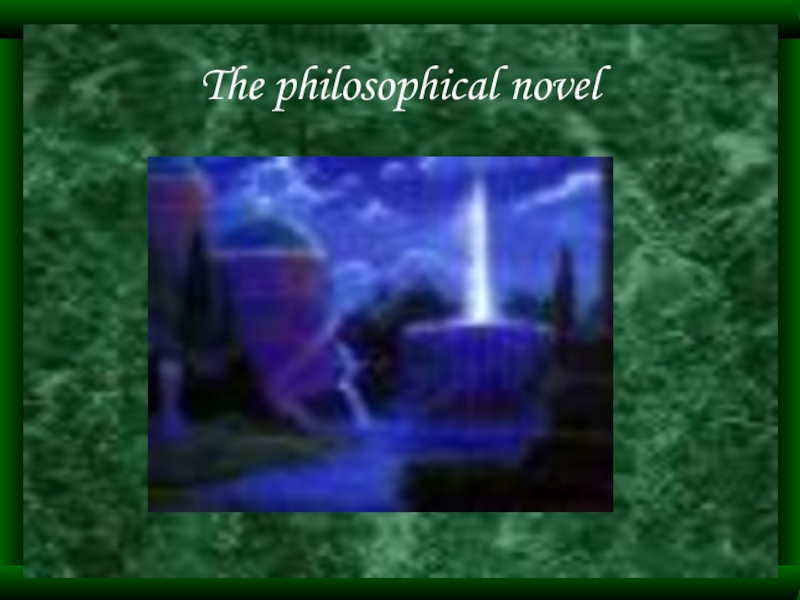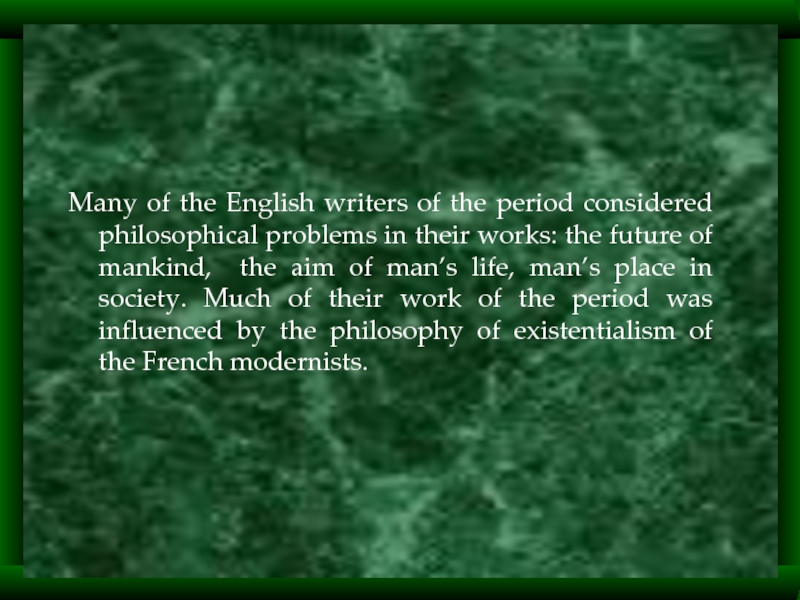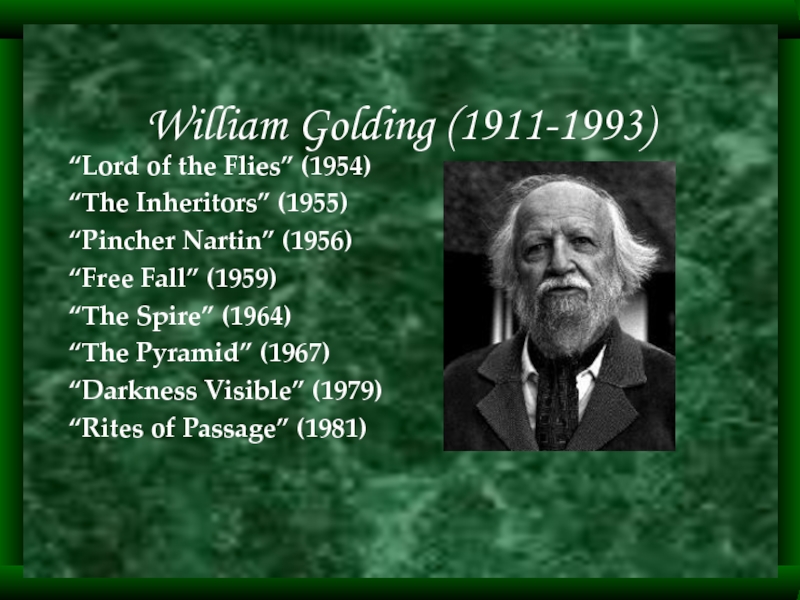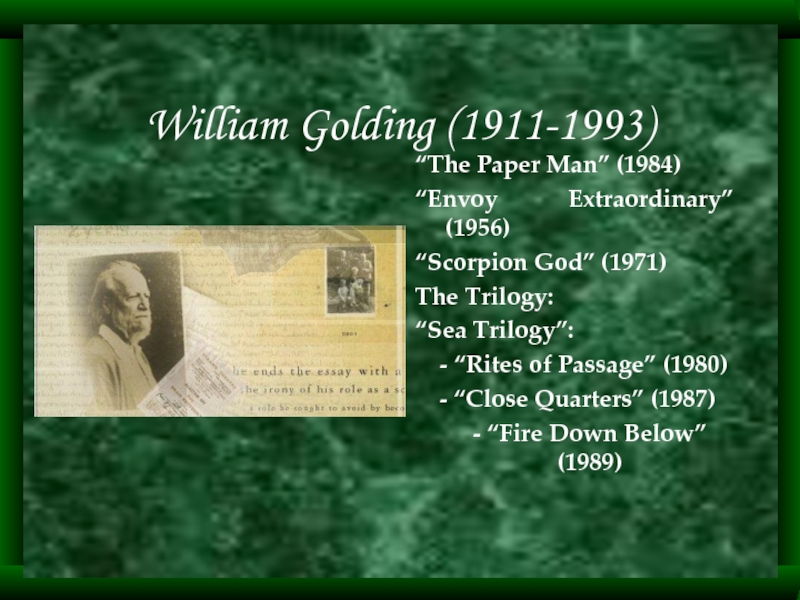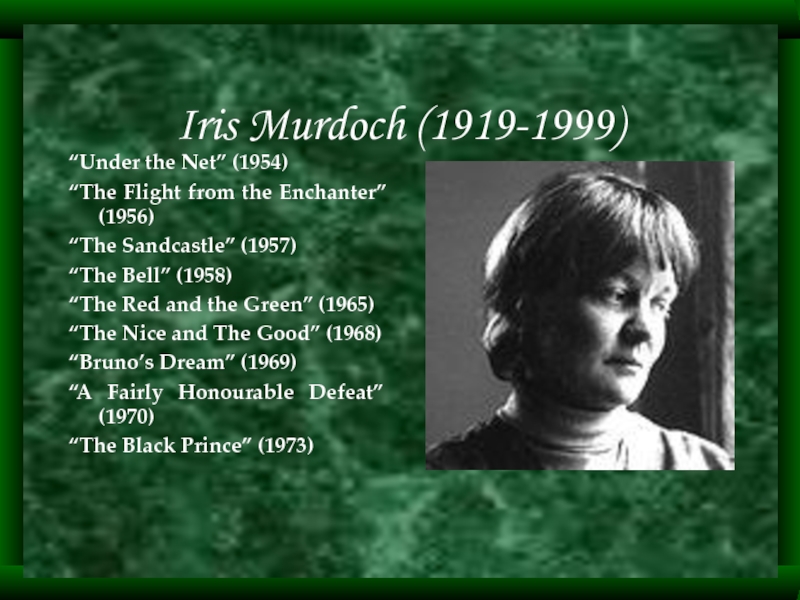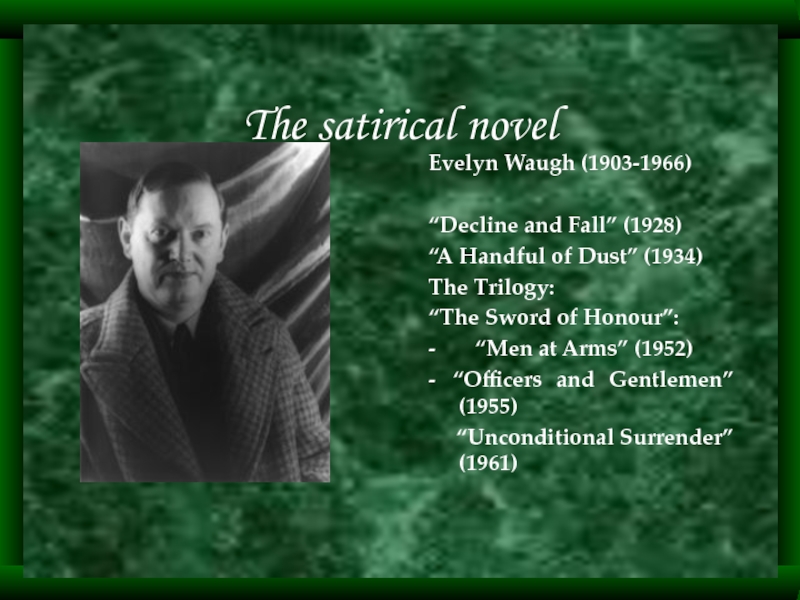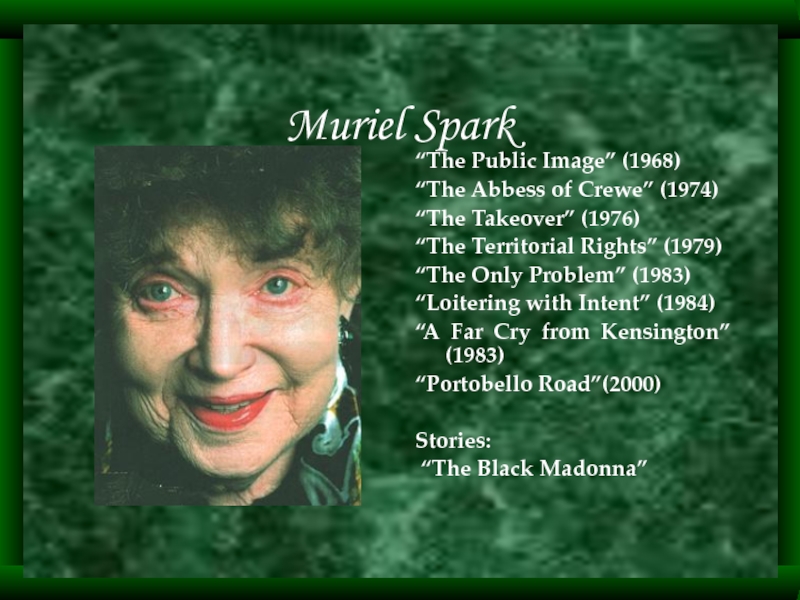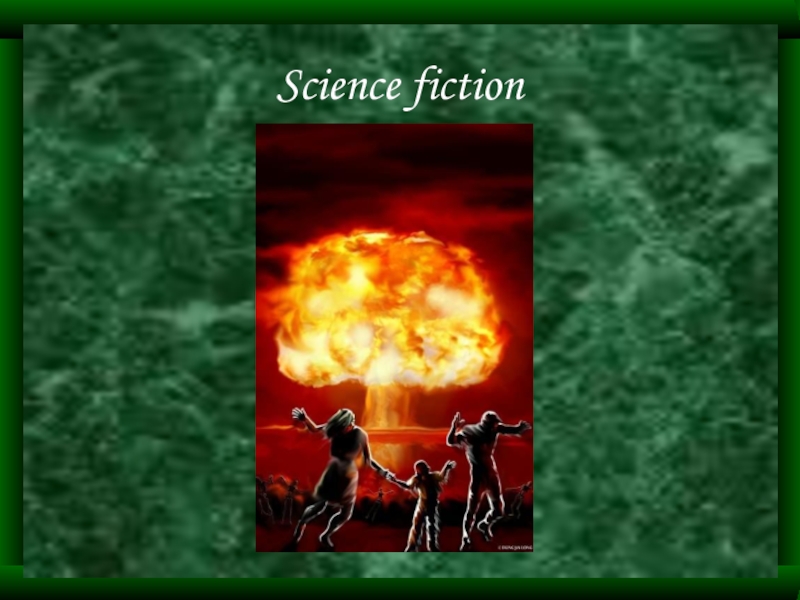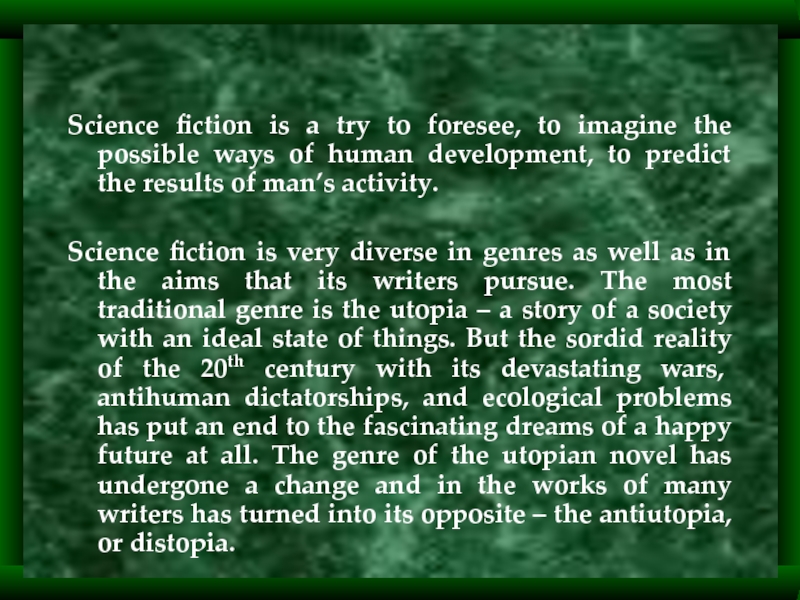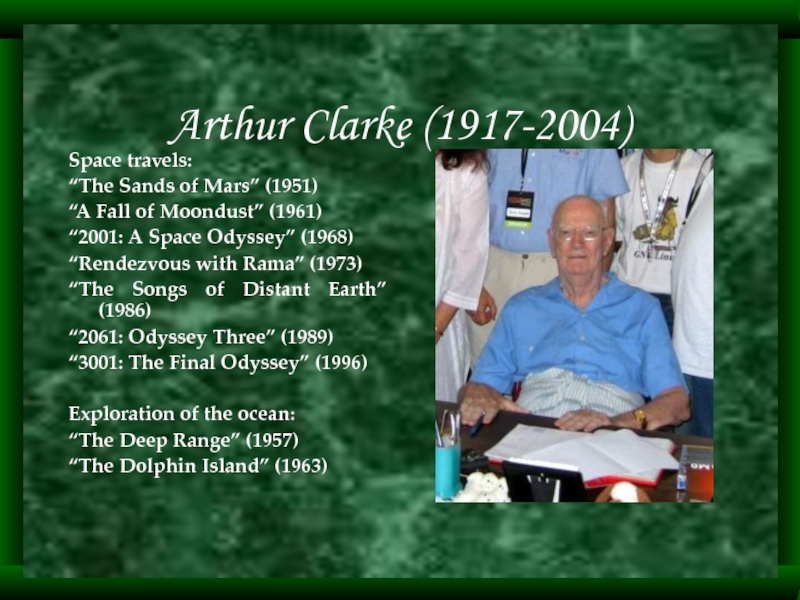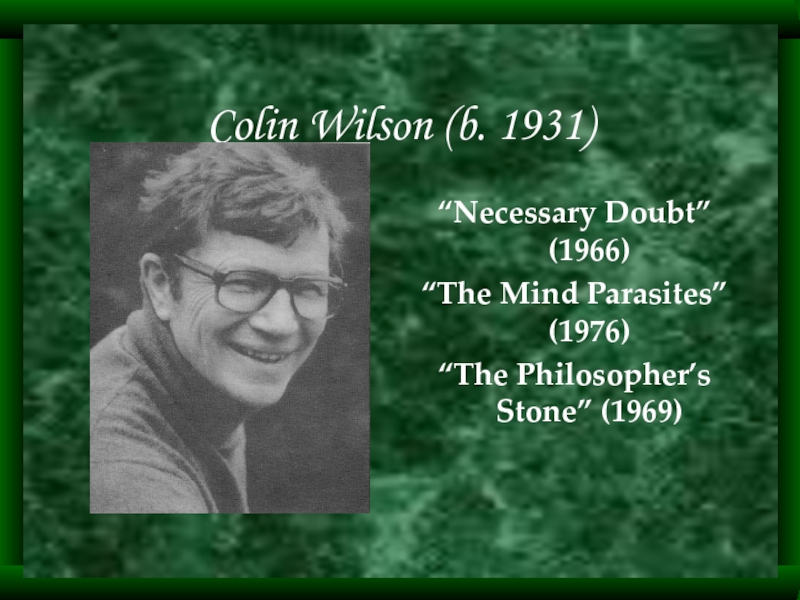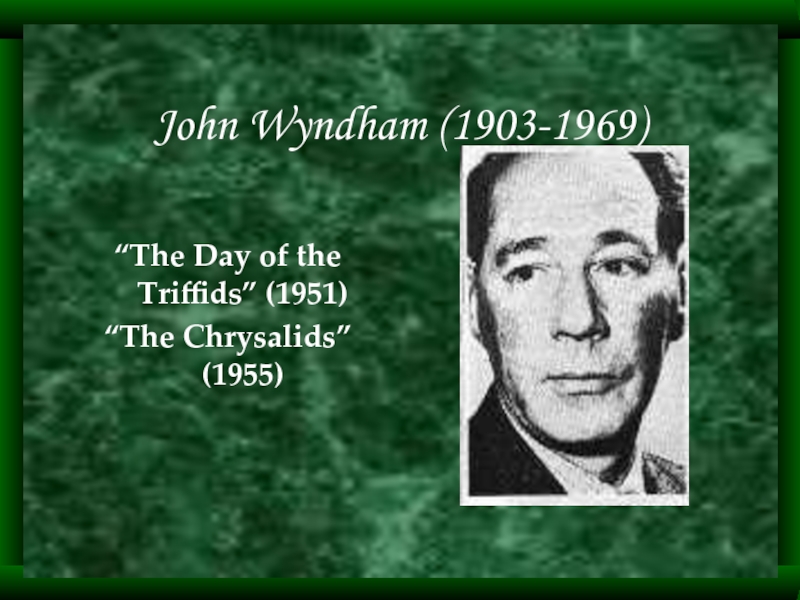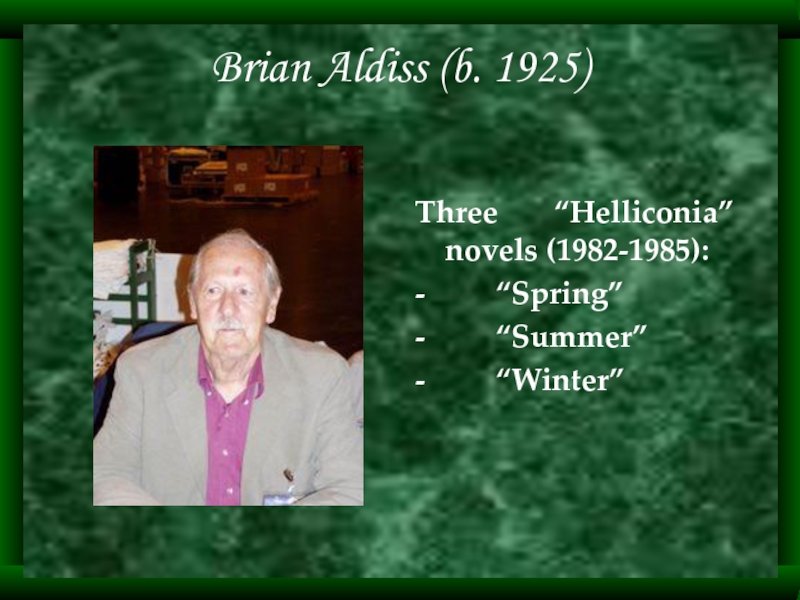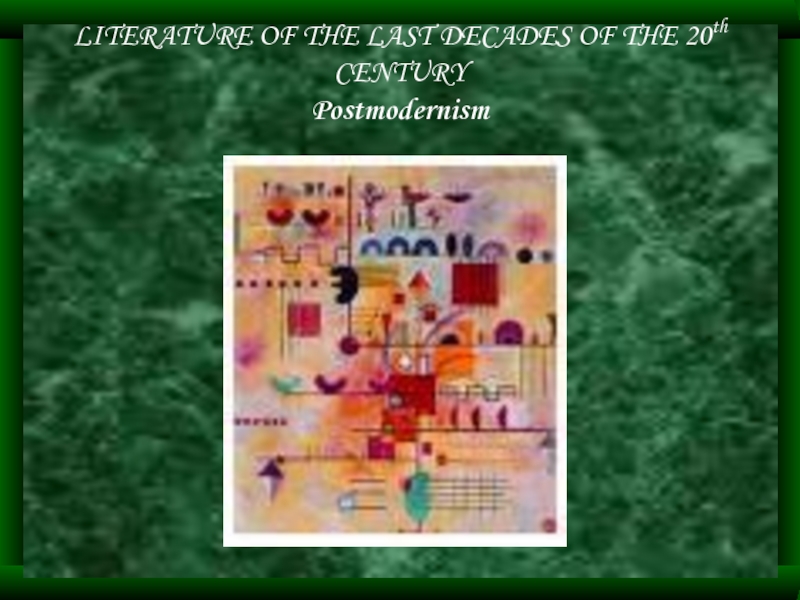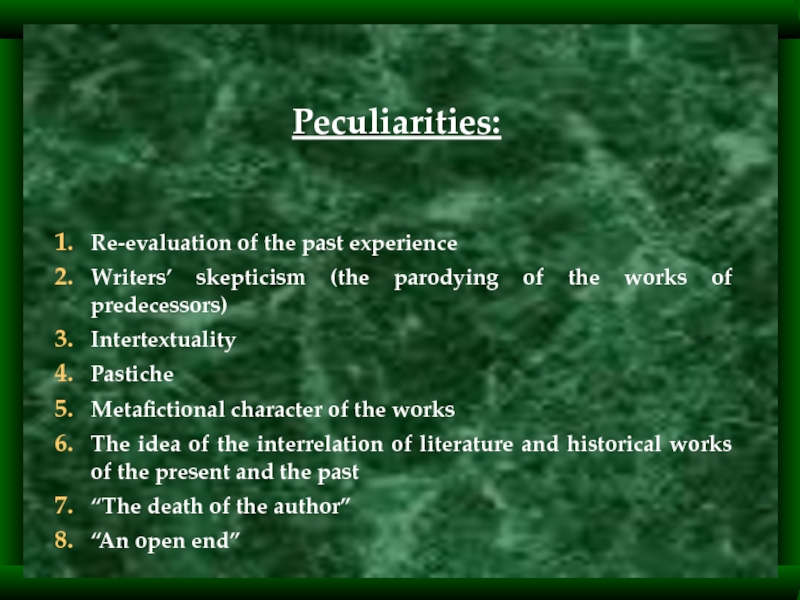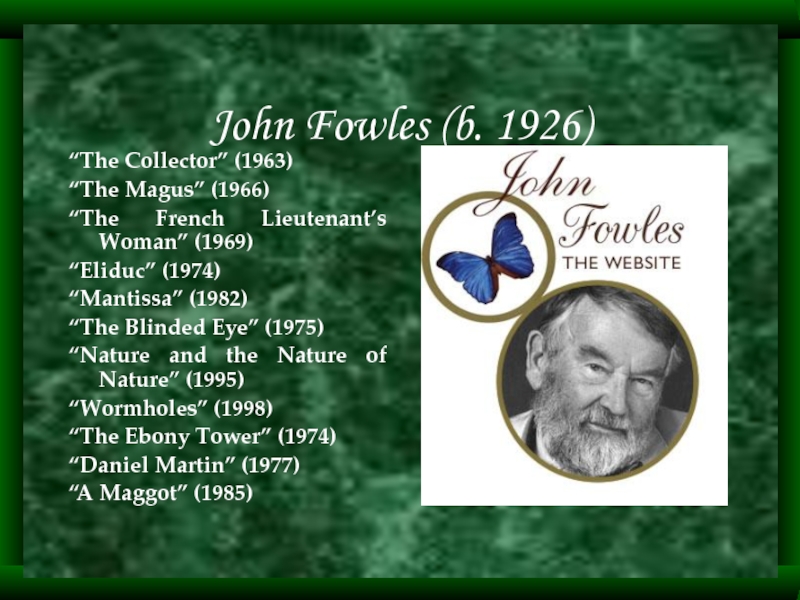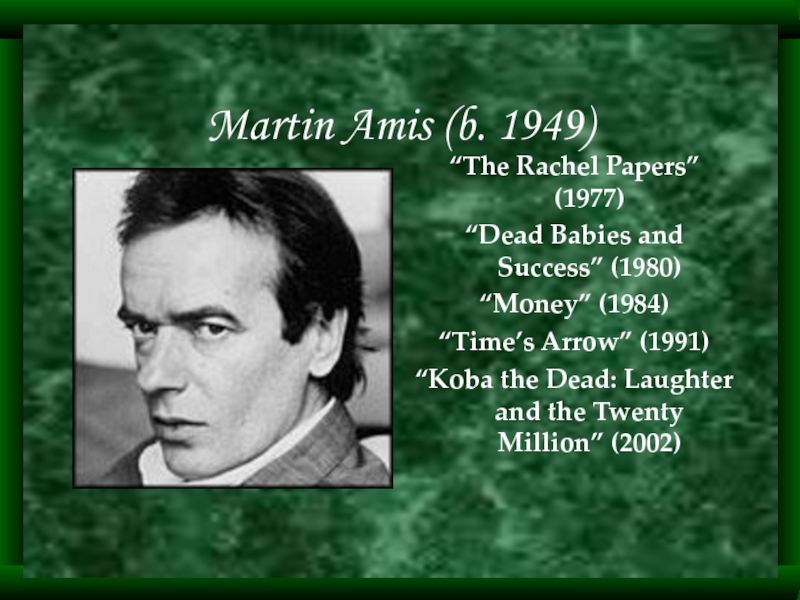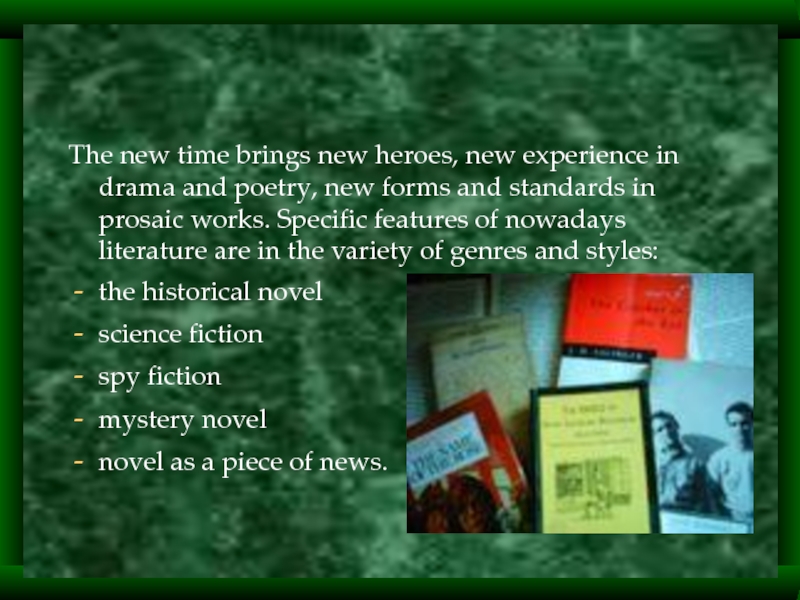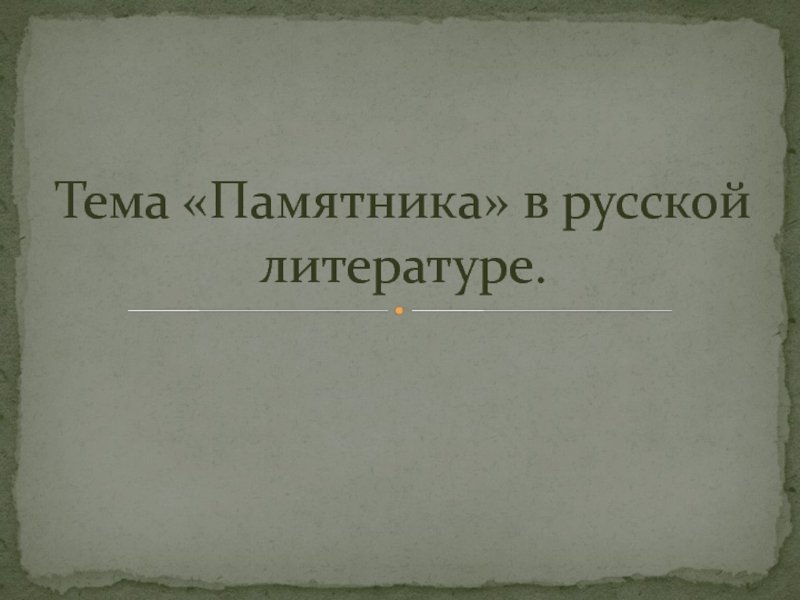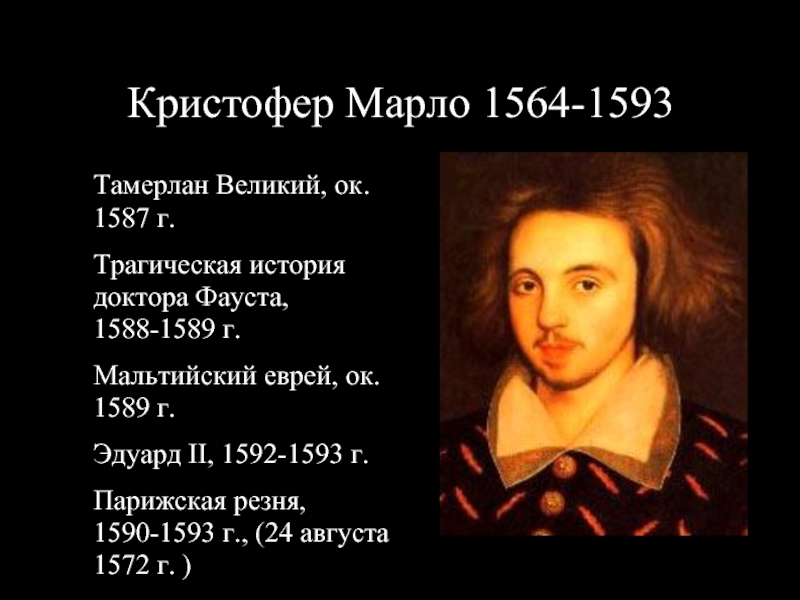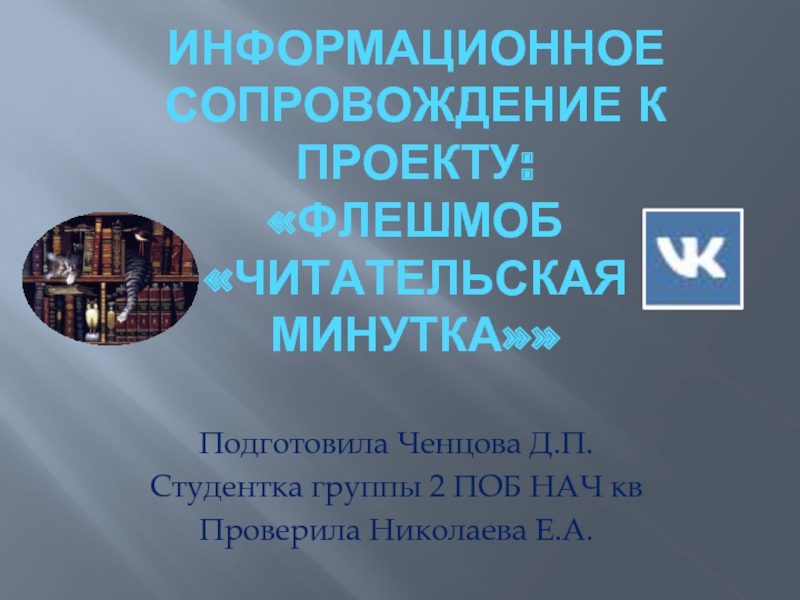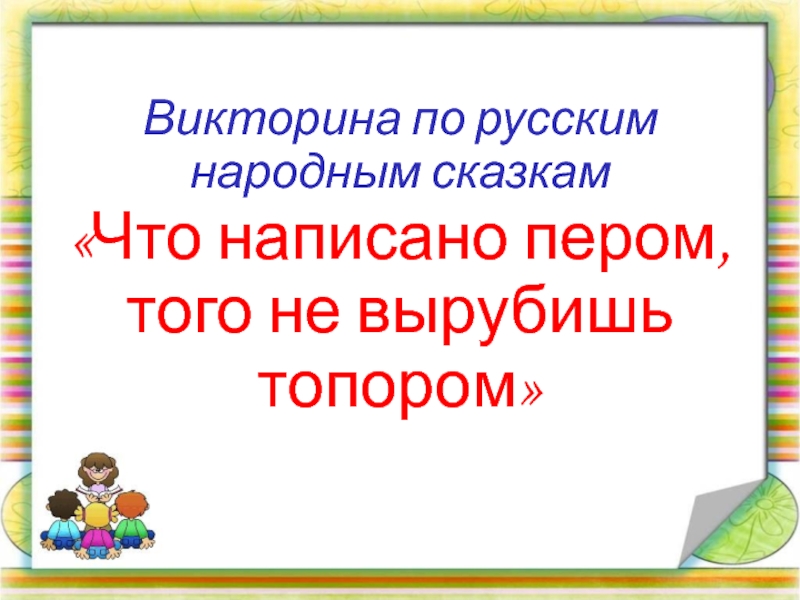- Главная
- Разное
- Дизайн
- Бизнес и предпринимательство
- Аналитика
- Образование
- Развлечения
- Красота и здоровье
- Финансы
- Государство
- Путешествия
- Спорт
- Недвижимость
- Армия
- Графика
- Культурология
- Еда и кулинария
- Лингвистика
- Английский язык
- Астрономия
- Алгебра
- Биология
- География
- Детские презентации
- Информатика
- История
- Литература
- Маркетинг
- Математика
- Медицина
- Менеджмент
- Музыка
- МХК
- Немецкий язык
- ОБЖ
- Обществознание
- Окружающий мир
- Педагогика
- Русский язык
- Технология
- Физика
- Философия
- Химия
- Шаблоны, картинки для презентаций
- Экология
- Экономика
- Юриспруденция
English literature from the middle ages to our days презентация
Содержание
- 1. English literature from the middle ages to our days
- 2. Anglo-Saxon Period (5th – 10th centuries)
- 3. The British history is considered to begin
- 4. Lyric Poems: “Widsith” “Seafarer” “The Wanderer” “Deor’s Complaint” “The Wife’s Lament” “The Husband’s Message”
- 5. Heroic epics: The works were focused
- 6. Riddles: “Hundred Riddles” by St. Aldhelm.
- 7. Poetry Poetry has survived in 4 manuscripts:
- 8. PROSE The Venerable Bede: “Ecclesiastical History of the English People”
- 9. Alfred The Great encouraged : - “The Anglo-Saxon Chronicle”
- 10. Aelfric
- 11. Alcuinus: 1. “Rhetoric” 2. “Grammar” 3. “Didactics”
- 12. Medieval Period (11-15 cent)
- 13. Anglo-Norman Period (11-13 cent) The Normans
- 14. Sir Thomas Malory:
- 15. The literature of the Church was
- 16. Pre-Renaissance (14th-15th centuries)
- 17. The 14th century was a difficult
- 18. William Langland: “The Vision of Piers the Ploughman”
- 19. John Gower: He wrote in three
- 20. Geoffrey Chaucer (1340 – 1400) He
- 21. Chaucer’s art has three periods: 1. The
- 22. LITERATURE OF THE RENAISSANCE (16th-17th century)
- 23. In the 15th-16th centuries capitalist relations began
- 24. The Rise of the Renaissance
- 25. The Height of the Renaissance (1558-1603)
- 26. William Shakespeare (1564-1616)
- 27. William Shakespeare (1564-1616) His literary
- 28. 1590 – 1600 This period was marked
- 29. The historical chronicles: “King Henry VI” (part
- 30. 1601-1608 Four great tragedies: The tragedies
- 31. 1609 – 1612
- 32. The Decline of the Renaissance
- 33. Ben Jonson (1572 –1637) He wrote
- 34. John Donne (1572 –1631) A group
- 35. LITERATURE OF THE ENLIGHTENMENT (The 18th century)
- 36. The Enlighteners defended the interests of the
- 37. Early Enlightenment (1688-1740) This period
- 38. Daniel Defoe (1660-1731) He is rightly
- 39. Jonathan Swift (1667-1745) He was the
- 40. Mature Enlightenment (1740-1750) Sentimentalism The didactic
- 41. Late Enlightenment (1750-1790) (Sentimentalism) The writers
- 42. PRE-ROMANTISISM (The end of the 18th century)
- 43. The Gothic School: Horace Walpole: “The
- 44. Robert Burns (1759-1796) He is a
- 45. William Blake (1757-1827) “Poetical Sketches” “Songs
- 46. LITERATURE OF THE EARLY 19th CENTURY ROMANTICISM
- 47. Lakists William Wordsworth (1770-1850), Samuel T. Coleridge
- 48. William Wordsworth (1770-1850) “Lyrical Ballads”
- 49. Samuel T. Coleridge (1772-1834) “Lyrical
- 50. Robert Southey (1774-1843) He was
- 51. George Gordon Noel Byron (1788-1824) He
- 52. The London Period (1812-1816) “Childe Harold’s
- 53. The Swiss Period (May-October 1816)
- 54. The Italian Period (1816-1823) “Childe
- 55. The Greek Period (1823-1824)
- 56. Percy Bysshe Shelley (1792-1822) “Queen
- 57. John Keats (1795-1821) He wrote poetry
- 58. Romanticism in Prose Thomas de Quincey
- 59. Charles Lamb (1775 –1834) Blank Verse, poetry,
- 60. William Hazlitt (1778 –1830) An Essay on
- 61. Leigh Hunt (1784 - 1859) Amyntas, A
- 62. Walter Scott (1771-1832) “The Mystrelsy of
- 63. His novels are divided into three groups
- 64. “Ivanhoe” “The Abbot” “The Pirate” “The
- 65. 3. Novels based on the history of
- 66. Jane Austen (1775-1817) “Emma” “Pride
- 67. LITERATURE FROM THE 1830s TO THE 1860s VICTORIAN LITERATURE
- 68. Chartist Literature The industrial power of Great
- 69. Early Victorian Literature Charles Dickens
- 70. The second period: “David Copperfield” “Dombey
- 71. Elizabeth Gaskell (1810-1865) She wrote
- 72. The Bronte Sisters: Charlotte Bronte: “Jane Eyre”,
- 73. William Makepeace Thackeray (1811-1863) “The
- 74. Poetry G.A.Tennyson (1801-1892): “Maud” “The
- 75. Robert Browning (1812-1889) “Paracelsus” “The
- 76. Elizabeth Barrett Browning (1806-1861) “The Cry
- 77. Late Victorians POSITIVISM
- 78. Novels: “The Egoist” “Beauchamp’s Career” George Meredith (1829-1909)
- 79. Thomas Hardy (1814-1928) “The
- 80. Samuel Butler : “The Way of All Flesh” “Erewhon”
- 81. LITERATURE OF THE LAST DECADES OF
- 82. Decadence Manifested itself in impressionism, imagism, futurism, symbolism.
- 83. The most widely known manifestation of Decadence
- 84. Oscar Wilde (1854-1900) He was the
- 85. Comedies: “An Ideal Husband” (1895)
- 86. Tragedies “Salome” “The Duchess of Padua”
- 87. Fairy tales: “The Happy Prince
- 88. Late Victorian Poetry Dante Gabriel
- 89. Neoromanticism “Art in contemporary society is only necessary for entertainment”
- 90. Robert Louis Stevenson (1850-1894) The novels:
- 91. Rudyard Kipling (1865-1936) Poetry: “Departmental
- 92. Joseph Conrad (1857 –1924) “Lord Jim” “Almayer’s
- 93. Socialist Literature William Morris
- 94. LITERATURE OF THE EARLY 20th CENTURY
- 95. The Boer War lasted from October 1899
- 96. John Galsworthy (1867-1933) “The Island of
- 97. John Galsworthy (1867-1933) Each trilogy has Interludes
- 98. Herbert George Wells (1866-1946) “Russia
- 99. George Bernard Shaw (1856-1950) Comedies:
- 100. George Bernard Shaw (1856-1950) Three
- 101. LITERATURE BETWEEN THE TWO WORLD WARS
- 102. English writers reacted differently to the
- 103. Modernism James Joyce
- 104. Virginia Woolf (1882–1941)
- 105. D. H. Lawrence (1885-1930) Novels: “Sons
- 106. Modernism in Poetry Thomas Stearns Eliot
- 107. Critical Realism Katherine Mansfield (1888-1923)
- 108. “The Garden Party and Other Stories”
- 109. William Somerset Maugham (1874-1965) Novels: “Liza
- 110. Social Realism Ralf Fox (1900-1937) An
- 111. There are many novels
- 112. Richard Aldington (1892-1962) (Lost Generation) “The
- 113. George Orwell (Eric Arthur Blair) (1903-1950)
- 114. John Boynton Priestley (1894-1984) He wrote
- 115. Aldous Huxley (1894-1963) “Crome
- 116. Archibald Joseph Cronin (1896-1980) “Hatter’s Castle”
- 117. Charles Percy Snow (1905-1980) “Death Under
- 118. Graham Greene(1904-1991) The “serious novels”:
- 119. Graham Greene (1904-1991) “The Ministry
- 120. James Aldridge (b. 1918) “Signed
- 121. LITERATURE FROM THE 1940s TO THE 1970s
- 122. The Second World War influenced greatly the
- 123. Socialist literature Jack Lindsay (1900-1990)
- 124. The English literature of the 1950s
- 125. John Osborne (1929-1994) Plays: “Look
- 126. The New Wave Drama J.
- 127. “Working-class novel”
- 128. The working-class novel of the
- 129. Alan Sillitoe (b. 1928) “Key
- 130. Alan Sillitoe (b. 1928) “Travels in
- 131. Sid Chaplin (1916-1986) “The Thin Seam”
- 132. Stan Barstow (b. 1928) “A
- 133. The philosophical novel
- 134. Many of the English writers of
- 135. William Golding (1911-1993) “Lord of
- 136. William Golding (1911-1993) “The Paper
- 137. Iris Murdoch (1919-1999) “Under the
- 138. The satirical novel Evelyn Waugh
- 139. Muriel Spark “The Public Image”
- 140. Science fiction
- 141. Science fiction is a try to foresee,
- 142. Arthur Clarke (1917-2004) Space travels:
- 143. Colin Wilson (b. 1931)
- 144. John Wyndham (1903-1969)
- 145. Brian Aldiss (b. 1925) Three
- 146. LITERATURE OF THE LAST DECADES OF THE 20th CENTURY Postmodernism
- 147. Peculiarities: Re-evaluation of the
- 148. John Fowles (b. 1926) “The
- 149. Martin Amis (b. 1949) “The
- 150. The new time brings new
Слайд 3The British history is considered to begin in the 5th century,
In those early days epic poems were created in many countries, such as: “Iliad” and “Odyssey” by Homer.
The main literary forms of the period were: lyric, riddle, epic and prose.
Слайд 4Lyric Poems:
“Widsith”
“Seafarer”
“The Wanderer”
“Deor’s Complaint”
“The Wife’s Lament”
“The Husband’s Message”
Слайд 5Heroic epics:
The works were focused on the deeds of the brave
“The Song of Beowulf”
“The Battle of Brunanburgh”
“The Battle of Waldon”
“The Fight of Finnsburg”
Слайд 7Poetry
Poetry has survived in 4 manuscripts:
1. The Song of Beowulf”
2. “Exeter
3. “Caedmon Book”:
4. “Vercelli Book”
The earliest definitely known English poets are Caedmon and Cynewulf.
Слайд 13Anglo-Norman Period
(11-13 cent)
The Normans came from the north-west of France. They
Слайд 15
The literature of the Church was scholastic, moralistic, and it supported
Prosaic works started to appear in monasteries
(13th cent)
Слайд 17
The 14th century was a difficult time for England. The country
Слайд 19John Gower:
He wrote in three languages:
“Speculum Meditantis” – in French
“Vox Clamantis”
“Confessio Amantis” - in English
Слайд 20Geoffrey Chaucer (1340 – 1400)
He was the greatest writer of
Слайд 21Chaucer’s art has three periods:
1. The French period – imitation of
2. The Italian period – “The House Of Fame”, “The Parliament Of Fowls”, “The Legend of Good Women’’ and others.
3. The English period – “The Canterbury Tales”
Слайд 23In the 15th-16th centuries capitalist relations began to develop in Europe.
1. The Rise of the Renaissance (1500-1558)
2. The Height of the Renaissance (1558-1603)
3. The Decline the Renaissance (1603-1649)
Слайд 24
The Rise of the Renaissance
(1500-1558)
Thomas Wyatt and Henry Surrey introduced
Thomas More wrote
“Utopia”
Слайд 27William Shakespeare (1564-1616)
His literary work can be divided into three periods:
1590
1601 – 1608
1609 – 1612
Слайд 281590 – 1600
This period was marked by optimism:
Comedies:
“The Comedy of Errors”
“The Taming of the Shrew” (1593)
“The Two Gentlemen of Verona” (1594)
“Love’s Labour’s Lost” (1594)
“A Midsummer Night’s Dream” (1595)
“Much Ado About Nothing” (1598)
“The Merry Wives of Windsor” (1599)
“As You Like It” (1599)
“Twelfth Night, or What You Will” (1600)
Слайд 29The historical chronicles:
“King Henry VI” (part II) 1590
“King Henry VI” (part
“King Henry VI” (part I) 1591
“The Tragedy of King Richard III” (1592)
“The Tragedy of King Richard II” (1595)
“The Life and The Death of King John” (1596)
“The King Henry IV” (part I) 1597
“The King Henry IV” (part II) 1597
“The Life of King Henry V” (1598)
Drama:
“The Merchant of Venice”
Tragedies:
“Romeo and Juliet”
“Julius Caesar”
Collection of sonnets
was edited in 1609
Слайд 301601-1608
Four great tragedies:
The tragedies reflect the deep, insoluble contradictions of
“Hamlet, Prince of Denmark (1601)
“Othello, the Moor of Venice” (1604)
“King Lear” (1605)
“Macbeth” (1605)
Слайд 31
1609 – 1612
The plays of this period differ from everything Shakespeare
Romantic dramas:
“Cymbeline” (1609)
“The Winter’s Tale” (1610)
“The Tempest” (1612)
Слайд 32
The Decline of the Renaissance
(1603-1649)
John Milton (1608 – 1674):
“Paradise Lost”
“Paradise
“Samson Agonistis”
His other works:
“L’Allegro”,
“Il Penseroso”
“Comus”
“Lycidas”
“Aeropagitica”
Слайд 33Ben Jonson
(1572 –1637)
He wrote over 20 plays alone, and others with
Every Man in His Humour (performed 1598)
Every Man out of His Humour (performed 1599)
Volpone the Fox (1605-6)
Epicoene, The Silent Woman (performed 1609)
The Alchemist (performed 1610)
Bartholomew Fair (performed 1614)
Слайд 34John Donne
(1572 –1631)
A group of poets, known as the Metaphysical
Poetry
Слайд 36The Enlighteners defended the interests of the common people – craftsmen,
In the period of Enlightenment the poetic forms of the Renaissance were replaced by prose. The didactic novel was born and became the leading genre of the period. Ordinary people, mostly representatives of the middle class, became the heroes of these novels. The characters, either good or bad, were accordingly, either rewarded or punished at the end of the novel. By these means the Enlighteners hoped to improve the morals of the people and society in general.
Слайд 37 Early Enlightenment (1688-1740)
This period saw a flowering of journalism (J.Addison
Satirical poet – Alexander Pope, imitated the style of ancient Greek and Roman poets:
“The Rape of the Lock”
“The Dunciad”
Слайд 38Daniel Defoe (1660-1731)
He is rightly considered the father of the
- “An Essay on Projects” (1697)
- “The Shortest Way with the Dissenters” (1702)
- “Hymn to the Pillory”
- “The Life and the Strange Surprising Adventures of Robinson Crusoe” (1719)
- “Captain Singleton”
- “Moll Flanders”
- “Roxana”
Слайд 39Jonathan Swift (1667-1745)
He was the greatest satirist in English literature.
“Journal for
The allegory:
- “A Tale of a Tub”
The satire:
- “A Modest Proposal for Preventing the Children of Poor People of Ireland from Being a Burden to their Parents” (1729)
The novel:
- “Gulliver’s Travels” (1726)
Слайд 40Mature Enlightenment (1740-1750)
Sentimentalism
The didactic social novel was born in this
Samuel Richardson:
“Pamela, or Virtue Rewarded”
“Clarissa, or the History of a Young Lady”
Henry Fielding:
“The History of Tom Jones, a Foundling”
“The Life and Death of Jonathan Wild,
the Great”
Tobias Smollett:
“The Expedition of Humphrey Clinker”
Слайд 41Late Enlightenment (1750-1790)
(Sentimentalism)
The writers expressed the democratic bourgeois tendencies of
Oliver Goldsmith:
“The Vicar of Wakefield”
Lawrence Sterne:
“Tristram Shandy”
“A Sentimental Journey
through France and Italy”
Richard Brinsley Sheridan:
“School for Scandal”
Слайд 43The Gothic School:
Horace Walpole:
“The Castle of Otranto”
Ann Randcliffe:
“The Mysteries of Udolpho”
Mathew
“The Monk”
Mary Shelley:
“Frankenstein"
Слайд 44Robert Burns (1759-1796) He is a national poet of both Scotland
“The Scots Musical Museum”
“Select Collection of Original Scottish Airs”
- “Poems Chiefly in the Scottish Dialect” (1786)
Poems:
- “My Heart’s in the Highlands”
- “Bruce’s Address to his Army at Bannockburn”
- “Is There for Honest Poverty”
- “Revolutionary Lyric”
- “The Tree of Liberty”
- “The Jolly Beggars”
- “John Barleycorn”
- “Oh, My Love is Like a Red, Red Rose”
- “Auld Lang Syne”
- “The Toadeater”
Слайд 45William Blake (1757-1827)
“Poetical Sketches”
“Songs of Innocence”
“Songs of Experience”
“The Marriage of Heaven
“Milton”, and others
Слайд 47Lakists
William Wordsworth (1770-1850),
Samuel T. Coleridge (1772-1834),
Robert Southey (1774-1843)
formed the “Lake
They dedicated much of what they wrote to Nature.
W. Wordsworth and S. Coleridge published a collection of poems “Lyrical Ballads” (1798)
Слайд 48William Wordsworth (1770-1850)
“Lyrical Ballads” (1798)
“Westminster Bridge”
“London, 1802”
“The Daffodils”
“The Prelude”( in 14
“The Excursion” (in 9 books)
Слайд 49Samuel T. Coleridge (1772-1834)
“Lyrical Ballads” (1798)
“The Rime of the Ancient Mariner”
“Christabel”
“Kubla
Слайд 50Robert Southey (1774-1843)
He was a poet who also wrote biographies,
Слайд 51George Gordon Noel Byron (1788-1824)
He is the greatest romantic revolutionary poet
Byron’s creative work is usually divided into four periods:
The London Period (1812-1816)
The Swiss Period (May-October 1816)
The Italian Period (1816-1823)
The Greek Period (1823-1824)
Слайд 52The London Period (1812-1816)
“Childe Harold’s Pilgrimage” – the first two cantos.
“Hebrew
“The Corsair”
“The Bride of Abydos”
“Lara”
“Ode to the Framers
of the Frame Bill”
Слайд 53The Swiss Period (May-October 1816)
“Childe Harold’s Pilgrimage” – the third
“The Prisoner of Chillon”
“Manfred”
Слайд 54The Italian Period (1816-1823)
“Childe Harold’s
Pilgrimage” – the last canto.
“Cain”
“Beppo”
“Don
Слайд 55The Greek Period (1823-1824)
“On This Day I Complete My Thirty-Sixth
“Cephalonian Journal”
Слайд 56Percy Bysshe Shelley (1792-1822)
“Queen Mab”
“Adonais”
“Prometheus Unbound”
“The Cloud”
“To a Skylark”
“The Indian Serenade”
Слайд 57John Keats (1795-1821)
He wrote poetry of rich detail.
1. “Poems by
2. “Endymion”(1818)
3. “Lamia, Isabella, The Eve of St.Agness” (1820)
Слайд 58Romanticism in Prose
Thomas de Quincey
(1785 –1859)
Confessions of an English
On the Knocking at the Gate in Macbeth, 1823
Walladmor, 1825
Lake Reminscences, 1834-40
The Logic of the Political Economy, 1844
Suspiria de Profundis, 1845
Autobiographical Sketches, 1853
Romances and Extravaganzas, 1877
Collected Writings, 1889
The Posthumous Works, 1891-93
Memorials, 1891
The Diary, 1928
Слайд 59Charles Lamb
(1775 –1834)
Blank Verse, poetry, 1798
Pride's Cure, poetry, 1802
Tales from Shakespeare,
The Adventures Of Ulysses, 1808
Specimens of English dramatic poets who lived about the time of Shakespeare, 1808
On The Tragedies Of Shakepeare, 1811
Essays Of Elia, 1823
The Last Essays Of Elia, 1833
Слайд 60William Hazlitt
(1778 –1830)
An Essay on the Principles of Human Action (1805)
Lectures
Lectures on the English Poets (1818)
Lectures on the English Comic Writers (1819)·
The Spirit of the Age (1825)
On The Pleasure of Hating (c.1826)
Слайд 61Leigh Hunt
(1784 - 1859)
Amyntas, A Tale of the Woods (1820)·
The Seer,
Stories from the Italian Poets (1846)
One Hundred Romances of Real Life (1843)
Слайд 62Walter Scott (1771-1832)
“The Mystrelsy of the Scottish Border” – legends
“The Lay of the Last Minstrel”
“Marmion”
“The Lady of the Lake”
Poetry:
Слайд 63His novels are divided into three groups
1. Novels devoted to
“Waverley” (1814)
“The Antiquary”
“Old Mortality”
“Black Dwart”
“The Heart of Midlothian”,
and others
Слайд 64
“Ivanhoe”
“The Abbot”
“The Pirate”
“The Monastery”,
and others
2. Novels which refer to the English
Слайд 66Jane Austen (1775-1817)
“Emma”
“Pride and Prejudice”
“Sense and Sensibility”
“Persuasion”
“Mansfield Park”
“Northanger Abbey”
Слайд 68Chartist Literature
The industrial power of Great Britain continued to grow. The
Thomas Hood (1799-1845):
“The Song of the Shirt” (1843)
Ernest Jones:
“The Song for the Lower Class”
Elizabeth B. Browning:
“The Cry of the Children”
Слайд 69Early Victorian Literature
Charles Dickens
The first period:
“Sketches by Boz” (1836)
“The Posthumous Papers of the Pickwick Club” (1837)
“American Notes”
“Oliver Twist”
“Nicholas Nickleby”
“Martin Chuzzlewit”
“A Christmas Carol”
Слайд 70The second period:
“David Copperfield”
“Dombey and Son”
“Bleak House”
“Little Dorrit”
“A Tale of Two
“Great Expectations”
“Our Mutual Friend”
“The Mystery of Edwin Drood”
Слайд 71
Elizabeth Gaskell
(1810-1865)
She wrote the biographies of the Bronte sisters.
Novels:
“Mary Barton”
“Cranford”
“Ruth”
“North
Слайд 72The Bronte Sisters:
Charlotte Bronte: “Jane Eyre”, “The Professor”, “Villette”, “Shirley”.
Emily Bronte:
Anne Bronte: “Agnes Grey”, “The Tenant of Wildfell Hall”
Слайд 73William Makepeace Thackeray (1811-1863)
“The Book of Snobs”
“Vanity Fair, A
“Pendennis”
“The Newcomes”
“Henry Esmond”
“The Virginians”
Слайд 74Poetry
G.A.Tennyson (1801-1892):
“Maud”
“The Death of Oenone”
“In Memorium”
“The Idylls of the King”
and
Слайд 76Elizabeth Barrett Browning (1806-1861)
“The Cry of the Children”
“Sonnets from the Portuguese”
“Aurora
Слайд 79Thomas Hardy (1814-1928)
“The Return of the Native”
“Tess of the D’Urbervilles”
“Jude
Слайд 81
LITERATURE OF THE LAST DECADES OF THE 19th CENTURY
In 1899 Great
New literary trends – decadence, neoromanticism and socialist literature – were a reaction to the atmosphere in Britain.
Слайд 83The most widely known manifestation of Decadence in the social life
Aestheticists protested against the severe and vulgar reality, against bourgeois pragmatism.
Слайд 84Oscar Wilde (1854-1900)
He was the most outstanding
representative of Decadence.
Novel:
“The Picture
Three Essays of Intentions:
“The Decay of Lying”
“The Critic as an Artist”
“Pen, Pencil and Poison”
Слайд 85
Comedies:
“An Ideal Husband” (1895)
“The Importance of Being Earnest”
“A Woman of No
“Lady Windermere’s Fan”
Слайд 86Tragedies
“Salome”
“The Duchess of Padua”
And also:
“De Profundis”
“The Ballad of the Reading Gaol”
Слайд 88Late Victorian Poetry
Dante Gabriel Rossetti
Christina Rossetti
- William Holman Hunt
-
- Algernon Charles Swinburne
Alfred Edward
Housman
Gerard M. Hopkins
Matthew Arnold
- Thomas Hardy
Слайд 90Robert Louis Stevenson (1850-1894)
The novels:
“Treasure Island”
“Kidnapped”
“The Black Arrow”
“Catriona”
“The Master of
Books of poems for little children:
“A Child’s Garden of Verse”
Story:
“The Strange Case of Doctor Jekyll and Mr. Hyde”
Слайд 91Rudyard Kipling (1865-1936)
Poetry:
“Departmental Ditties”
“Recessional”
“The Barrack Room Ballads”
Novels:
“Kim”
“The Light that Failed”
Two
Слайд 92Joseph Conrad
(1857 –1924)
“Lord Jim”
“Almayer’s Folly”
“An Outcast of the Islands”
“Heart of Darkness”
“Nostromo”
“The
“The Rescue: A Romance of the Shallows”
Слайд 93Socialist Literature
William Morris (1834-1896)
“Unfair War”
Utopian novel:
“News from
“Poems:
“Chants for Socialists”
“March of the Workers”
Слайд 95The Boer War lasted from October 1899 to May 1902. The
Слайд 96John Galsworthy (1867-1933)
“The Island of Pharisees” (1904)
Trilogies:
“The Forsyte Saga” consists
- “The Man of Property” (1906)
- “In Chancery” (1920)
- “To Let” (1921)
“A Modern Comedy” consists of:
- “The White Monkey” (1925)
- “The Silver Spoon” (1926)
- “Swan Song” (1928)
“End of the Chapter”
- “Maid in Waiting”
- “Flowering Wilderness”
- “Over the River”
Слайд 97John Galsworthy (1867-1933)
Each trilogy has Interludes connecting the novels that compose
In the first trilogy they are:
“The Indian Summer of a Forsyte” (1918)
“Awakening” (1920)
In the second trilogy they are:
“A Silent Wooing” (1928)
“Passers-By” (1928)
Слайд 98
Herbert George Wells (1866-1946)
“Russia in the Shadows”
“The Time Machine”
“The Invisible Man”
“The
“The First Men on the Moon”
“The Island of Dr. Moreau”
Слайд 99George Bernard Shaw (1856-1950)
Comedies:
“Plays Unpleasant”:
“Widower’s Houses” (1892)
“The Philanderer” (1893)
“Mrs.
“Plays Pleasant”:
“Arms and the Man” (1894)
“Candida” (1894)
“The Man of Destiny” (1895)
“You Never Can Tell” (1897)
Слайд 100George Bernard Shaw (1856-1950)
Three Plays for Puritans:
“The Devil’s Disciple” (1897)
“Caesar and
“Captain Brassbound’s Conversion” (1899)
He wrote over 50 plays including “Pygmalion” (1913); the musical “My Fair Lady” is based on this play.
Слайд 102
English writers reacted differently to the complicated and constantly changing situation
Слайд 103
Modernism
James Joyce (1882-1941)
“Dubliners” (1914)
“A Portrait of the Artist as
“Ulysses” (1922)
“Finnegans Wake” (1939)
Слайд 104
Virginia Woolf (1882–1941)
“Mrs.Dalloway”(1925)
“To the Lighthouse” (1927)
“Orlando” (1928)
“The Waves” (1931)
Слайд 105D. H. Lawrence (1885-1930)
Novels:
“Sons and Lovers” (1913)
“The Rainbow” (1915)
“Women in
“Lady Chatterley’s Lover” (1928)
Слайд 106Modernism in Poetry
Thomas Stearns Eliot (1888-1965)
“The Love Song of J. Alfred
“The Waste Land”(1922)
“Ash Wednesday” (1930)
“Four Quartets” (1944)
Слайд 107
Critical Realism
Katherine Mansfield (1888-1923)
“In a German Pension” (1911)
“Rhythm”
“The Blue Review”
“A Birthday”
“Something
“Indiscreet Journey”
“Bliss and Other Stories” (1920)
Слайд 108“The Garden Party and
Other Stories” (1922)
“Lady’s Maid”
“The Life of Ma
“The Daughters of the
Late Colonel”
“Sixpence”
“The Little Girl”
“The Doll’s House”
Слайд 109William Somerset Maugham (1874-1965)
Novels:
“Liza of Lambeth” (1897)
“Of Human Bondage” (1915)
“The
“The Painted Veil” (1925)
“Cakes and Ale” (1930)
“The Theatre”(19)
Слайд 110Social Realism
Ralf Fox
(1900-1937)
An important event in the literary life of the
His main work – “The Novel and the People”, where he speaks about “death of the hero”.
Слайд 111
There are many novels and poetry about war. These writers are
There was a certain tendency in poetry – “Trench poetry”:
W. Owen
S. Sassoon
I. Rosenberg
Слайд 112Richard Aldington (1892-1962)
(Lost Generation)
“The Times Literary Supplement”
“Death of a Hero”
“The Colonel’s Daughter” (1931)
“All Men are Enemies” (1933)
“Images Old and New’ (1915)
“Very Heaven” (1937)
Слайд 113George Orwell
(Eric Arthur Blair)
(1903-1950)
He was one of the first British writers
“Animal Farm” – 1946
“1984” – 1948
Слайд 114John Boynton Priestley
(1894-1984)
He wrote more than 40 plays, the most significant
“Dangerous Corner” (1932)
“Time of the Conways” (1937)
“An Inspector Calls” (1946)
Novels:
“The Good Companions”
“Angel Pavement”,and others
Слайд 115Aldous Huxley
(1894-1963)
“Crome Yellow” (1921)
“Antic Hay” (1923)
“Point Counter Point” (1928)
“Brave New World”
“Time Must Have a Step” (1944)
“The Island” (1962)
Слайд 116Archibald Joseph Cronin
(1896-1980)
“Hatter’s Castle” (1931)
“The Stars Look Down”
“The Citadel” (1935)
“The Keys
“The Green Years”
“Shannon’s Way”
“A Song of Sixpence”
“A Pocketful of Rye”
Слайд 117Charles Percy Snow (1905-1980)
“Death Under Sail” (1932)
“The Light and the
“Time of Hope” (1949)
“The Conscience of the Rich” (1958)
“The Affair” (1960)
“Corridors of Power” (1964)
“Strangers and Brothers” (1940)
“A Coat of Varnish” (1979)
“The Physicists” (1980)
Слайд 118
Graham Greene(1904-1991)
The “serious novels”:
“The Man Within” (1929)
“England Made Me” (1935)
“The Power
“The Queen American” (1955)
“A Burnt-Out Case” (1961)
The “entertaining novels”:
“Stamboul Train” (1932)
“A Gun For Sale” (1936)
“The Confidential Agent” (1939)
“Loser Takes All” (1955)
Слайд 119
Graham Greene (1904-1991)
“The Ministry of Fear” (1968)
“The Comedians” (1966)
“The Human Factor”
“Getting to Know the General:
the Story of an Involvement” (1984)
“The Captain and the Enemy” (1988)
“Monsignor Quixote” (1982)
“Doctor Fischer of Geneva,
or the Bomb Party” (1980)
Funny entertaining tales for children:
“The Little Fire Engine” (1950)
“The Little House Bus” (1952)
Collection of short stories:
“The Last Word” (1990)
Слайд 120
James Aldridge (b. 1918)
“Signed with Their Honour” (1943)
“The Sea Eagle” (1944)
“The
“Heroes of the Empty View” (1964)
“I wish He Would Not Die” (1958)
“A Captive in the Land” (1962)
“The Statesman’s Game” (1966)
“Soldiers at War” (in the late 70s)
“One Last Glimpse” (1977)
Слайд 122The Second World War influenced greatly the ideological and economic life
From 1946 Great Britain faced strong resistance on the part of the oppressed people of India and Egypt. Great Britain was losing one colony after another and becoming more dependent on the USA.
The failure of Labour Government that promised a lot and did nothing, the cold war and the atomic threat, the rapid intensification of the cultural and moral crisis – these were the factors in the 50s – 60s which influenced the minds of the British people.
Besides socialist literature, other literary tendencies appeared one after another: “the angry young men” (1953-1957), “new left” and “teenager’s literature (after 1958), the “working-class novel” and the “new wave drama”.
Слайд 124
The English literature of the 1950s tended to reflect some of
“The angry young men”
Слайд 125
John Osborne (1929-1994)
Plays:
“Look Back in Anger” (1956)
“The Entertainer”
(1957)
“The World of
(1959)
“Inadmissible Evidence” (1964)
“A Sense of Detachment” (1973)
Слайд 126The New Wave Drama
J. Osborne’s play “Look Back in Anger” marked
A.Wesker deals with the cultural poverty of the masses.
A.Bennet uses the technique of the play-within-a-play: “Forty Years On”.
H. Pinter is famous for his own literary technique, described as “Pinteresque”, in “The Caretaker”.
Слайд 128
The working-class novel of the 50s-60s brought new themes into the
Слайд 129Alan Sillitoe (b. 1928)
“Key to the Door”
“Saturday Night and
“The Open Door” (1989)
“The Death of William Posters” (1965)
“A Tree of Fire” (1967)
“”The Pit Strike” (1973)
“A Start in Life” (1970)
Слайд 130Alan Sillitoe (b. 1928)
“Travels in Nihilon” (1971)
“Raw Material” (1971)
“The Storyteller” (1976)
“The
“The German Numbers Woman” (1999)
“”Birthday” (2001)
“Collected Stories” (1995)
Слайд 131Sid Chaplin (1916-1986)
“The Thin Seam” (1951)
“The Leaping Lad”
“The Big Room”
“The Day of Sardine” (1961)
“The Watchers and the Watched” (1962)
“Sam in the Morning” (1965)
“The Alabaster Mines” (1971)
Слайд 132
Stan Barstow (b. 1928)
“A Kind of Loving” (1960)
“Ask Me Tomorrow” (1962)
“The
(1965)
“The Right True End” (1976)
“Border-country”
(1960)
“Second Generation” (1964)
Слайд 134
Many of the English writers of the period considered philosophical problems
Слайд 135
William Golding (1911-1993)
“Lord of the Flies” (1954)
“The Inheritors” (1955)
“Pincher Nartin” (1956)
“Free
“The Spire” (1964)
“The Pyramid” (1967)
“Darkness Visible” (1979)
“Rites of Passage” (1981)
Слайд 136
William Golding (1911-1993)
“The Paper Man” (1984)
“Envoy Extraordinary” (1956)
“Scorpion God” (1971)
The Trilogy:
“Sea
- “Rites of Passage” (1980)
- “Close Quarters” (1987)
- “Fire Down Below” (1989)
Слайд 137
Iris Murdoch (1919-1999)
“Under the Net” (1954)
“The Flight from the Enchanter” (1956)
“The
“The Bell” (1958)
“The Red and the Green” (1965)
“The Nice and The Good” (1968)
“Bruno’s Dream” (1969)
“A Fairly Honourable Defeat” (1970)
“The Black Prince” (1973)
Слайд 138
The satirical novel
Evelyn Waugh (1903-1966)
“Decline and Fall” (1928)
“A Handful of Dust”
The Trilogy:
“The Sword of Honour”:
- “Men at Arms” (1952)
- “Officers and Gentlemen” (1955)
“Unconditional Surrender” (1961)
Слайд 139
Muriel Spark
“The Public Image” (1968)
“The Abbess of Crewe” (1974)
“The Takeover” (1976)
“The
“The Only Problem” (1983)
“Loitering with Intent” (1984)
“A Far Cry from Kensington” (1983)
“Portobello Road”(2000)
Stories:
“The Black Madonna”
Слайд 141Science fiction is a try to foresee, to imagine the possible
Science fiction is very diverse in genres as well as in the aims that its writers pursue. The most traditional genre is the utopia – a story of a society with an ideal state of things. But the sordid reality of the 20th century with its devastating wars, antihuman dictatorships, and ecological problems has put an end to the fascinating dreams of a happy future at all. The genre of the utopian novel has undergone a change and in the works of many writers has turned into its opposite – the antiutopia, or distopia.
Слайд 142
Arthur Clarke (1917-2004)
Space travels:
“The Sands of Mars” (1951)
“A Fall of Moondust”
“2001: A Space Odyssey” (1968)
“Rendezvous with Rama” (1973)
“The Songs of Distant Earth” (1986)
“2061: Odyssey Three” (1989)
“3001: The Final Odyssey” (1996)
Exploration of the ocean:
“The Deep Range” (1957)
“The Dolphin Island” (1963)
Слайд 143
Colin Wilson (b. 1931)
“Necessary Doubt” (1966)
“The Mind Parasites” (1976)
“The Philosopher’s Stone”
Слайд 145Brian Aldiss (b. 1925)
Three “Helliconia” novels (1982-1985):
- “Spring”
- “Summer”
- “Winter”
Слайд 147
Peculiarities:
Re-evaluation of the past experience
Writers’ skepticism (the parodying of the works
Intertextuality
Pastiche
Metafictional character of the works
The idea of the interrelation of literature and historical works of the present and the past
“The death of the author”
“An open end”
Слайд 148
John Fowles (b. 1926)
“The Collector” (1963)
“The Magus” (1966)
“The French Lieutenant’s Woman”
“Eliduc” (1974)
“Mantissa” (1982)
“The Blinded Eye” (1975)
“Nature and the Nature of Nature” (1995)
“Wormholes” (1998)
“The Ebony Tower” (1974)
“Daniel Martin” (1977)
“A Maggot” (1985)
Слайд 149
Martin Amis (b. 1949)
“The Rachel Papers” (1977)
“Dead Babies and Success” (1980)
“Money”
“Time’s Arrow” (1991)
“Koba the Dead: Laughter and the Twenty Million” (2002)
Слайд 150
The new time brings new heroes, new experience in drama and
the historical novel
science fiction
spy fiction
mystery novel
novel as a piece of news.
